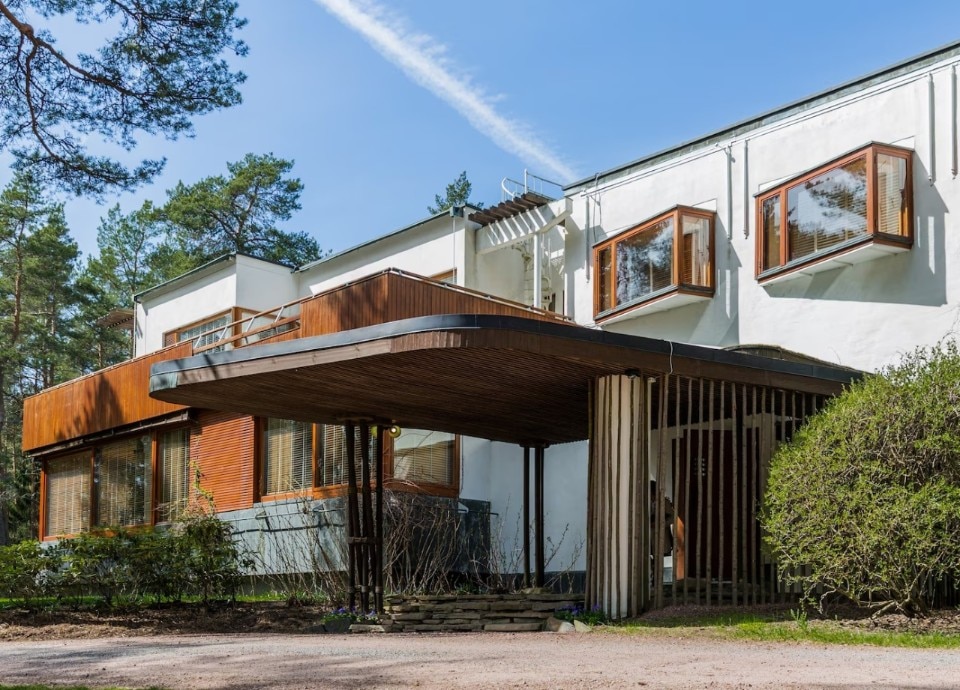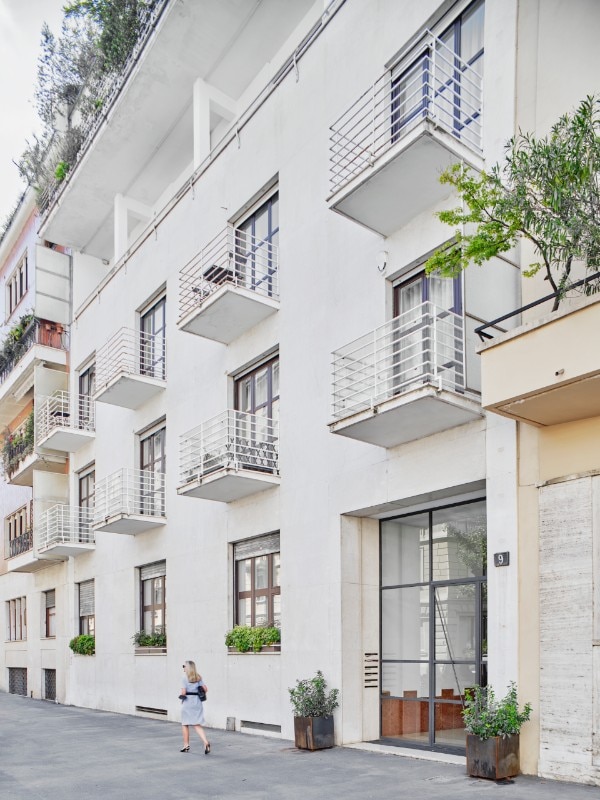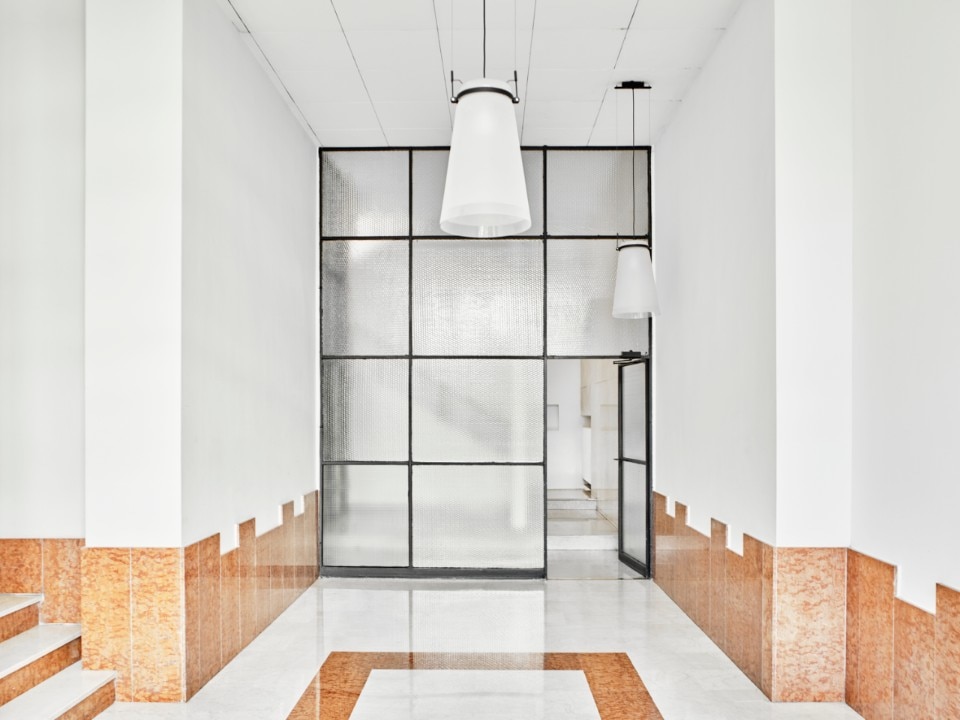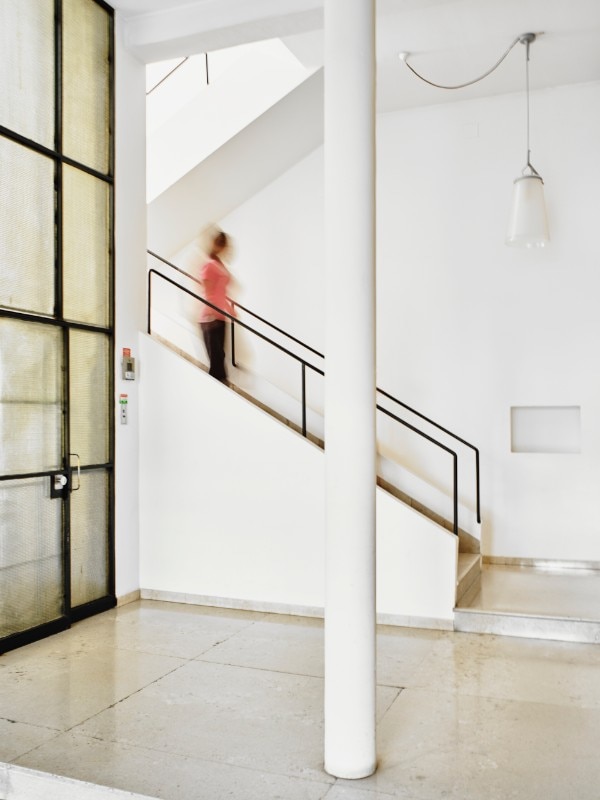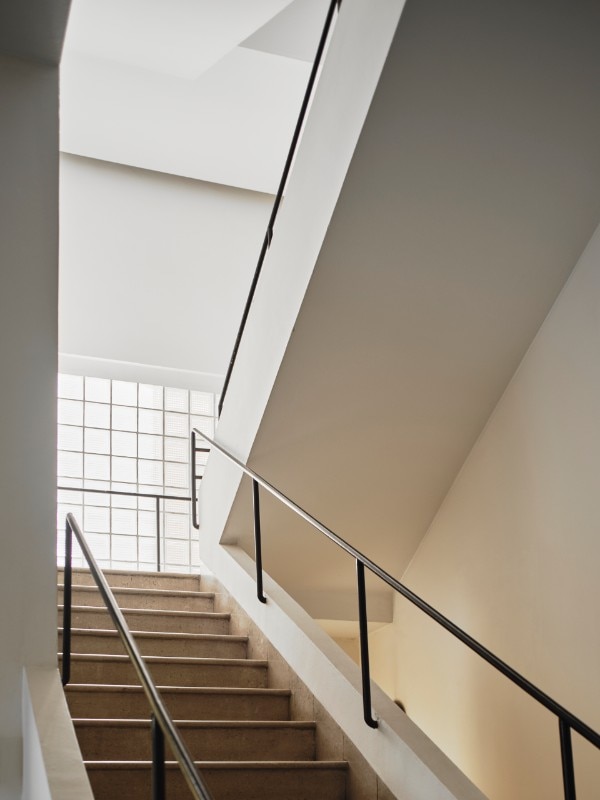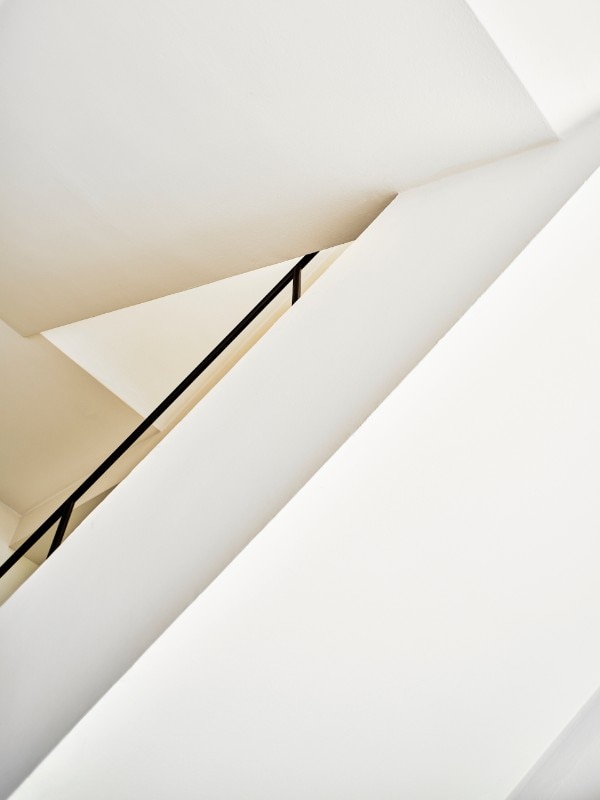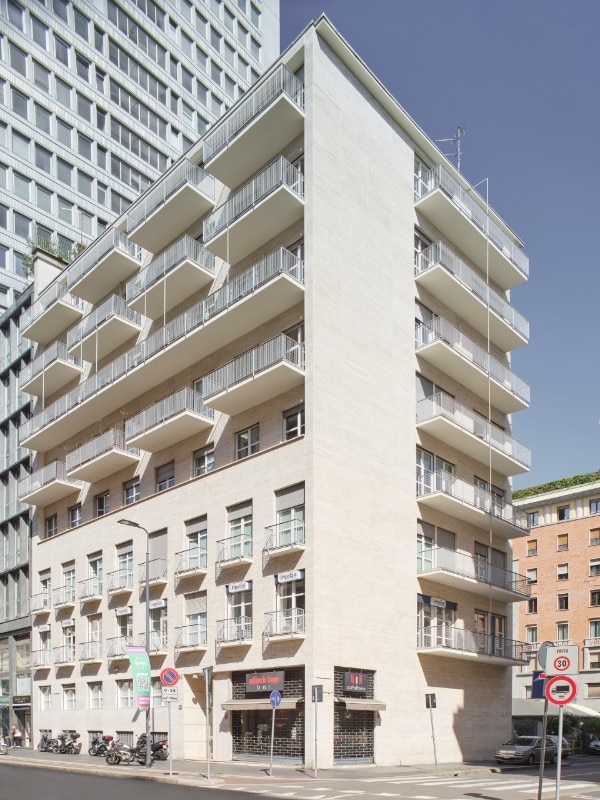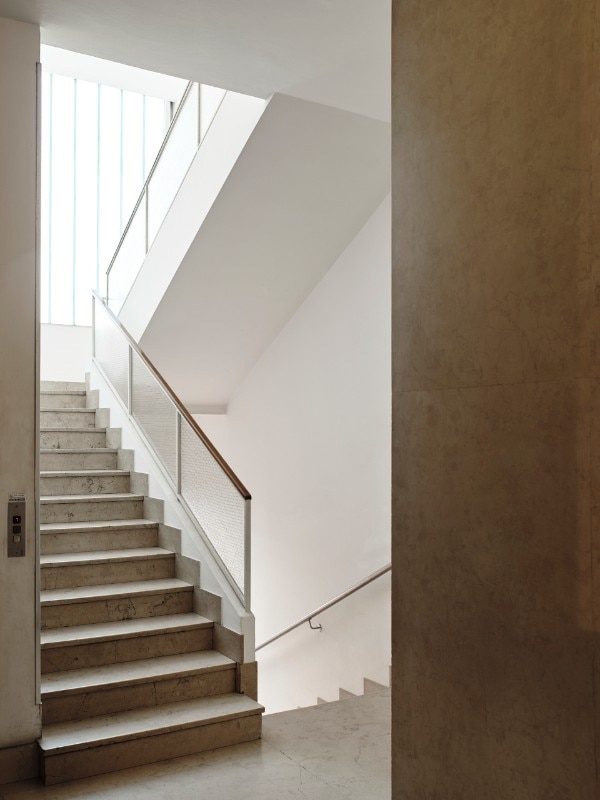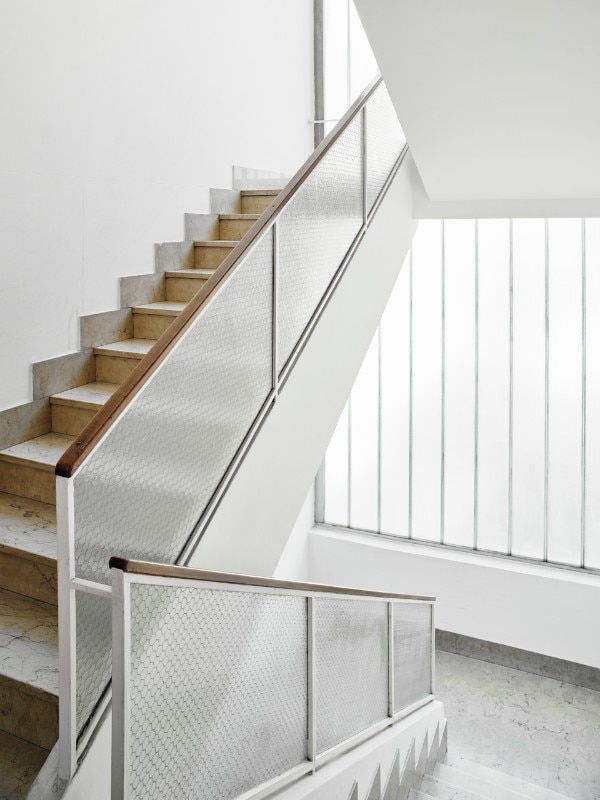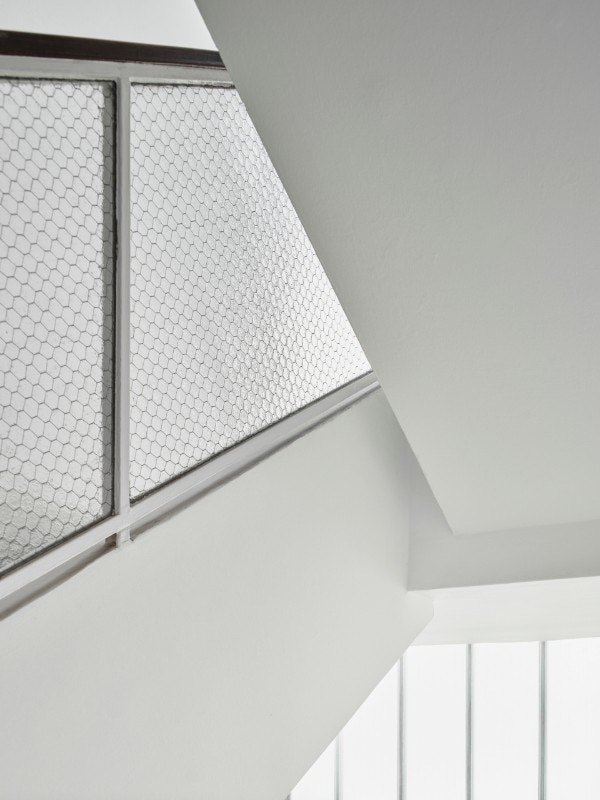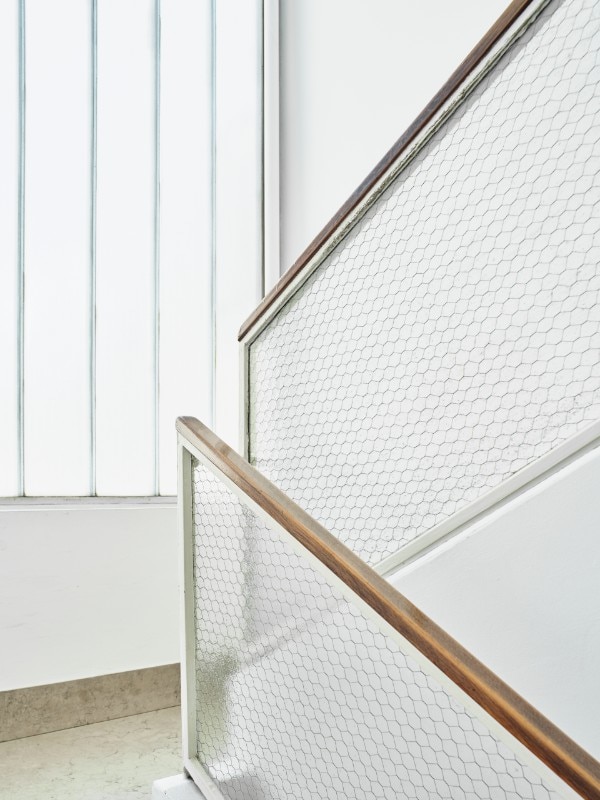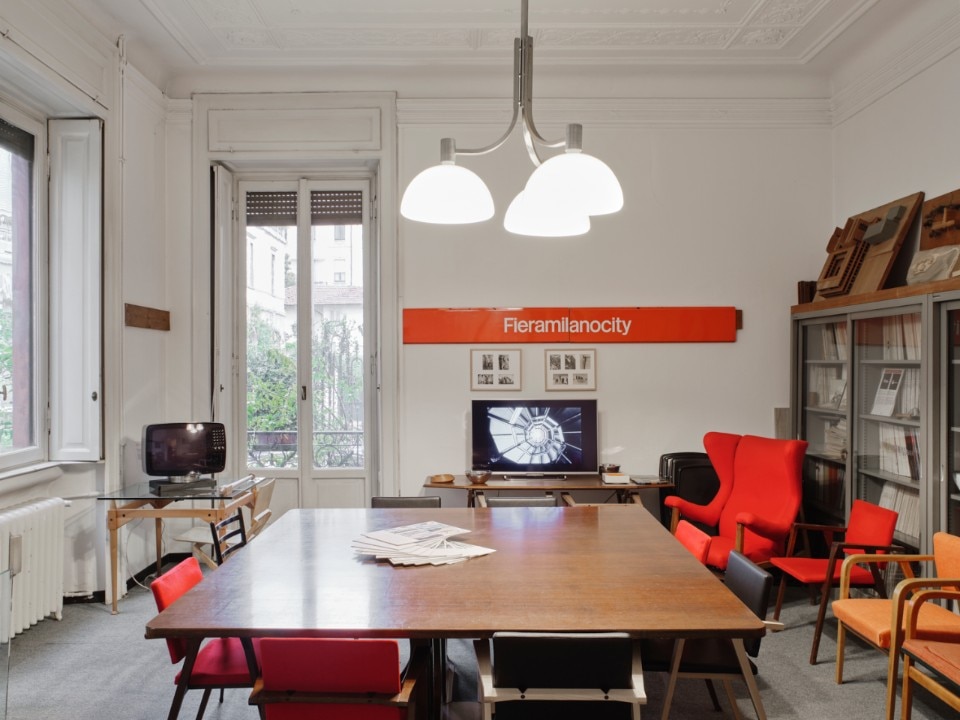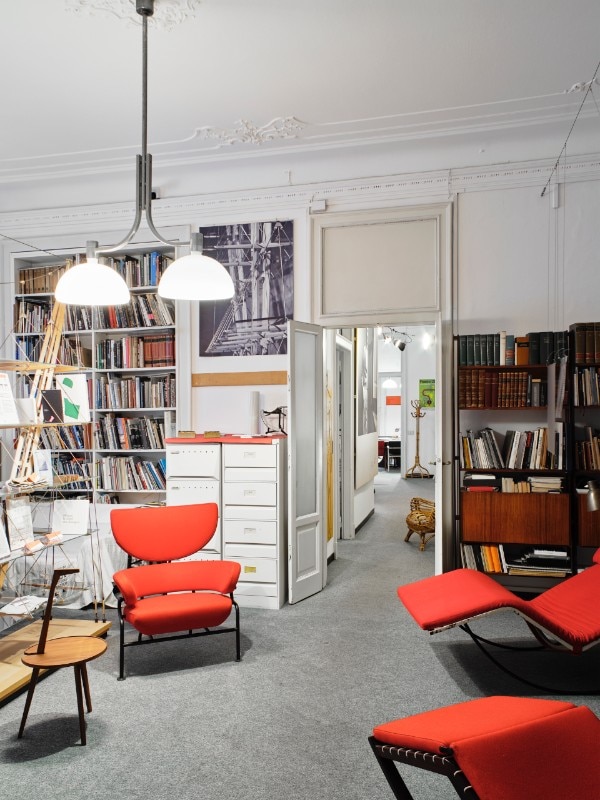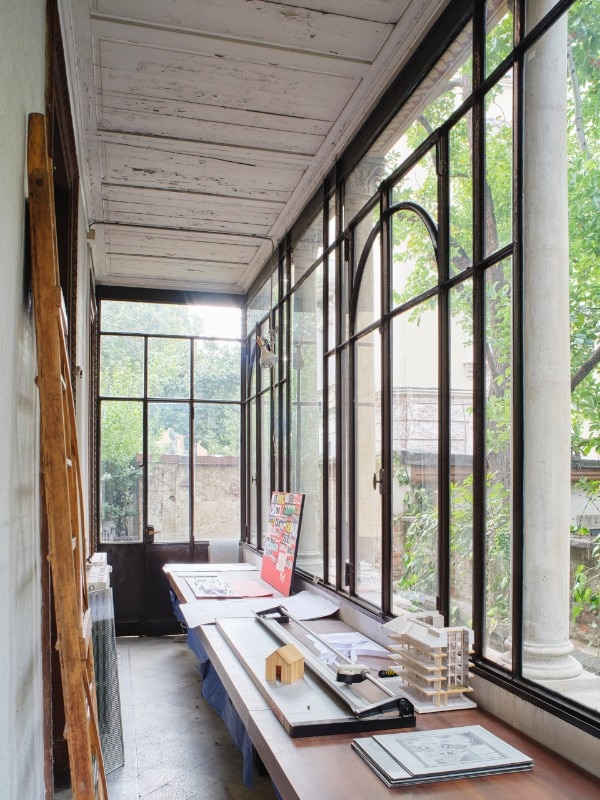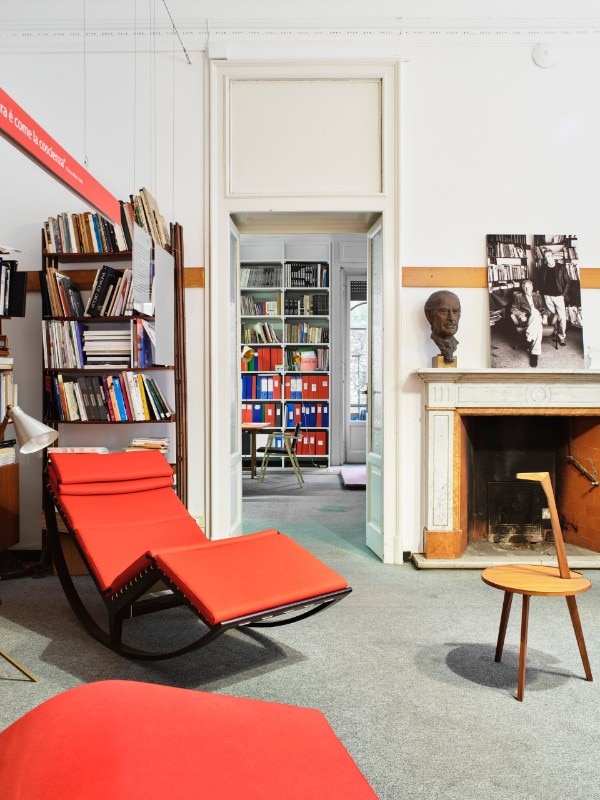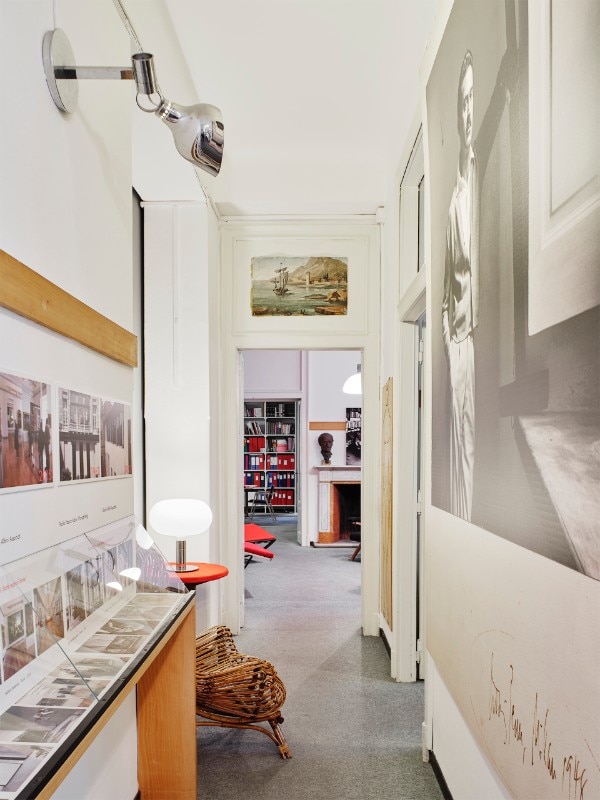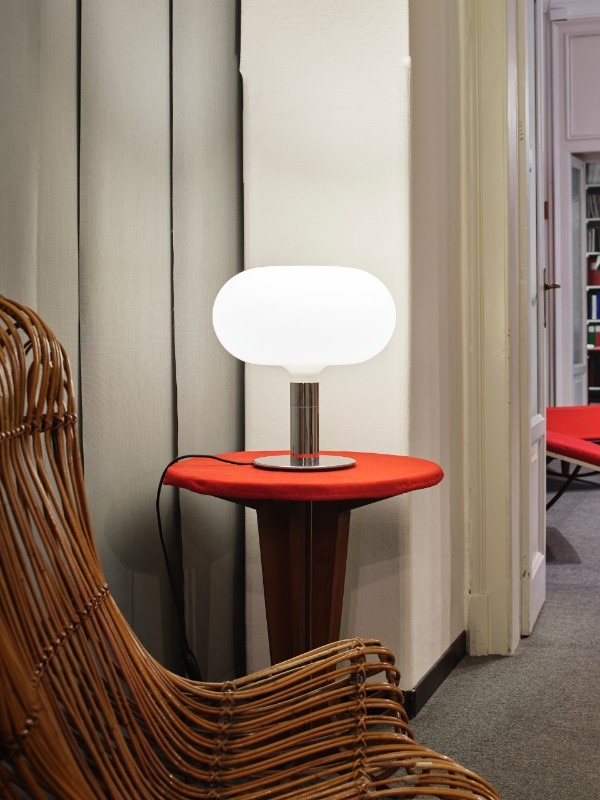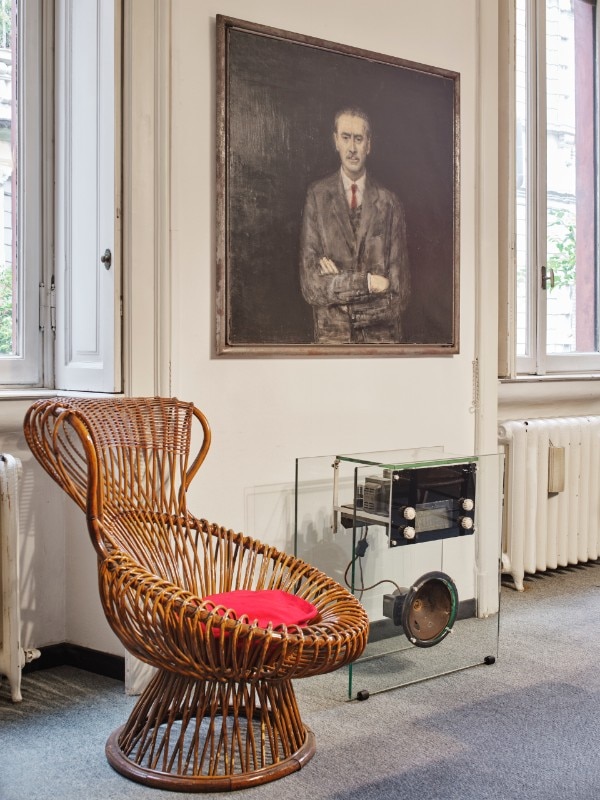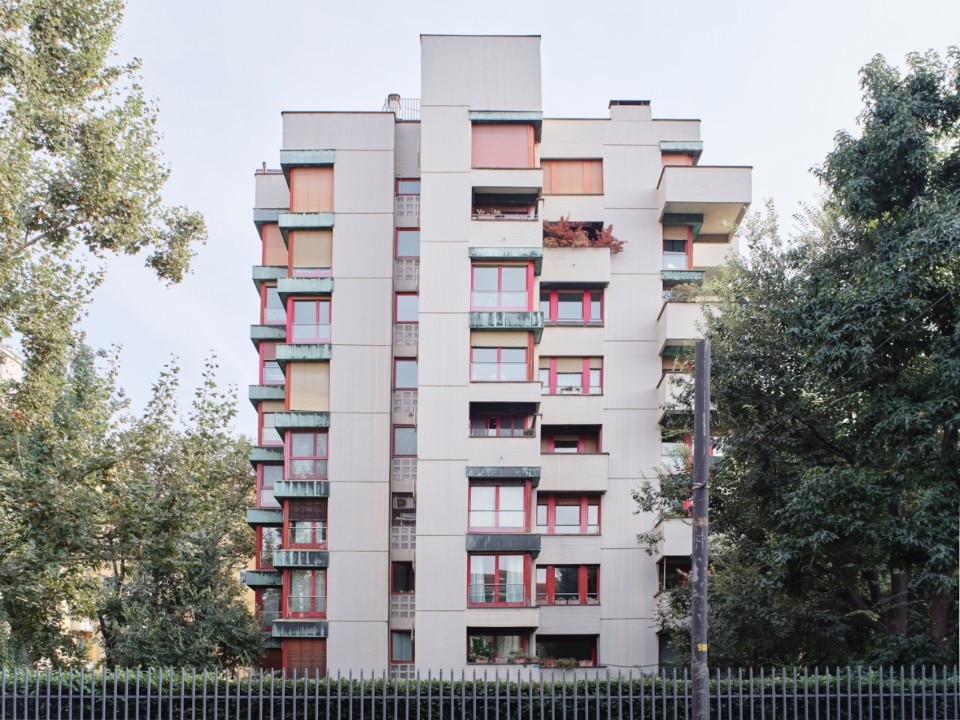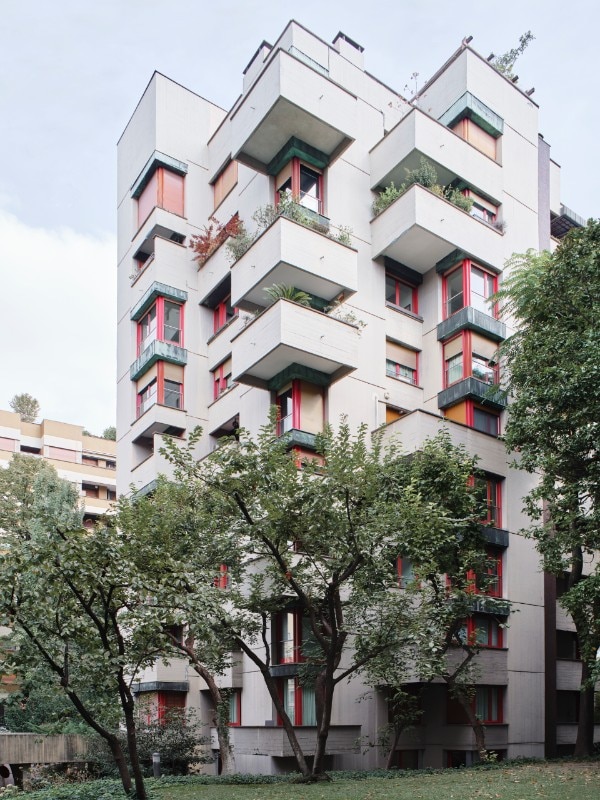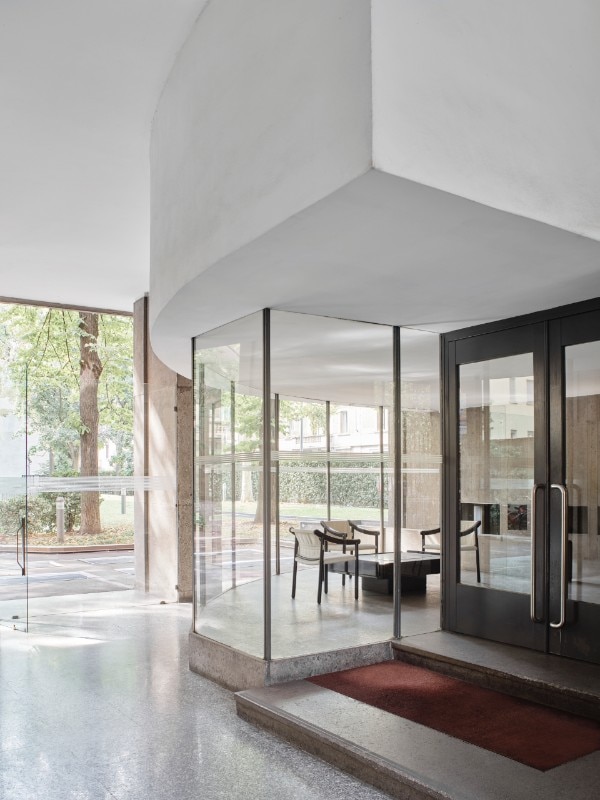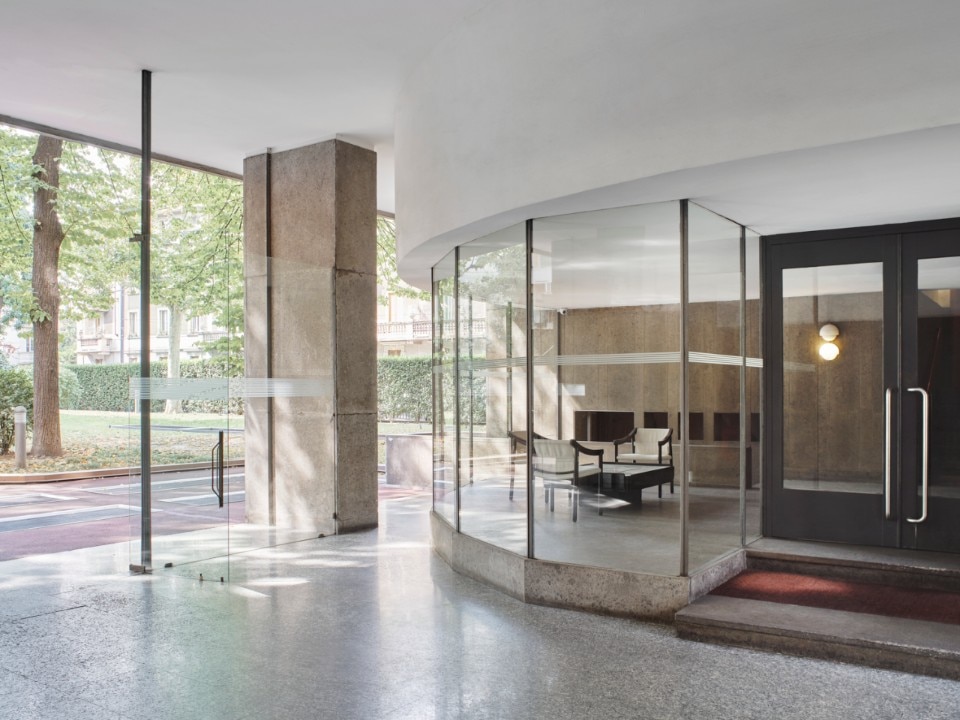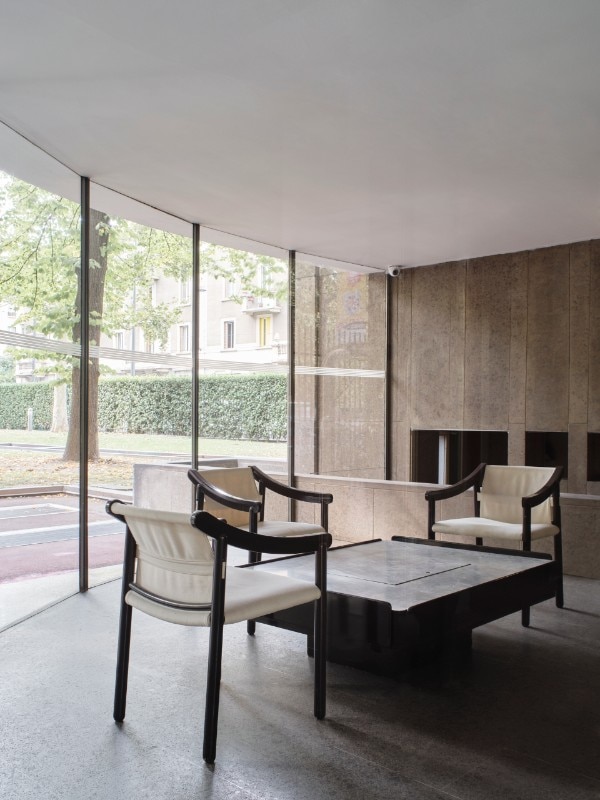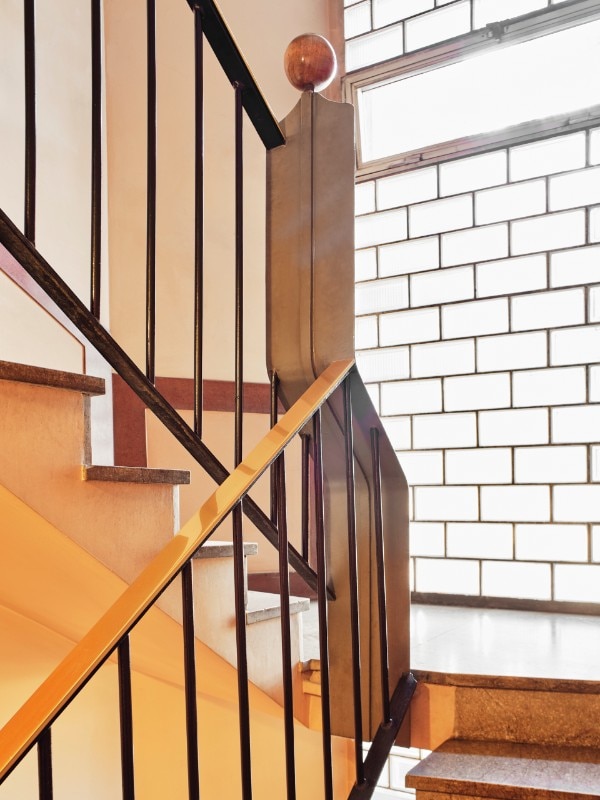by Matteo Pirola
in collaboration with Annalisa Ubaldi for archival research
“Everything is Architecture”, wrote Hans Hollein in 1968, at the height of the radical and international design movements. In the past, architecture was an art exclusively reserved for public buildings, monuments and aristocratic palaces, so the simple houses were hardly ever involved in the projects that have made the history of architecture, even though it is common knowledge that there also exists, especially for this archetype, an “architecture without architects”, as Giuseppe Pagano and Bernard Rudofsky taught us.
The rise of “modernity” in history, as well as bringing about countless technical and artistic revolutions, began to recognise new opportunities for architecture destined for the private life of a nascent bourgeoisie. So, although everything is indeed (potentially) architecture, and since we could only choose works published on Domus, the selection was not dedicated to the more traditional types of public design, such as churches, museums, stations, libraries, theatres, schools, etc., but it rather focused on the specific typology of the home, i.e. the architecture of the private sphere, intended as the preferred place to live in.
Navigating, or rather plunging into the wonderful gold mine that is the Domus archive, we tried to identify the most interesting and innovative domestic architecture, among those most in tune with the spirit of the times and the near future of architecture at the time, in an interesting retrospective view with a contemporary twist. It is a selection of “relative absolutes” that does not aspire to be comprehensive.
Throughout its history, Domus has succeeded in publishing outstanding works, quickly and with the refreshing quality of cultured and inquisitive information. Using an ideal “time machine” - that is, the archive - these 50 houses are for the most part works by budding designers at the time of publication, discoveries by gifted young designers, signalled by the magazine as soon as they carried out the first successful projects in a career that is now part of history.
The order reflects a chrono-typological-thematic succession, in rapid treatment of a complex context, with common threads that intertwine within parentheses that open and close, leading the discourse up to the latest acknowledged excellences that Domus managed to spot as soon as they blossomed. In this sequence, there are groupings by research themes, geographic areas, and elective affinities, as well as some focuses on Italian architecture based on the syntony and relationships among the authors.
After all, even the name of the Domus refers to the house, a type in which it is always possible to find extraordinary works - which, thanks to architecture, become ordinary - of this modern art of space.
01
Ludwig Wittgenstein (with Paul Engelmann)
Haus Wittgenstein, Vienna (Austria), 1925-28
Domus 517, December 1972
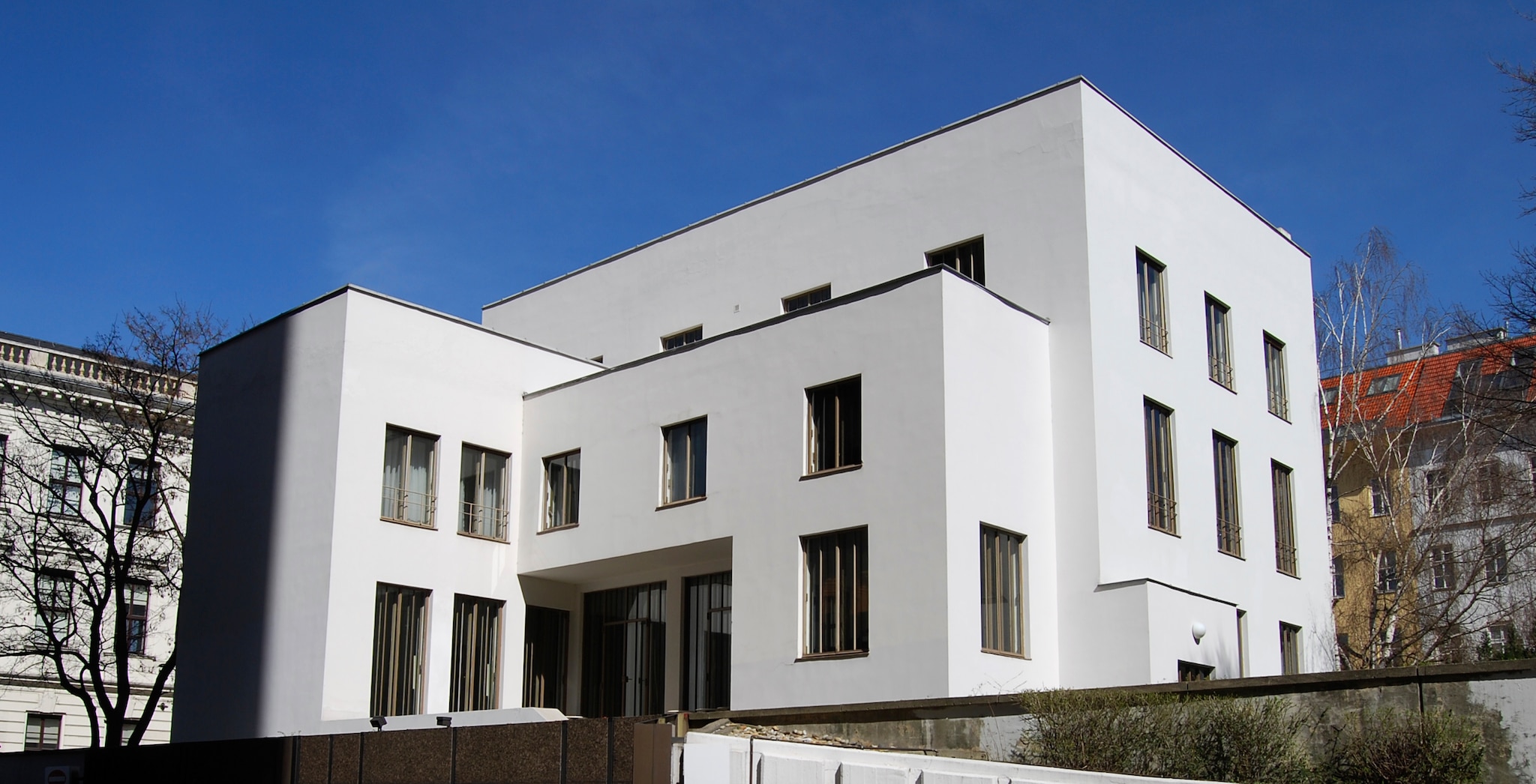
This house, designed by a philosopher and considered an architectural sensation, indirectly contributed to the theories of the new Modern Architecture that, from Vienna and Paris, was influencing all of Europe. After writing his Tractatus Logico-Philosophicus, Wittgenstein designed a house for his sister as an exercise in logic and imagination applied to everyday practical verification, as well as a way to defeat the existential crisis he was undergoing. He used rigorous criteria of rationality and followed a process of reduction to achieve the utmost “simplicity” where technique, aesthetics and ethics balance each other out and become the three points of a single ideal and real plane.
Opening image: Aldo Ernstbrunner
02
Eileen Gray
Maison en Bord de Mer, Roquebrune-Cap-Martin (France), 1927-29
Domus 469, December 1968
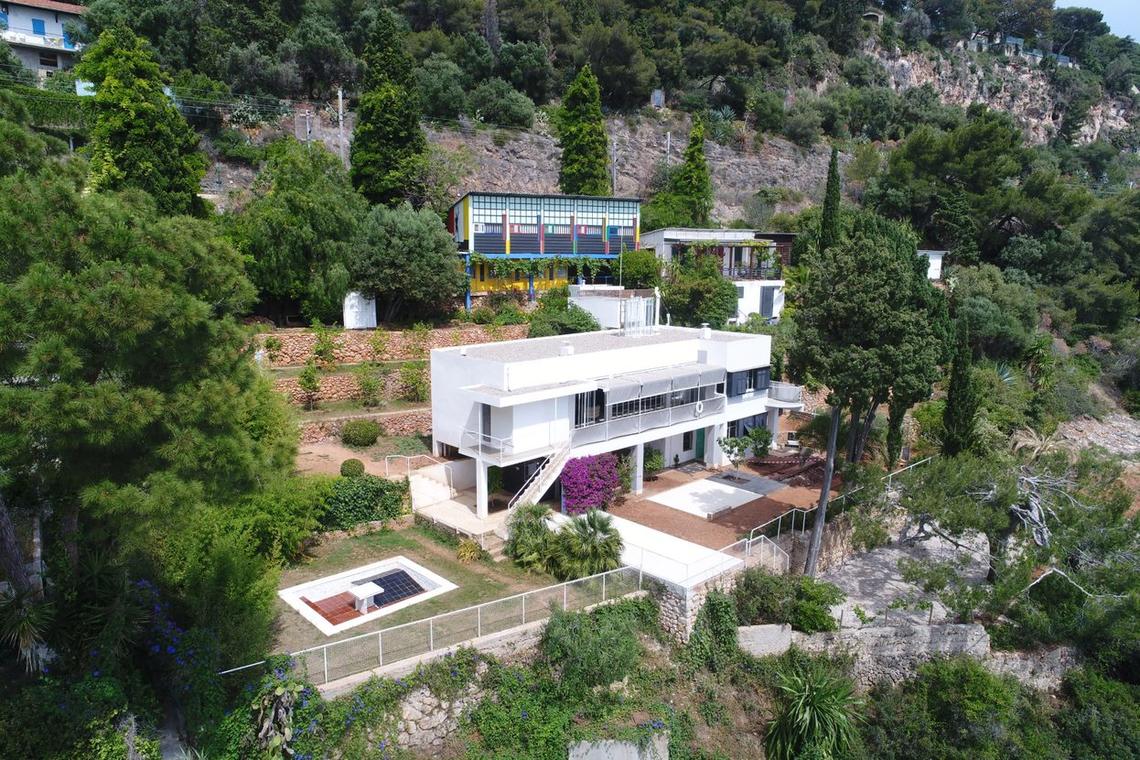
One of the only two houses that Eileen Gray built for herself stands on a beautiful site that is now called Cap Moderne. It is a manifesto of a Modern Architecture in essence, written by one of the first - free, autonomous, and daring - women designers who managed, despite some personal vicissitudes that later affected her career, to be admired by the whole world after being forgotten by everyone. This house, enigmatically called E1027, is a total work of art, where the single, continuous space contains everything - equipment, furnishings, accessories, systems, information - and everything was coloured and designed by one of the most innovative and hidden minds of 1920s Europe.
Opening image: Manuel Bougot
03
Giuseppe Terragni
Novocomum, Como (Italy), 1928-29
Domus 28 aprile 1930
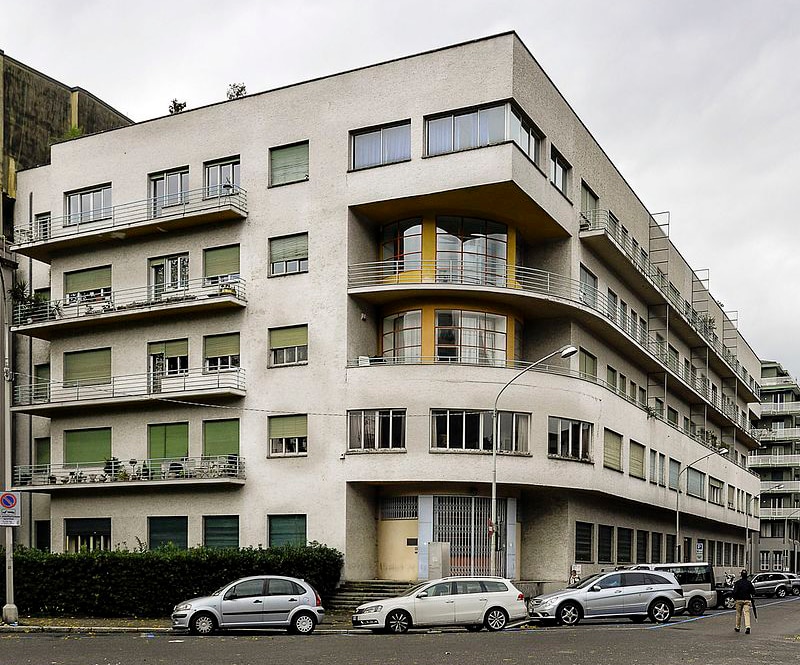
In Italy, a group of 7 young architects renamed Modern Architecture and called it Rationalism. Thanks to this first multi-storey residential building designed by an extraordinary young architect from Como, the foundations of this movement were laid for a clear, lasting, and internationally significant period. The volumes started to become purer and to design a new city, with the bright interiors seeking a relationship with the outdoors and, in this case, with the lake, which is only a few metres away. A new order was established according to a logic of use, construction, and abstract aesthetic, made concrete by technology and habitable by a new vision of modern life.
Opening image: Giuseppe Albano
04
Asnago and Vender
Apartment building, Milan (Italy), 1934-36
Domus 106, October 1936
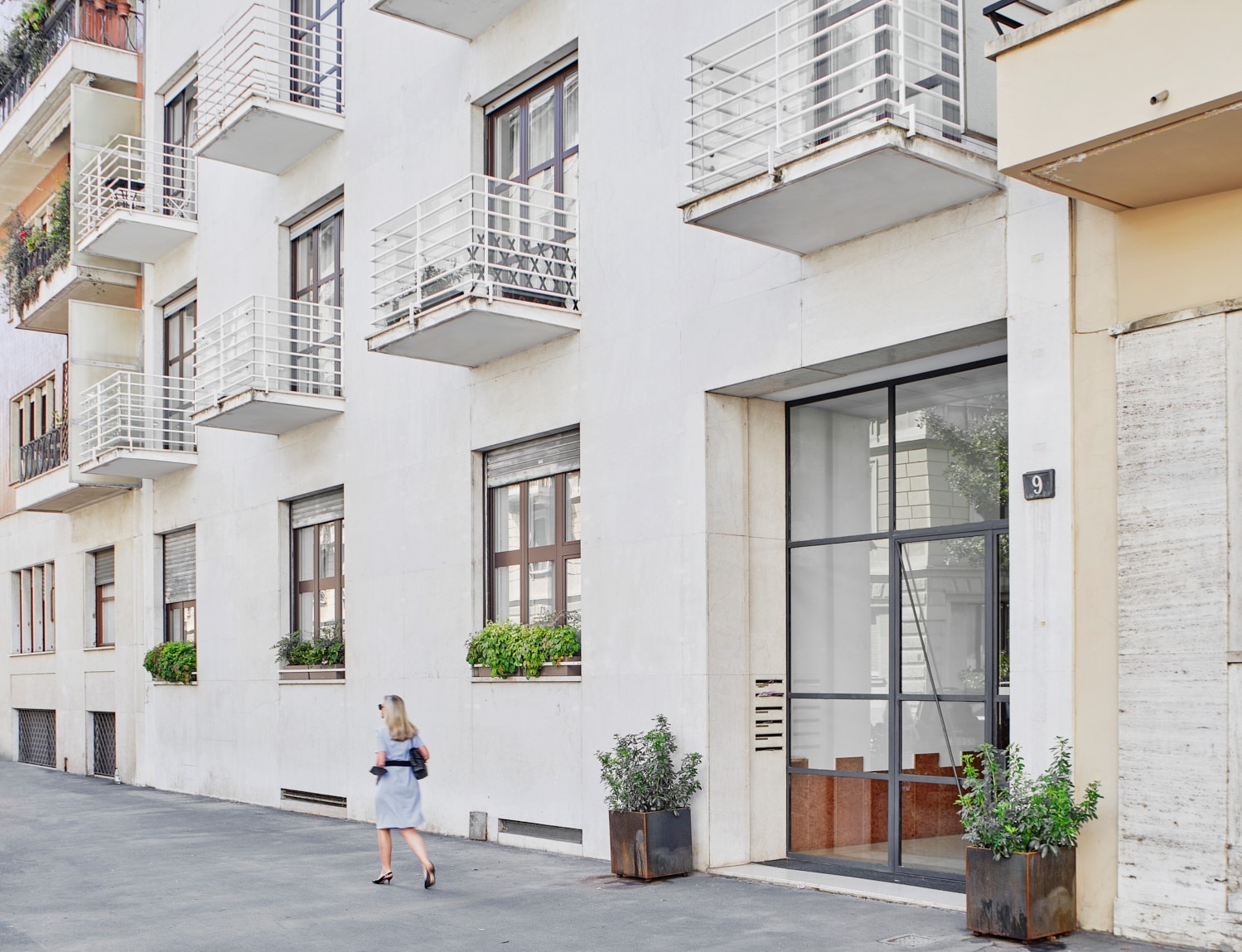
 View gallery
View gallery
Today, Asnago and Vender are still considered cult authors for their urban projects for multi-storey apartment buildings, and although their masterpieces are hidden around the busy city, they occasionally shine through. In the mid-1930s, having embraced the purest rationalist ideals, the architects worked towards the highest expression of architectural clarity with a language that refused any rhetoric and where each element stood out and was shown for what it was, in a complex simplicity aimed at “schematizing without drying up”. In addition to the logically enclosed spaces within the apartment building, for a healthy domestic life, the focus was put on the communal and open spaces, the roof, and especially the balconies, terraces, and walkways, where the Milanese tradition was reinterpreted, redesigned and updated according to the spirit of the times.
Opening image: Marco Menghi
05
Luigi Figini
Villa Figini, Milan (Italy), 1933-35
Domus 99, March 1936
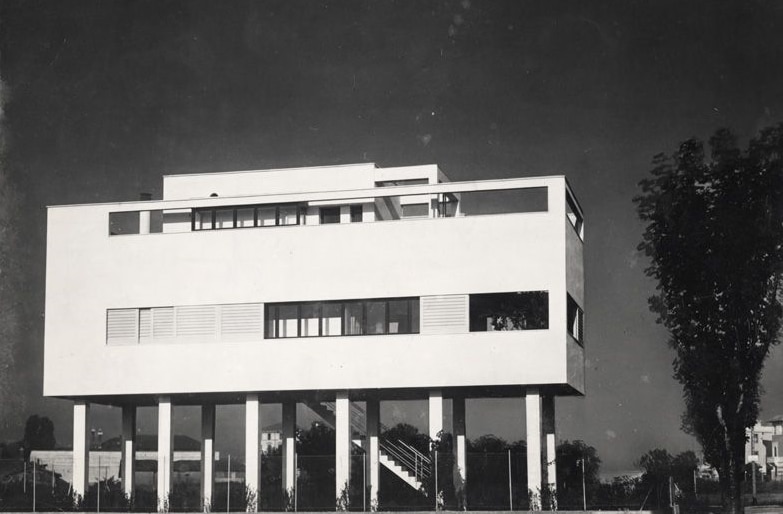
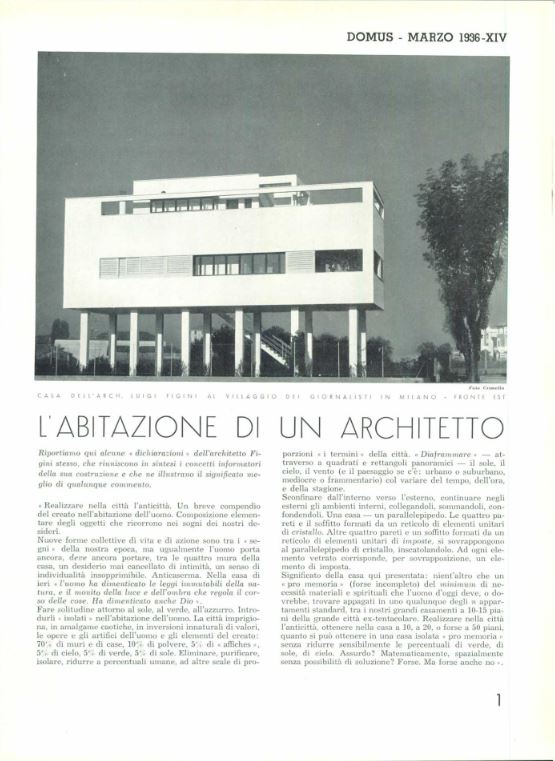
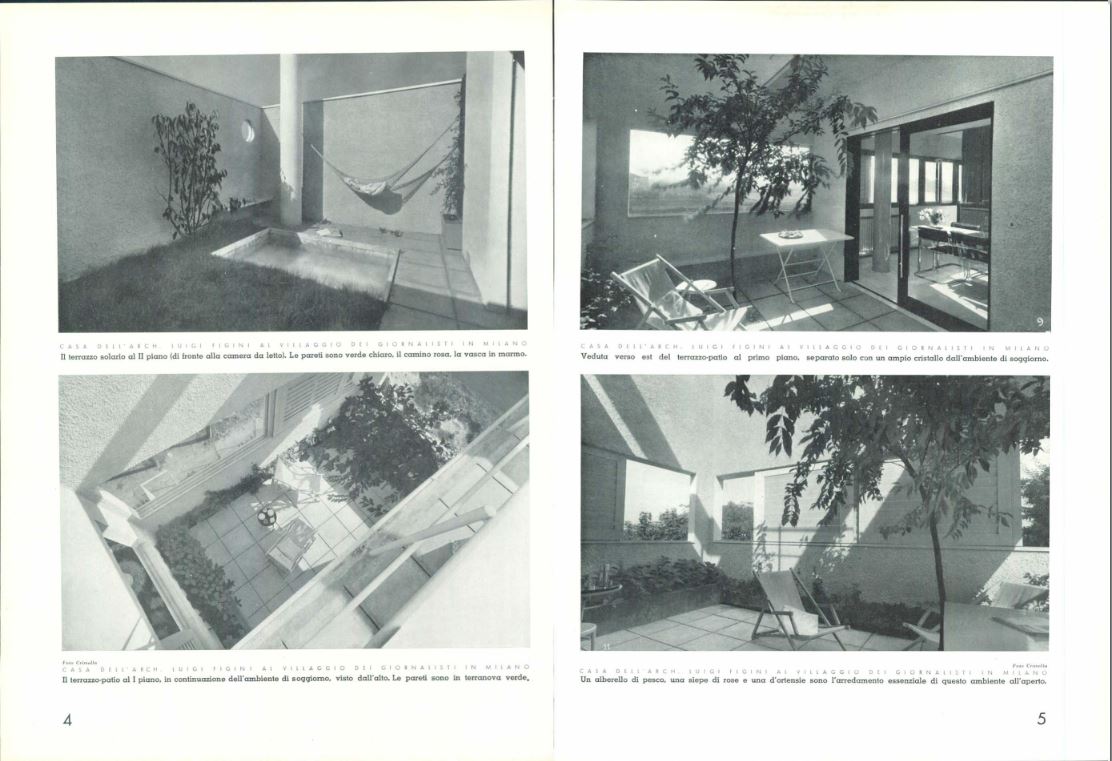
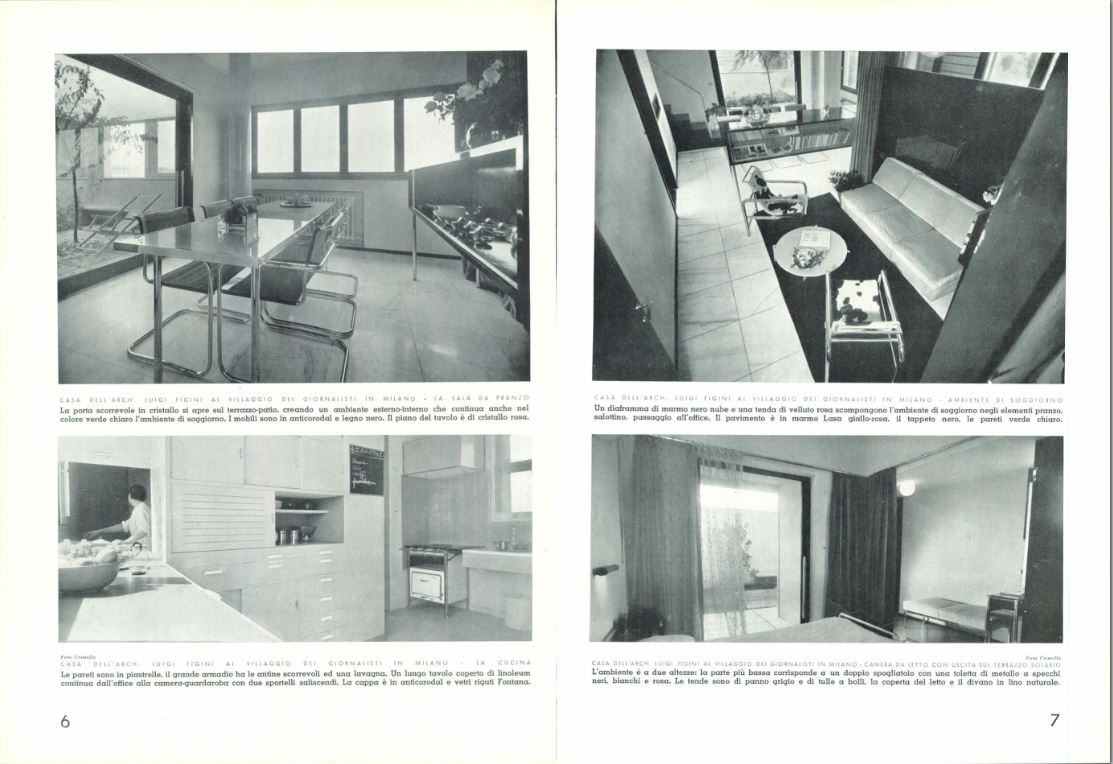
The architect Luigi Figini programmatically implemented Le Corbusier’s five points of architecture, which had been established a few years earlier, in his own house. The house is a direct homage to the better-known Parisian Ville Savoye, with a surprising pure architectural volume - a parallelepiped suspended on slender stilt-like pillars - whose short side towers over the street front of the picturesque Villaggio dei Giornalisti and contains covered spaces on two communicating levels, with open views, uncovered terraces and vertical gardens. The sharp horizontal (ribbon) windows emphasise the surrounding landscape close by and the jagged profile of the Alps in the distance.
Opening image: Arbalete
06
Franco Albini
Casa Albini, Milan (Italy), 1938
Domus 143 novembre 1939
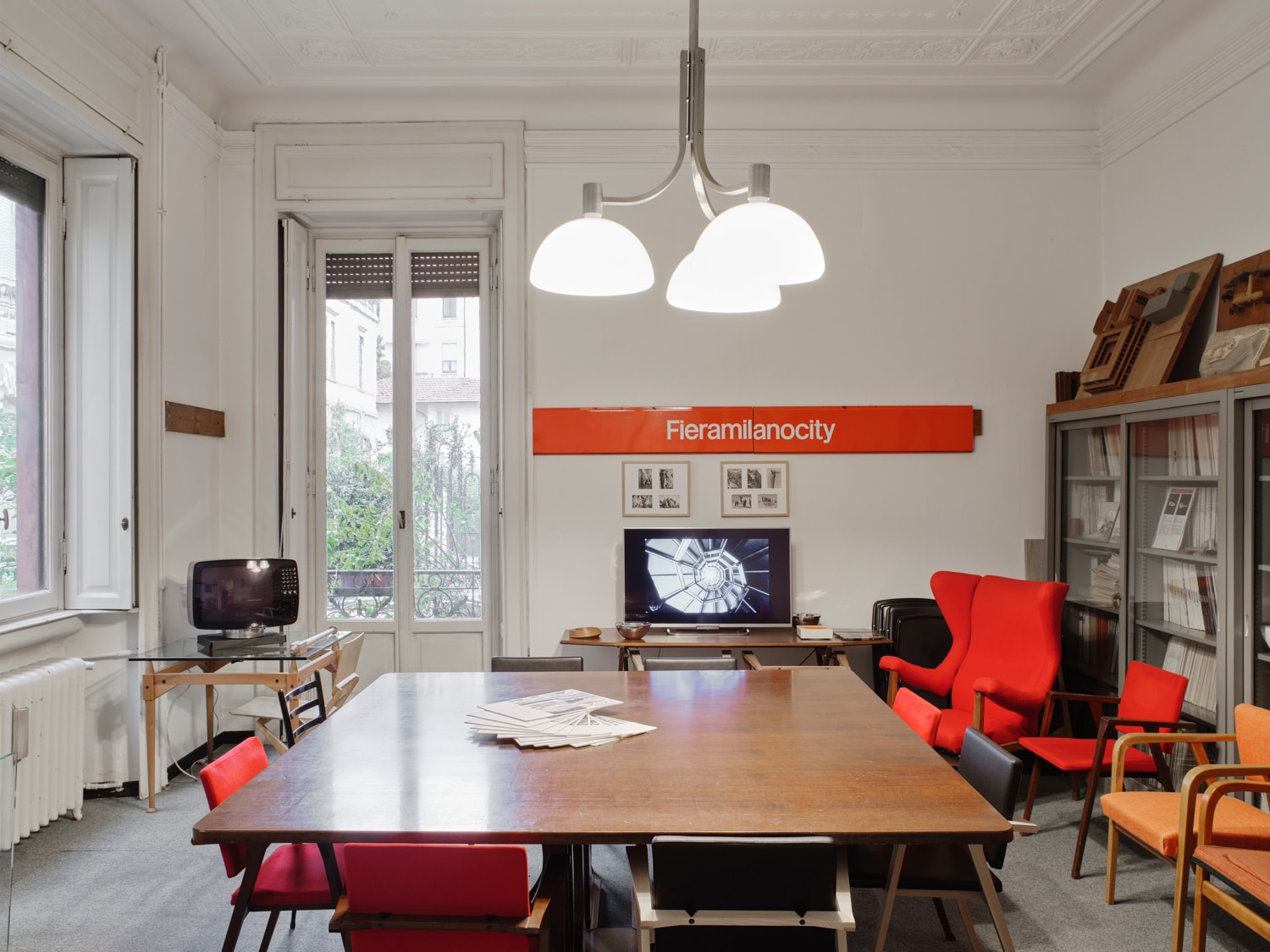
 View gallery
View gallery
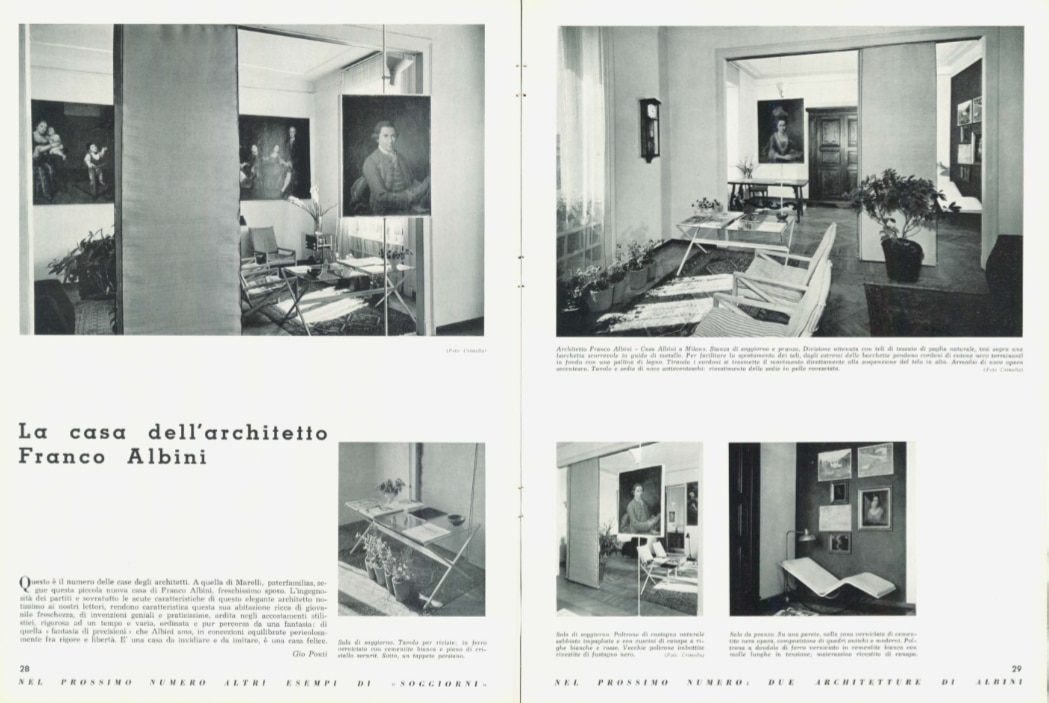
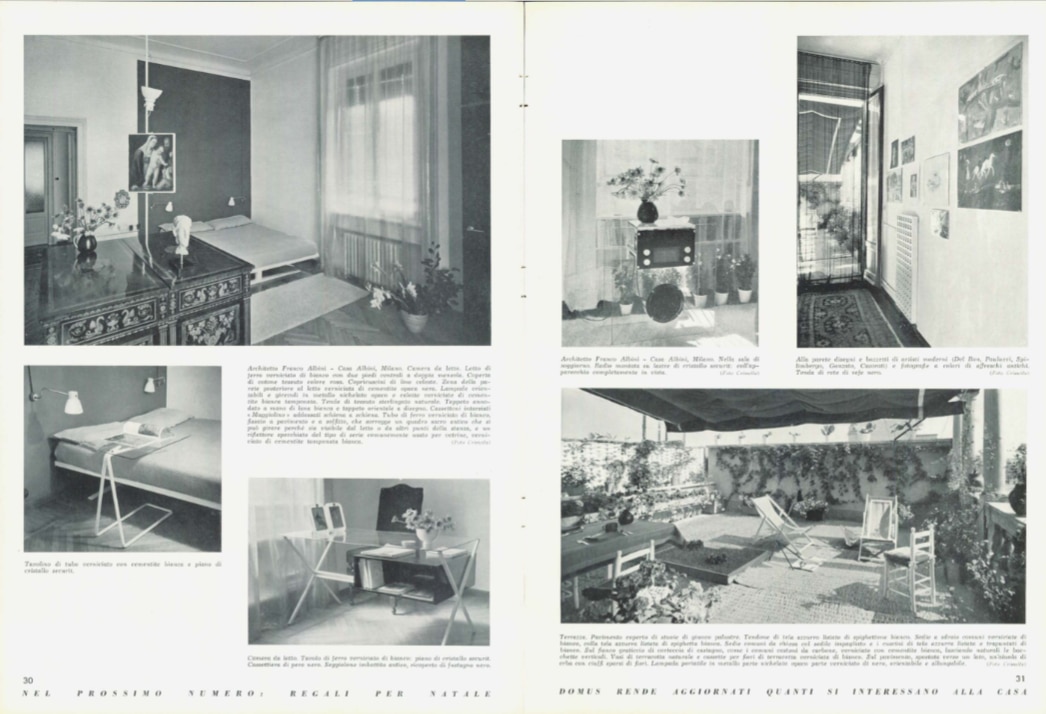
Young Franco Albini turned his new family house into a record of contemporary living and of that rationalism that, in interiors and fittings, which for the most part do not exist anymore due to their ephemeral nature, succeeded in experimenting with remarkable solutions of spatial clarity, orderly rigour and “fantasy of precision”. The interior of the flat is in one of Gio Ponti’s “typical houses”, and is characterized by the functional and slender lines of the equipment that can be used to transform and organize the space. Textile and light curtains flow and move, amplifying or remodelling the interior, while coloured material surfaces modify the proportions of the walls to obtain a spatial subordination according to the desired activities. The objects and presences create a perfect blend of antique and modern furnishings specially made by Albini with a language that produces innovative typological ideas and unprecedented furnishing solutions, such as two antique chests of drawers placed back-to-back, floor-to-ceiling poles that hold swivelling pictures and adjustable lights, the extraordinary crystal radio and the “legendary” Veliero bookcase, to name just a few inventions. Today the apartment is no longer there but it's possible to discover its objects and understand its history by visiting Franco Albini Foundation.
Opening image: Marco Menghi
07
Carlo Mollino
Casa Miller, Turin (Italy), 1938
Domus 129, September 1938
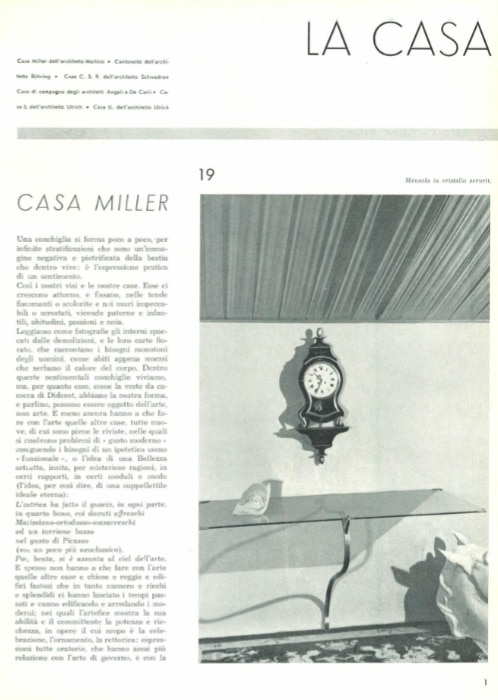
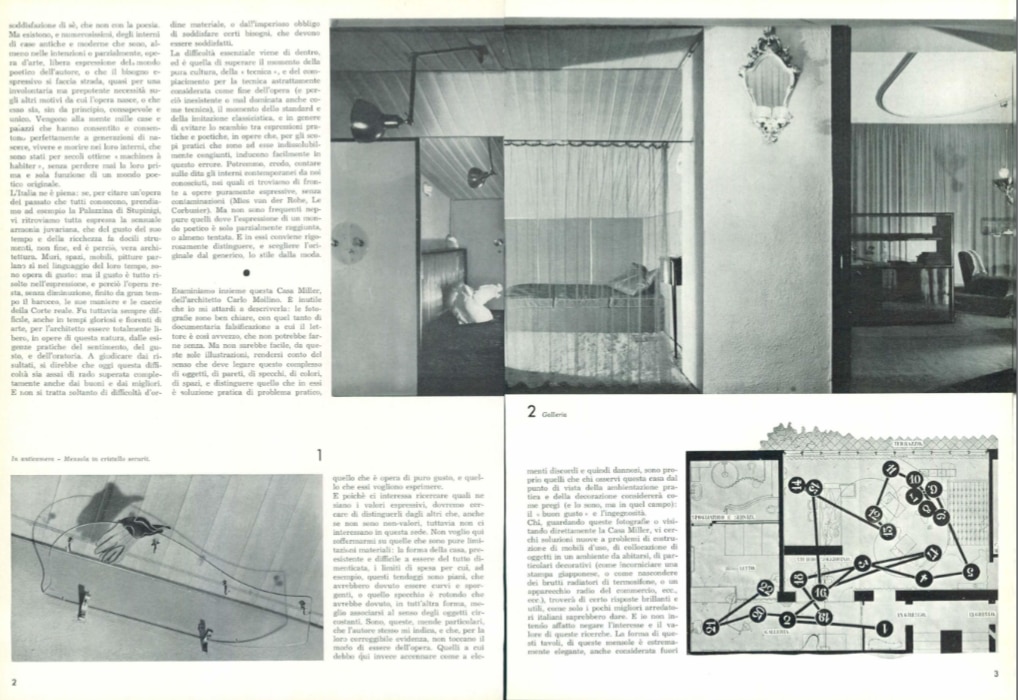
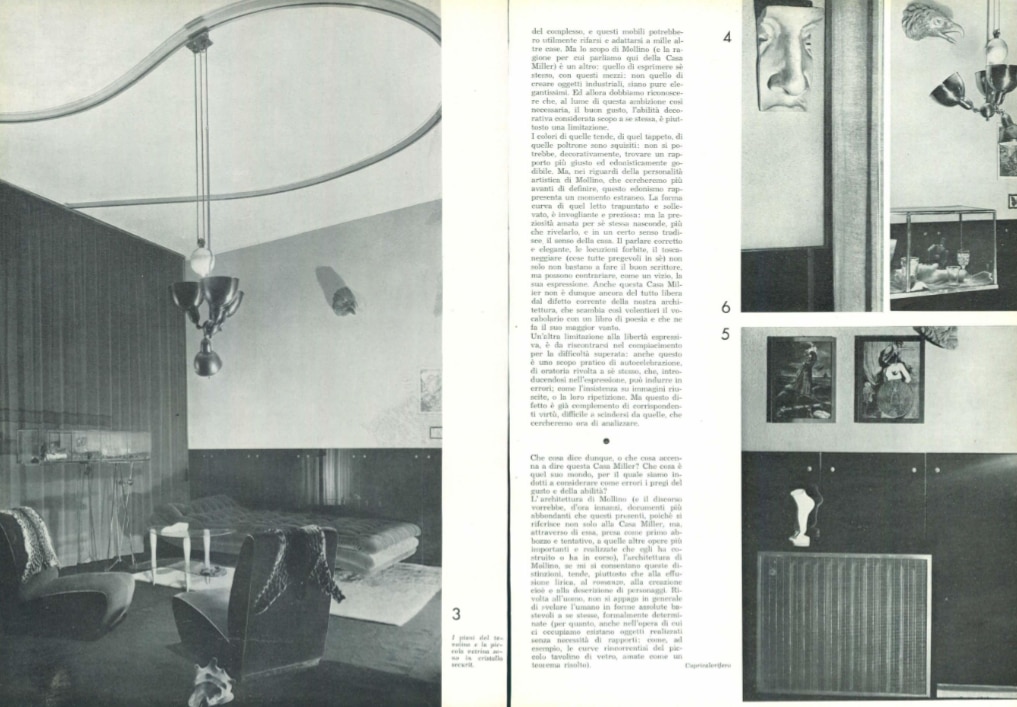
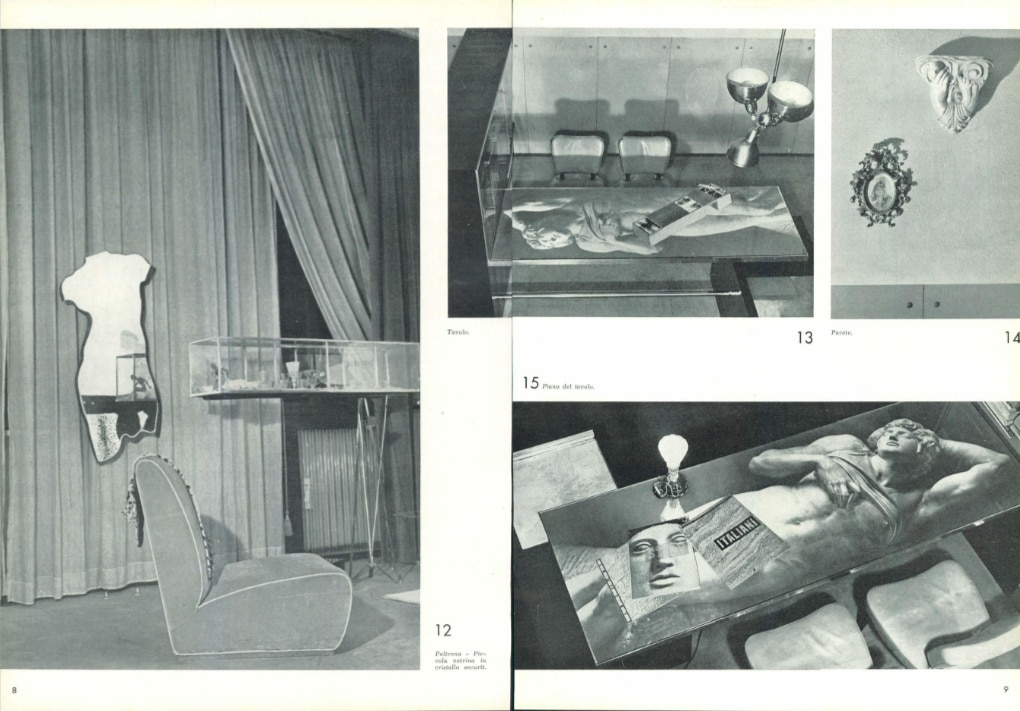
Carlo Mollino, architect, designer, engineer, photographer, writer, artist, surrealist, and much more, designed houses that develop around the stories of lives lived and, above all, yet to be lived. Casa Miller is his hidden manifesto, a home made for a phantom client that is actually one of his ways of being. Like a shell around its inhabitant, this “dwelling” is a whole interior, a fluid and dense environment made up of a complex constellation of works, images, objects, furnishings, walls, filters, mirrors, colours and spaces in which ideally practical and other purely expressive solutions intertwine. It is basically an expression of his own self, an author’s self-portrait house or, as Carlo Levi wrote, a house that is like “a novel [...] that is not satisfied with simply revealing the human in absolute, self-sufficient forms”.
08
Le Corbusier
Maison de Beistegui, Paris (France), 1929-31
Domus 64, April 1933
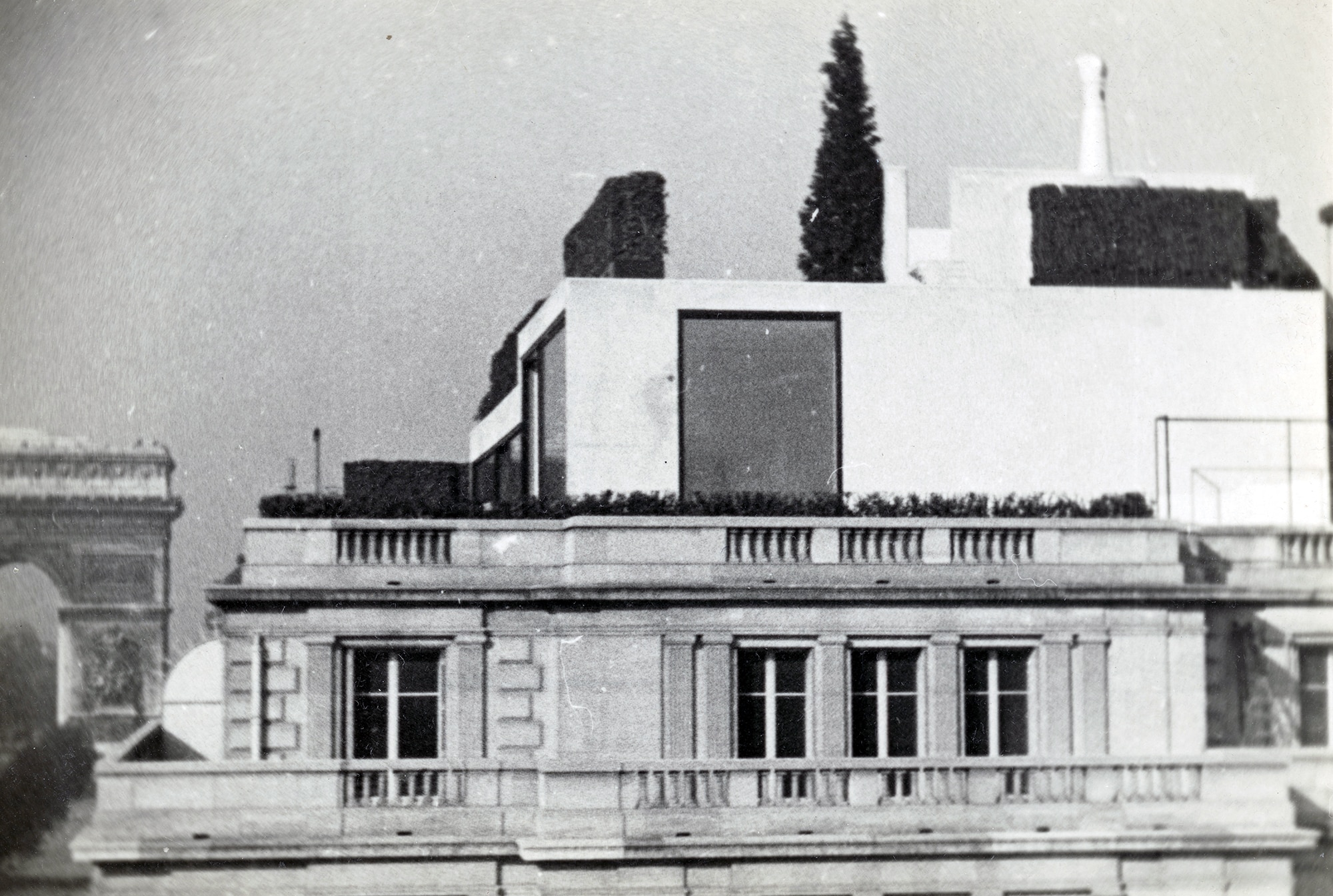
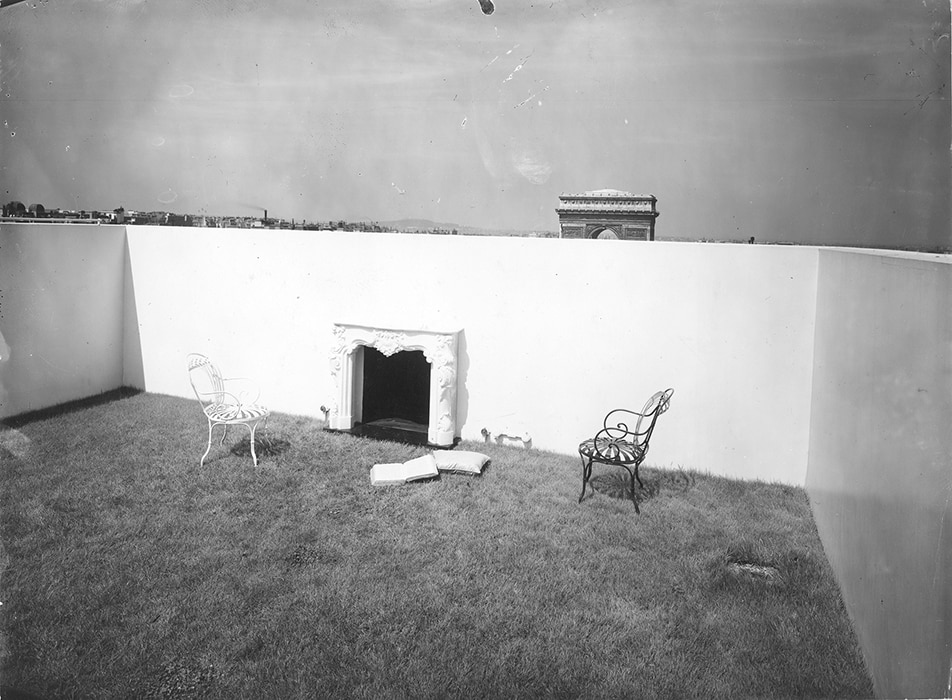
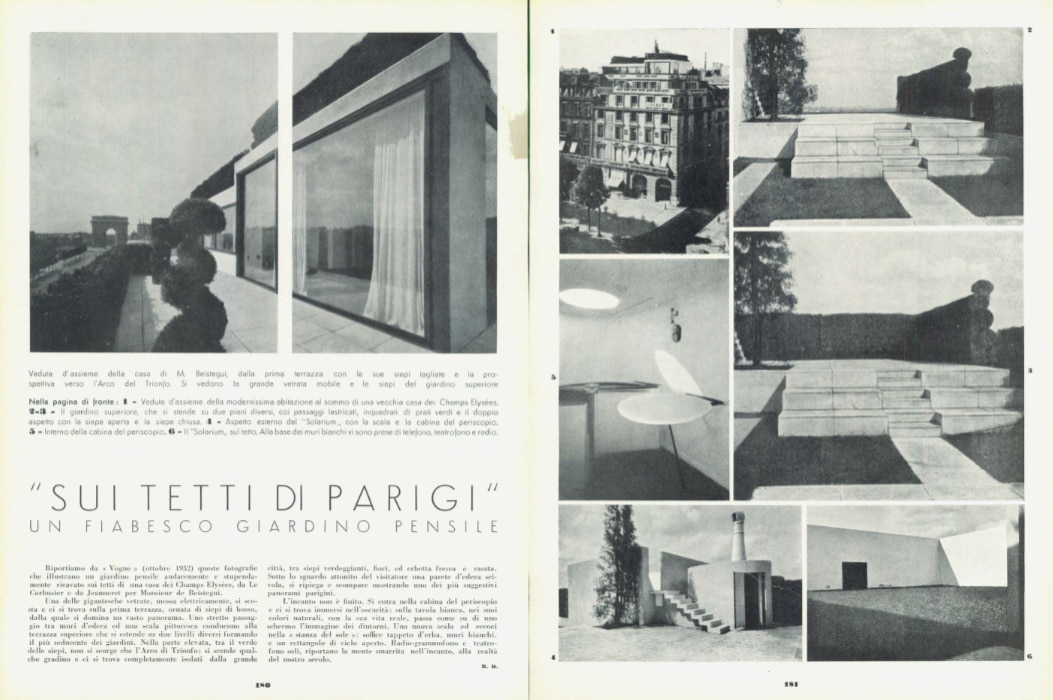
While theorising the 5+ points of Modern Architecture, Le Corbusier found design answers that historians often consider exceptions - that prove the rule - and which serve to remind us that everything was much more complex than we are told. The project is as eccentric as its client (the art collector and surrealist Charles de Bestegui) and the house was meant to be lived in as well as to host huge parties in the Paris of the roaring ‘20s. The space unfolds in an architectural promenade on several levels, in a promiscuous union of interior and exterior, open and closed, above and below, past and present, reality and dream. Amidst hydraulic mechanisms that move green walls and a camera obscura in the form of a telescope, the house culminates in the “sun room”, where a shaved grass floor is circumscribed by medium-height white walls that frame a stylish fireplace and leave the clear sky as the ceiling.
Opening image: ©FLC
by SIAE 2022
09
Pierre Chareau (with Bernard Bijvoet)
Maison de Verre, Paris (France), 1928-31
Domus 443, Octobre 1966
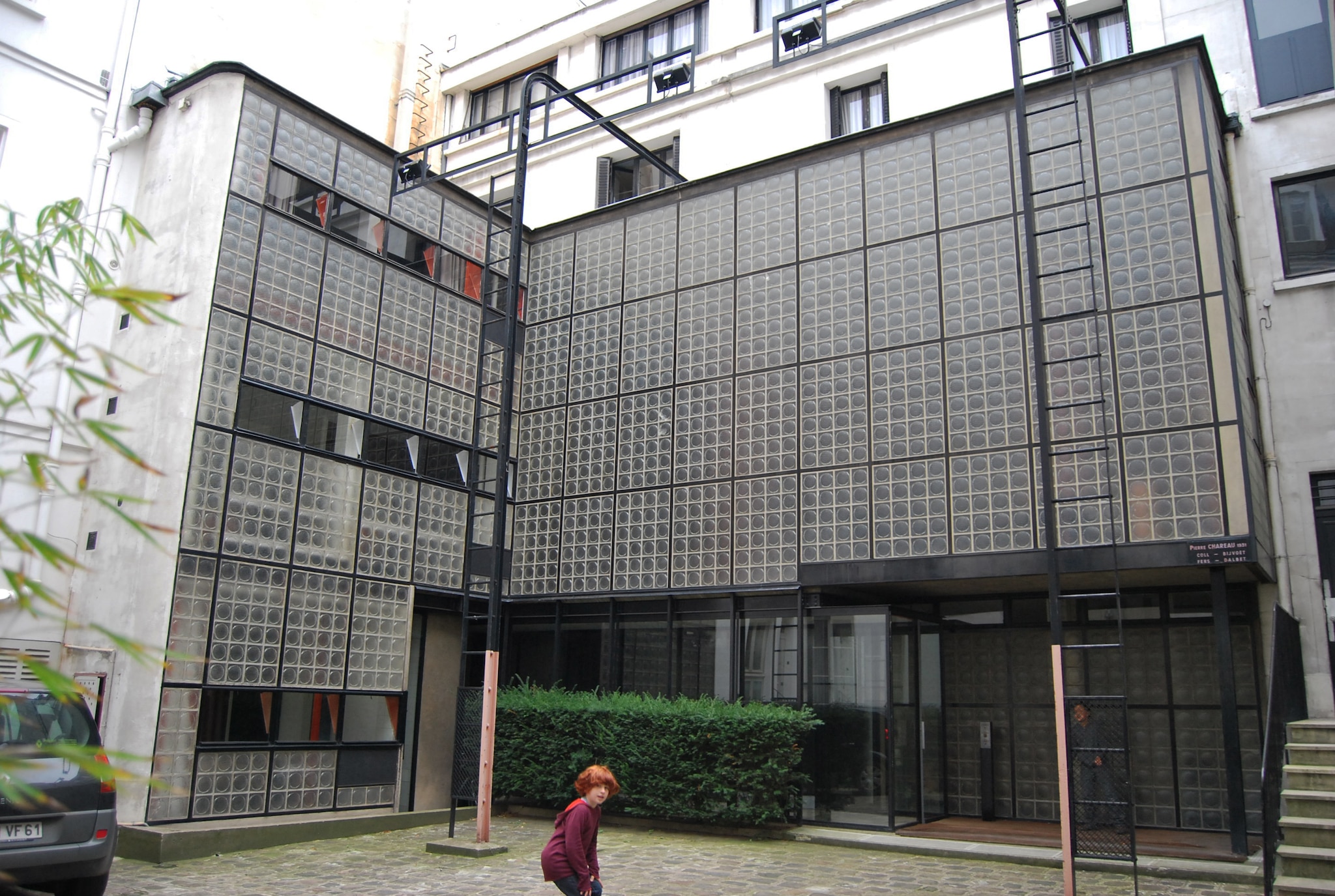
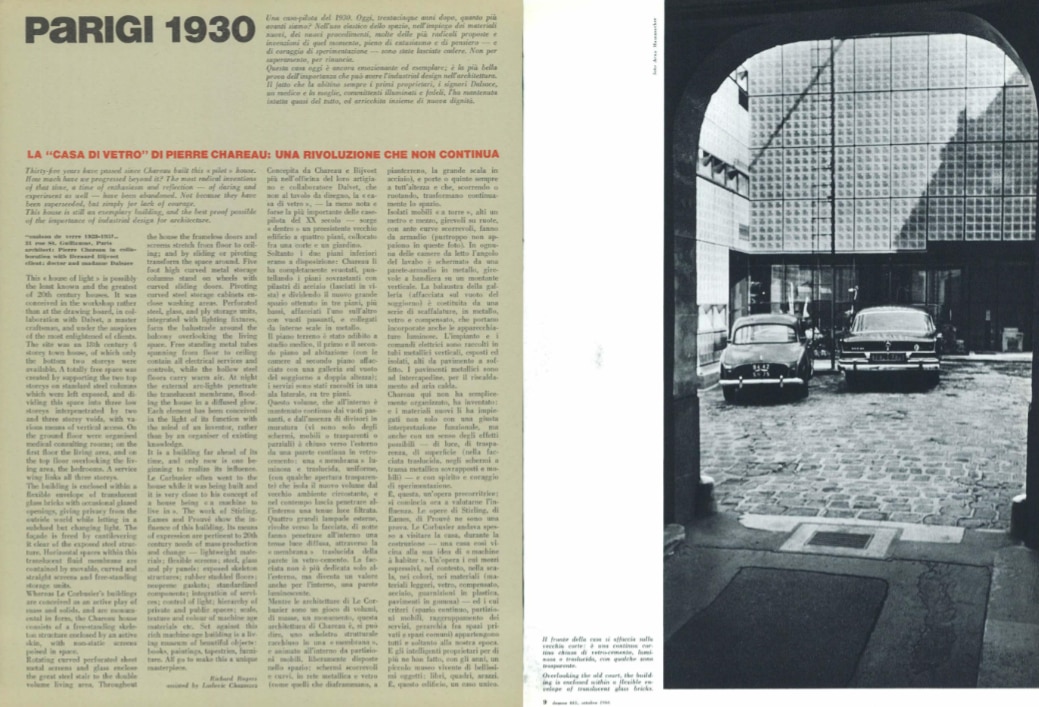
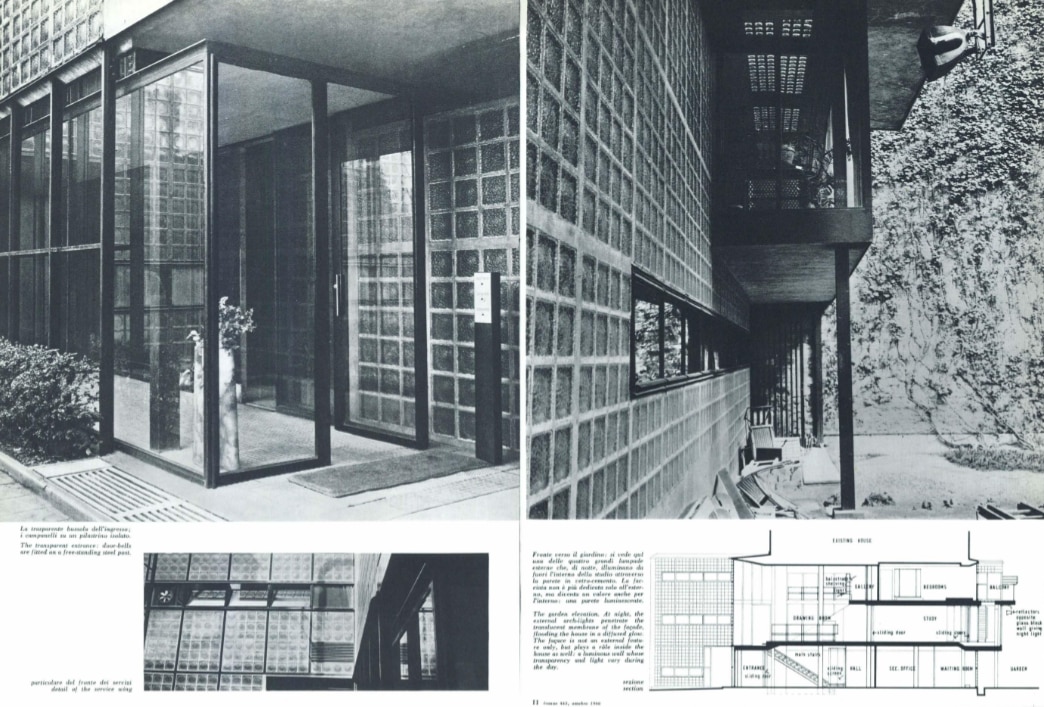
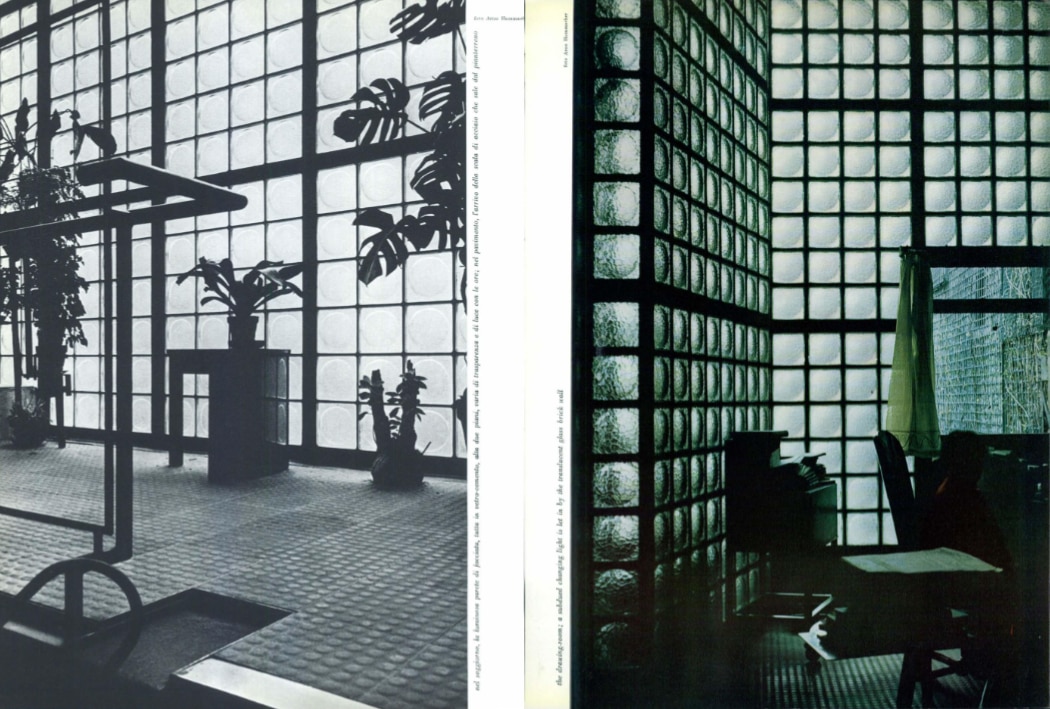
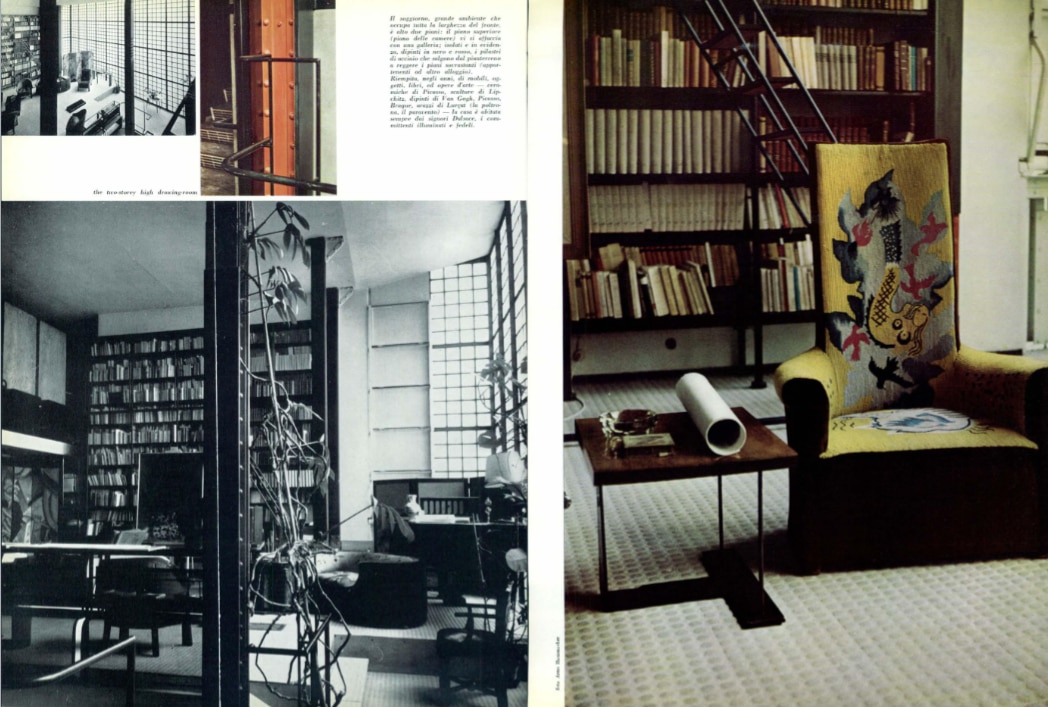
The Maison de Verre is one of the monumental architectures of a period particularly rich in innovation, transformation, “enthusiasm and thought”, where the classic idea of architecture was combined with the new concept of industrial design. The name speaks to us of a main material, glass, which is not simply transparent but, through lenticular modules, also forms the main membrane of the façades overlooking urban interiors (courtyard and garden) and determines a translucent diaphragm that filters and directs natural and artificial light (at night with spotlights placed outside). Inside, we find a new world, a clear if highly articulated and technological organism, on several floors, with various functions, heights and interconnected spaces - a dynamic theatre of equipped and mobile elements for contemporary life.
Opening image: Subrealistsandu
10
Lina Bo Bardi
Casa de Vidro, São Paulo (Brazil), 1949-51
Domus 279, February 1953
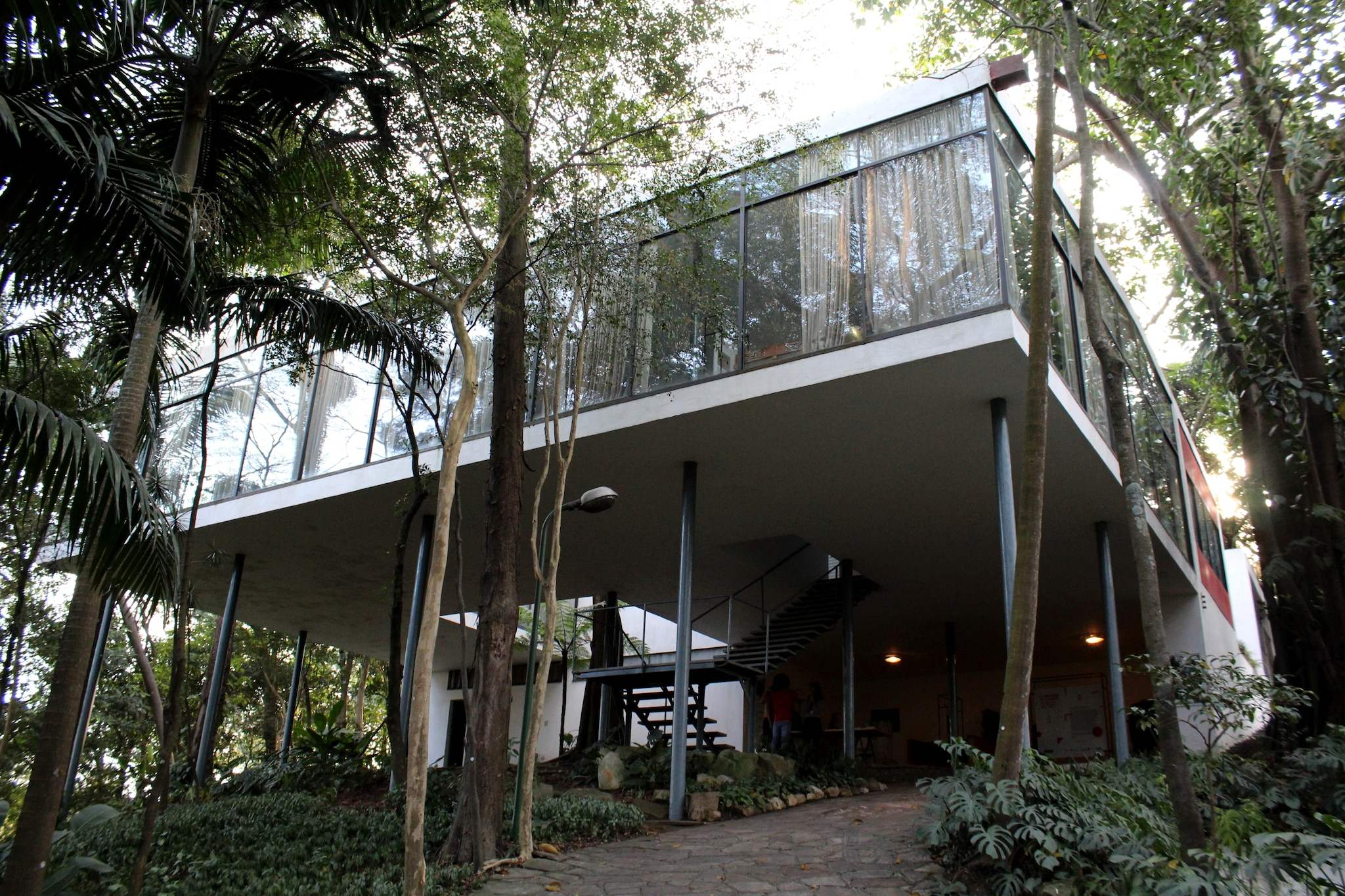
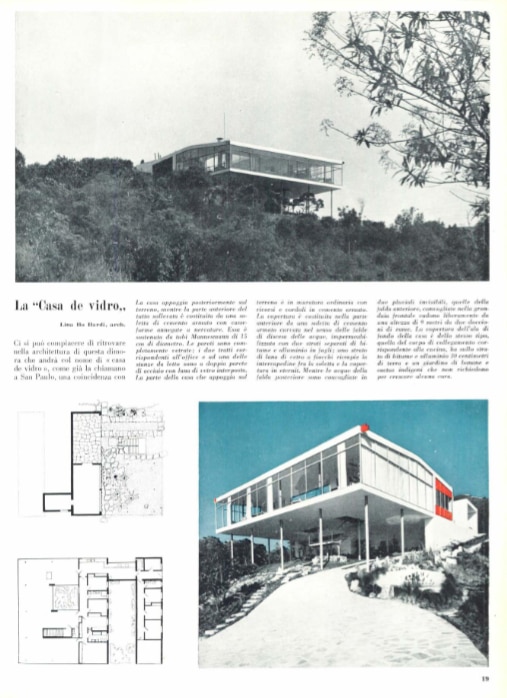
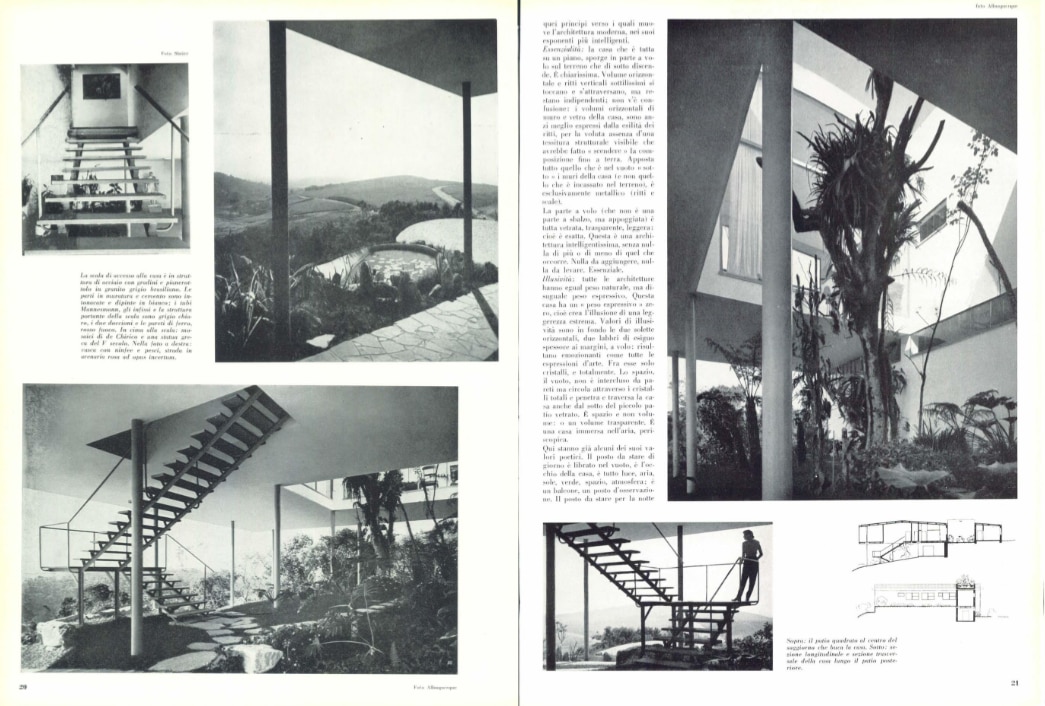
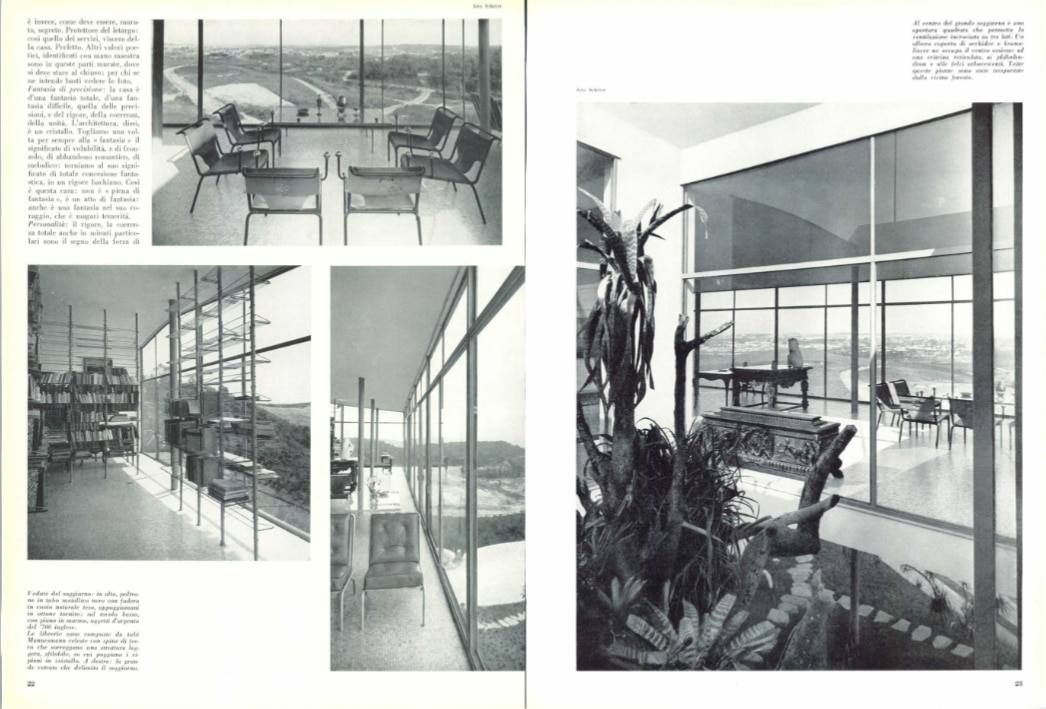
This glass house perfectly represents how the modernity of architecture, which in the 1920s was pure avant-garde, in the post-war period was transformed and materialised with a more complex and organic idea of space, structure and matter. Lina Bo (Bardi), an extraordinary and unique figure in Italy who left the country to follow her feelings, designed and built this masterpiece of concrete, iron, glass, colours and nature. In a sort of “flying wing”, a transparent volume suspended in mid-air on a thin metal piling and immersed in the Brazilian sky, there is the living area full of light, sun, air, and greenery - an atmosphere that is obtained through a large glazed architectural loggia for living while observing the landscape (and being observed by it). The sleeping area, on the other hand, is protected and set in the rest of the dwelling, which is firmly rooted to the ground on the slope of a hill, with an architectural box with a garden courtyard full of tropical vegetation and solid walls that draw the private enclosure of living.
Opening image: Lucas Medeiros
11
Ludwig Mies van der Rohe
Farnsworth House, Plano (USA), 1945-51
Domus 1057 May 2021
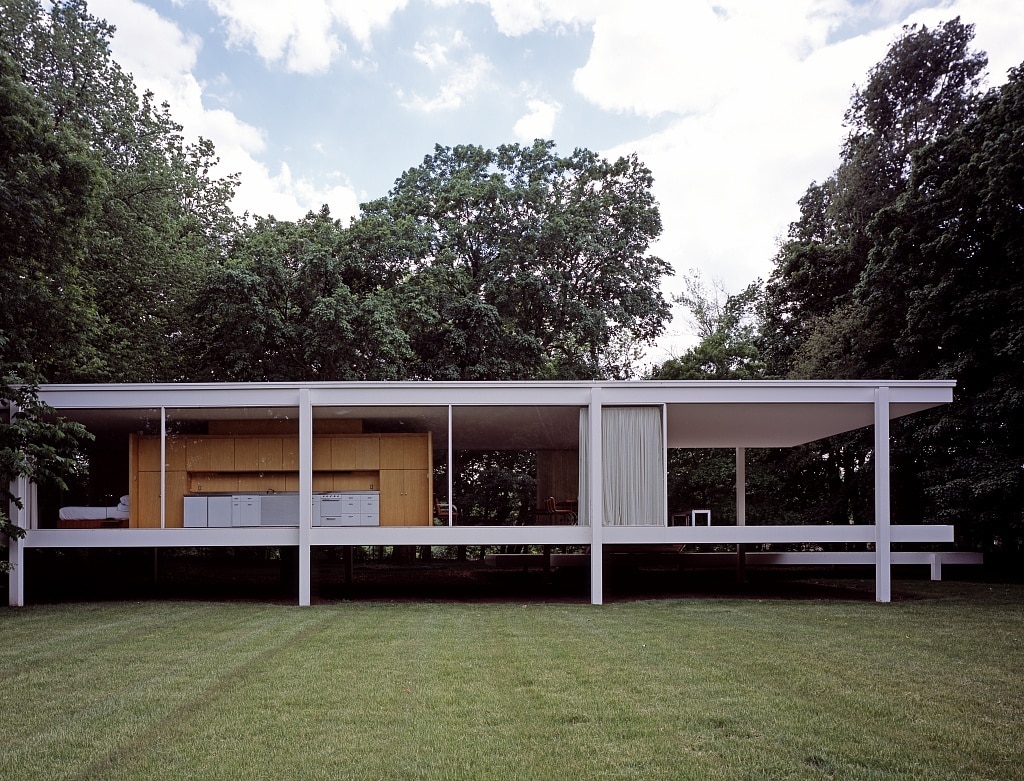
This pure structure painted in white is suspended on a green lawn in a forest at the edge of a river. The grid-like structure of steel and glass contains the minimum practical furnishings for the maximum idealised living. Mies van der Rohe had the (not easy) opportunity to work on a tiny but precious project that he perhaps considered too much his own because of his close and momentary relationship with the client Edith Farnsworth. Beyond the private and personal anecdotes, Mies tried to design a house that would “let the outside in”, with a structure highlighted by a single volume of transparent glass, a skilful distribution of semi-public and semi-private rooms around a central, opaque “core” with the kitchen and the bathroom. It is a work of art to inhabit - which is usually an uncomfortable thing to do.
Opening image: Victor Grigas. By SIAE 2022
12
Philip Johnson
Glass House, New Canaan (USA), 1946-49
Domus 273, August 1952

Philip Johnson’s Glass House is just one of the two buildings he designed at the same time, for the same place - a park where he built pavilions in which to live surrounded by nature and art. Almost like a competition - the pupil who wants to outdo his master and friend Mies van der Rohe - this glass house is a transparent volume resting on the ground, with a three-dimensional black frame made of structural perimeter profiles. Each side of the parallelepiped features an access to the central and direct environment, in which the equipment for the primary functions, except for the bathroom, is distributed without physical margins - kitchen, dining room, living room, study, bed, as well as the not accidental and important presence of a painting and a sculpture. On the other hand, the second pavilion, called the Brick House, cleverly offset and a few steps away from the “living room pavilion”, contains the bedrooms and a study - intimate and private spaces, with no direct view to the outside, lit only by zenithal skylights and a few circular portholes.
Opening image: Staib
13
Oscar Niemeyer
Casa das Canoas, Rio de Janeiro (Brazil), 1951-53
Domus 302, January 1955 / Domus 905, July 2007
This house built around a rock on the one hand plunges into a pool, and on the other literally becomes the foundation stone of an architecture made of a transparent and curved pavilion welcoming all kinds of environmental stimuli and offering a relaxing stay immersed in nature. In the definition of a “tropical modernism”, Niemeyer works by experimenting with the exterior/interior relationship with continuity between natural and artificial entrusted to the freedom of the curved line that goes where it wants, where it can or where it must. The house adapts to the unevenness of the ground, so that the access to the living area, a sort of living room-veranda-porch, is placed at a higher altitude, while the sleeping area is below, reserved and apparently secondary, and overlooks another garden facing the coast.
Opening image: Nelson Kon
14
Frank Lloyd Wright
Kaufmann House - Fallingwater, Bear Run (USA), 1935-38
Domus 125 May 1938 / Domus 207 March 1946
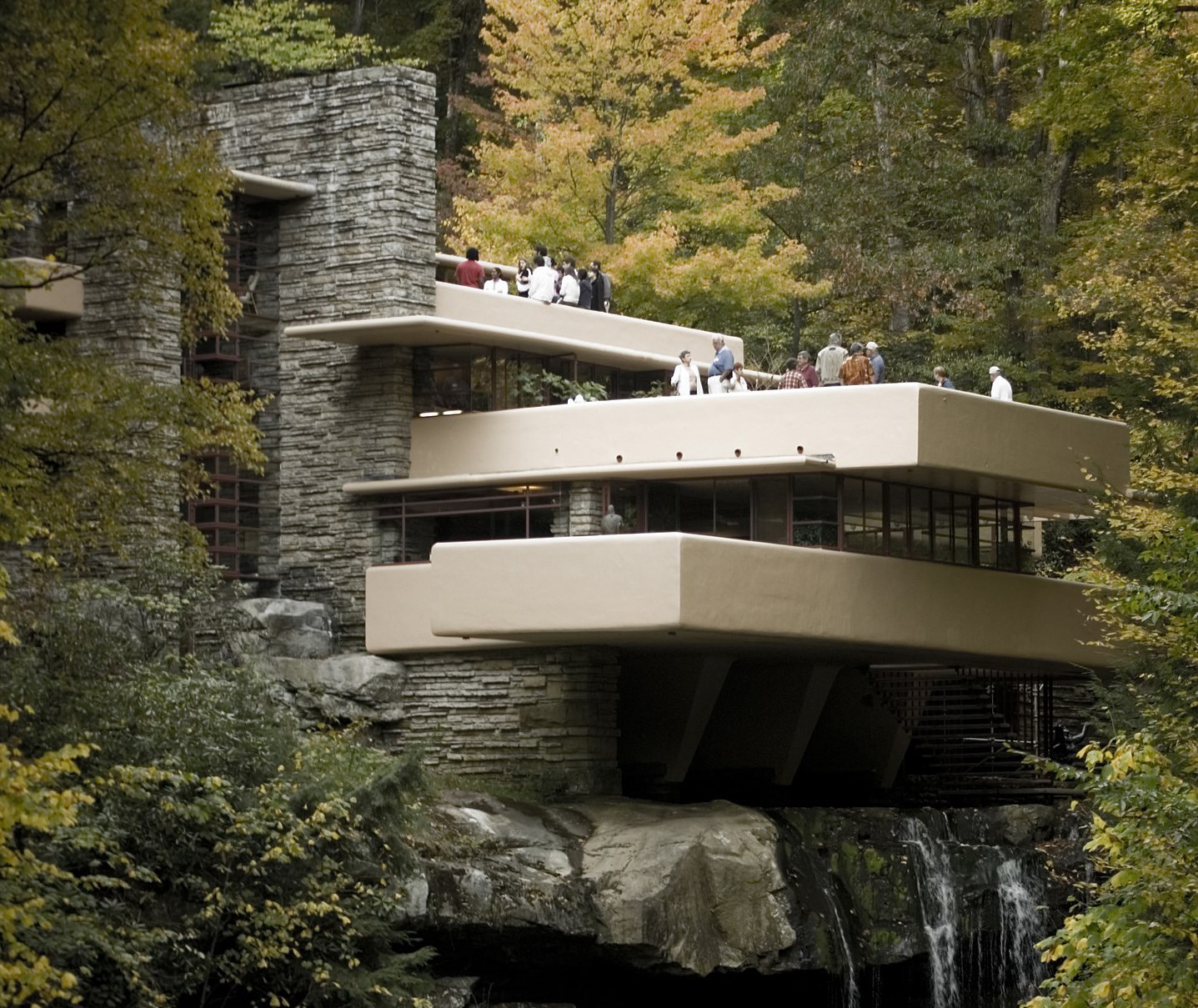
The house on the waterfall is perhaps the most famous house in the world and everyone, not just insiders or architecture lovers, has at least heard of it. This is perhaps also the most isolated house in the world, tucked away in an American valley, immersed in the forest and built partly over a waterfall. With this architecture, the old American architect demonstrated the youthfulness of his ideas and wrote the most important chapter of his theoretical manifesto of so-called “organic architecture”, which thrives on its relationship with the environment, in the continuous relationship between interior and exterior, in the construction of closed spaces connected to open spaces to be inhabited - here, the large cantilevered terraces where the tree crowns create a natural vault - in the use of materials that pay attention to construction and context. The human being here cannot but be aware that they are a part of the whole.
Opening image: Sxenko
15
Adalberto Libera - Curzio Malaparte
Villa Malaparte, Capri (Italy), 1936-38
Domus 605 April 1980 / Domus 1055 March 2021
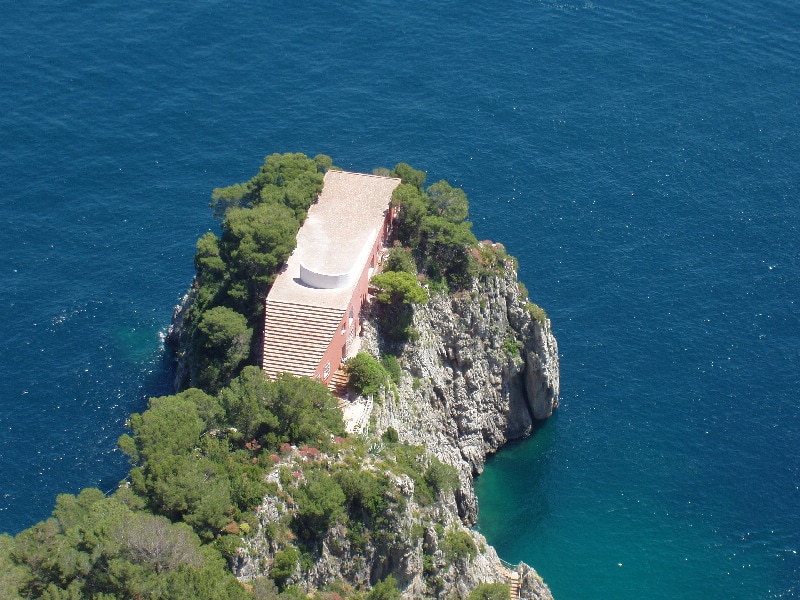
This home-sweet-fortress perched on a rocky promontory in the middle of the Mediterranean was nicknamed “a house like me”. Curzio Malaparte, a multifaceted and talented literary author, initially asked Adalberto Libera, who was one of the most refined modernists, to design a unique house for a rare place. From the outset, Malaparte participated so actively in the project that this house is considered a self-portrait of the author and inhabitant who, as an artist, turned it into a total work of art. Inside, we could say there is only a “simple” living room and bedrooms with framed views, while outside the compact volume tapers towards the ground offering a monumental staircase that connects with the natural gradients and lands on the flat roof - an infinite terrace between sky and sea with a small architectural “cloud” of white plaster, and a place where to carry out the primary and vital activities of this place that becomes a landscape.
Opening image: Peter Schüle
16
Luis Barragan
Casa Barragan, Mexico City (Mexico), 1947-48
Domus 280 March 1953
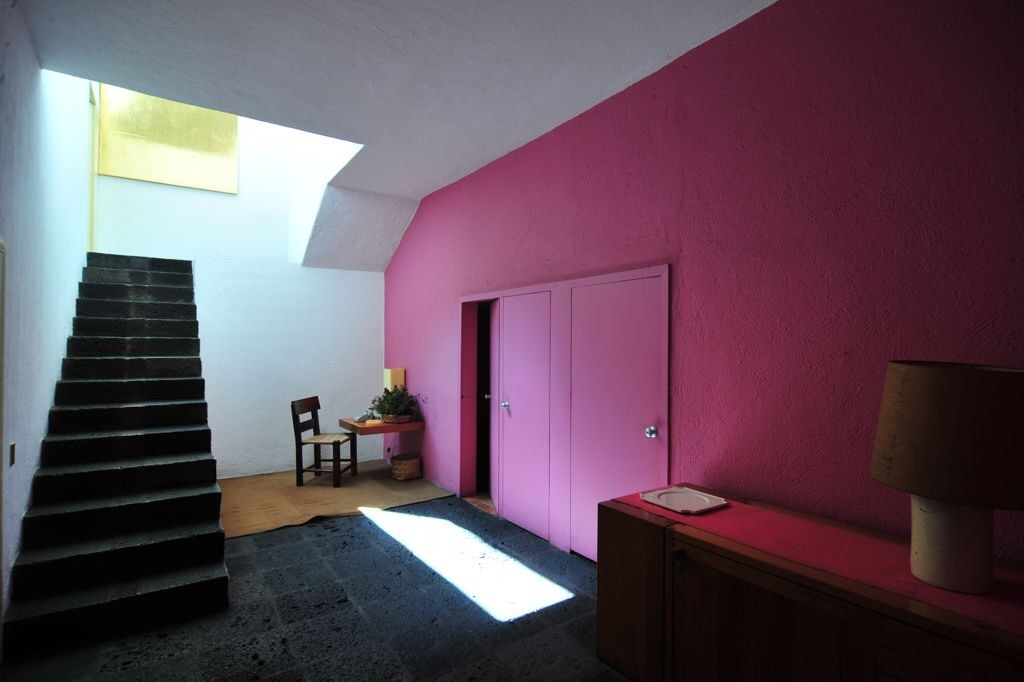
Spaces made of light and colour, few lines, few things, contributing to creating a “lyrical” atmosphere (as Ponti wrote). Whether inside or outside, the orthogonal walls act as articulated margins for habitable spaces in an ascetic landscape in a poetic dimension. Luis Barragan, a unique author in the Central America that had adopted European modernism, declining it according to sensitivity and expressive potential, created a labyrinthine house that at times quickly twists in on itself but that in the end always leads to placid, calm rooms, made up of only light and colour, a few lines, a few things, all just right.
Opening image: 準建築人手札網站 Forgemind ArchiMedia. By SIAE 2022
17
Alvar Aalto
Villa Mairea, Noormarkku (Finland), 1937-39
Domus 320 July 1956
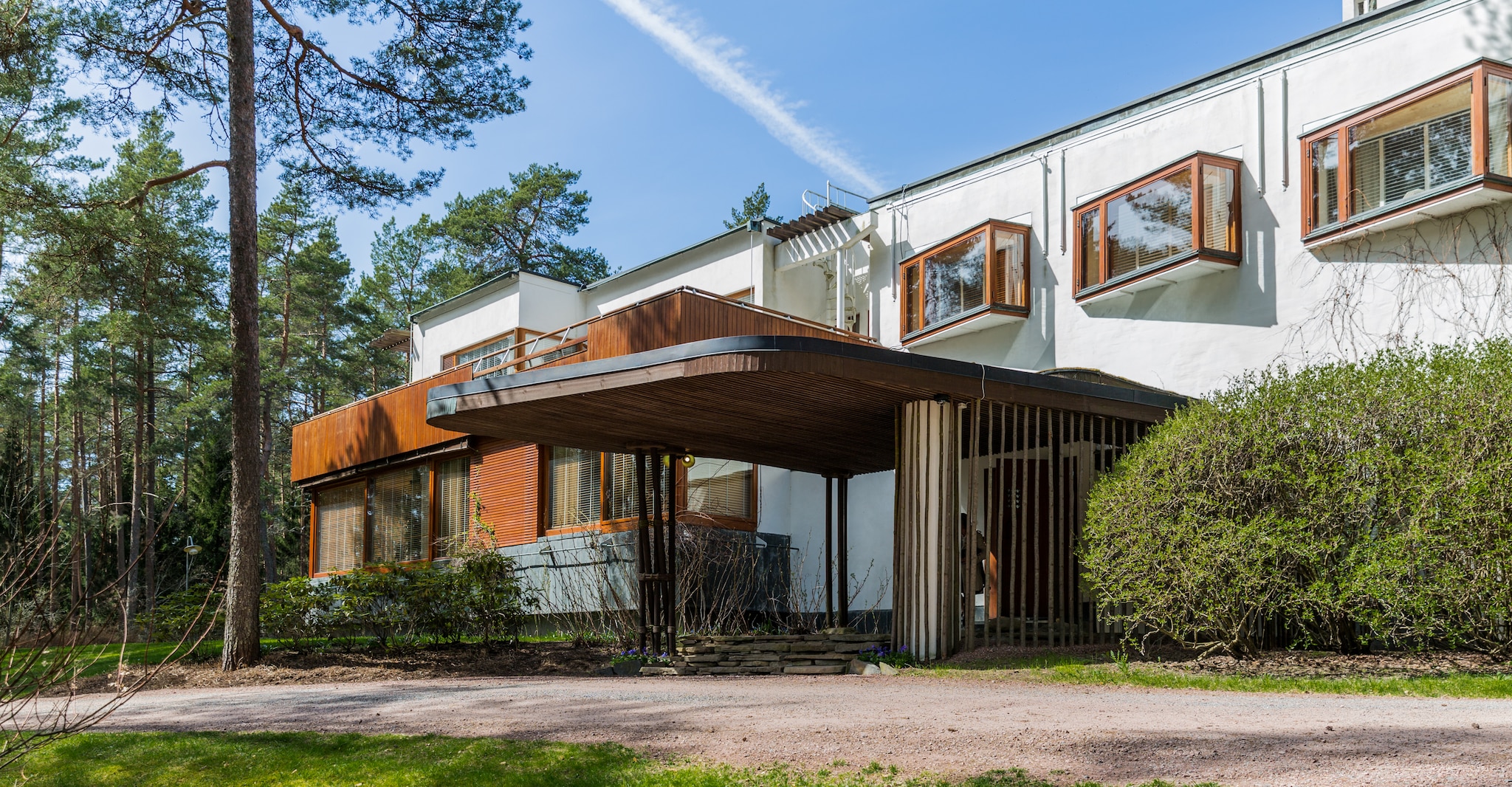
Villa Mairea was designed for Aalto’s art collector friends and associates at the Artek company, with which he produced his iconic bentwood furnishings. The house is a perfect example of that “organic design” that Aalto theorised and worked on between the late 1920s and early 1930s, contrasting - but actually integrating - that aseptic idea of purist and functionalist design of the early avant-garde of the Modern Movement in architecture. Here, immersed in Finnish nature, the volumes, although regular and rational, are always elaborate in the margins, which are designed in every little detail, in order to turn space into an “organic” entity that envelops the activities of individuals and that always dialogues with the outside to which the spaces are directly and naturally connected. The proportions and ratios, lights and shadows, materials and surfaces, always speak a gentle language that welcomes, accompanies and comforts the slow unfolding of everyday life.
Opening image: Ninara
18
Sverre Fehn
Noorköping House, Noorköping (Sweden), 1963-64
Domus 424 March 1965
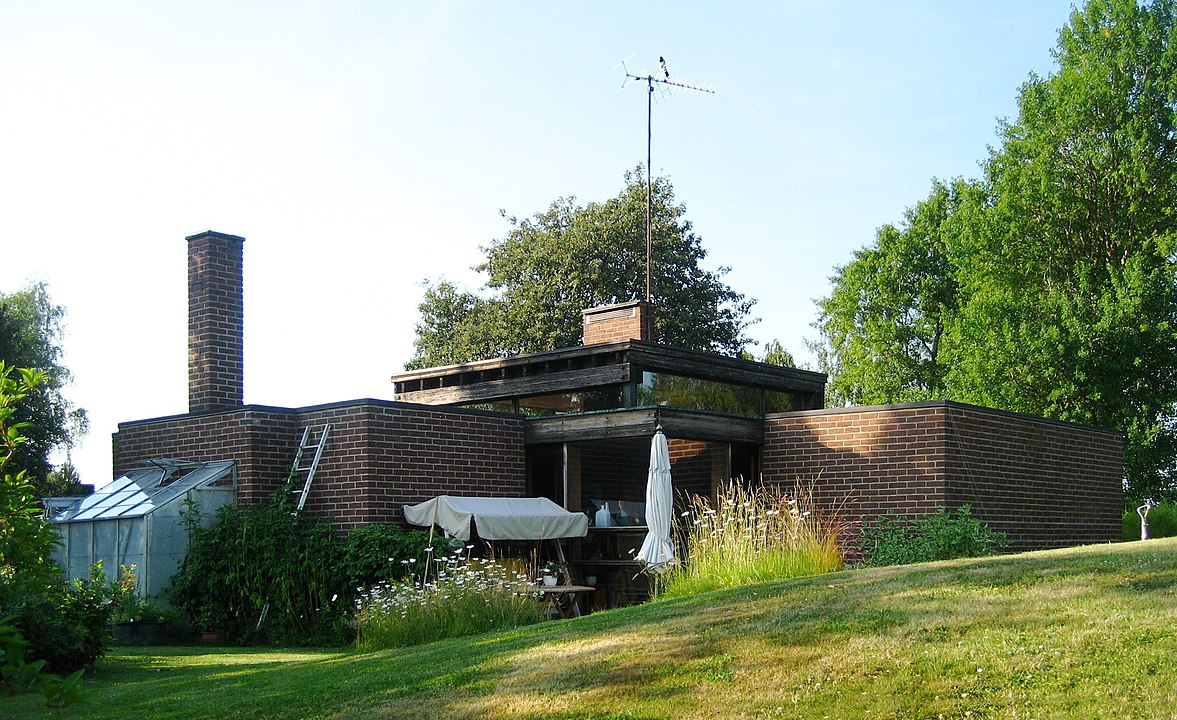
Outside technical drawing, the rigid orthogonal symmetry of the purest geometric rationalism proves to be an excellent tool to understand how space, which has different sun exposures and ever-changing views, can be enriched by the conditions that surround it in order to offer, with the same dimensions, diversified and personal environments. In the centre there is a compact core with the bathroom and kitchen welcoming light and exchanging air from above, at the edges of the introverted brickwork C-shaped niches of the bedrooms, living and dining areas. In between, an internal perimetric and continuous linear pathway can be modulated with mobile, equipped and sliding partition walls in light wood. At the corners of this path are transparent loggias with windows and doors, that can alternately join the intermediate spaces, modulating the rooms and guaranteeing contact with the outside landscape, immersed in the placid Swedish countryside.
Opening image: Sebastian F
19
Louis Kahn
Esherick House, Philadelphia (USA), 1959-61
Domus 735 February 1992
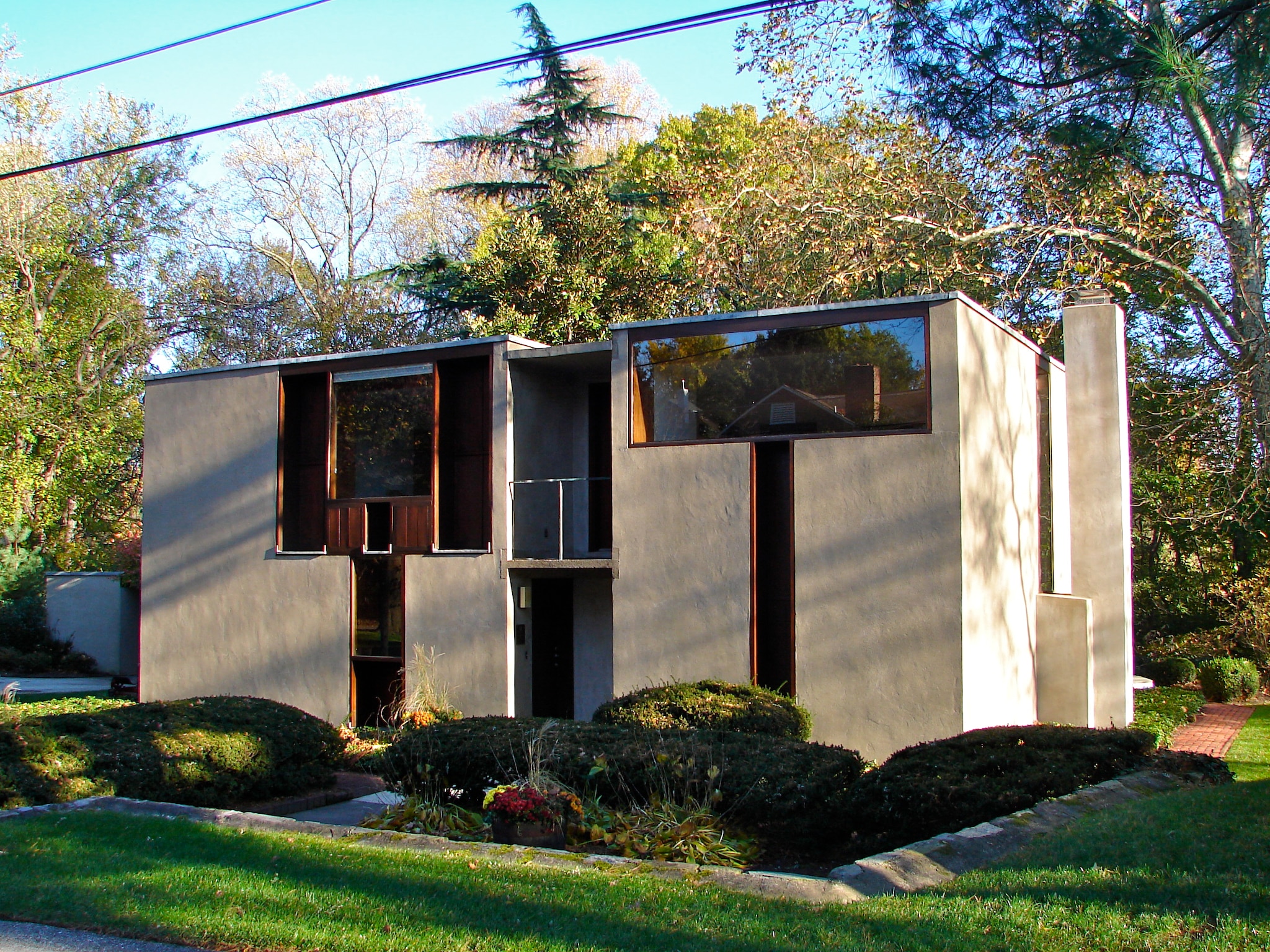
In Louis Kahn’s work, when the harshness of the forms of the most famous architectures and the tectonics of pure, monumental volumes meet the dimension of domestic living, they become the perfect occasion for a relationship with the human scale, in which the proportions become more sophisticated and the results more sensitive. Here, the geometry of the building envelope becomes an anthropometry of space. Two massive orthogonal volumes, parallel and contiguous, compact and deaf towards the entrance, whose façade houses measured slits, as if they were two complementary pavilions, house the sleeping area and bathroom on one side, and a large double-height living area on the other. On the other hand, the side facing the garden features a totally transparent double façade seeking that integration with nature that even the most formally rigorous of architects requires, in a continuous apparent composition of elementary mechanics, where slight distortions determine the specific value of the architectural detail.
Opening image: Smallbones
20
Mario Botta
Casa Sul Lago, Riva San Vitale (Switzerland), 1971-73
Domus 544 March 1975
An isolated tower stands out against the landscape between lake and mountain, horizontal and vertical. The large, compact volume with a square plan is a geometric shell lightened by slits and views of the landscape, onto which the interior living spaces, closed or open, face in a composition by subtraction. One enters from above where, in contrast with such a present volume, the entrance is instead slender and ethereal, reached through a suspended reticular walkway. From a central staircase, one descends almost to the ground, rotating around the core and finding the living functions overlooking outdoor but sheltered spaces - large terraces on designed “voids”, visually connected and three-dimensionally articulated, contained by the main building envelope.
Opening image: Alo Zanetta, courtesy Mario Botta Architetti
21
Carlo Scarpa (with Angelo Masieri and Bruno Morassutti)
Villa Romanelli, Udine (Italy), 1952-55
Domus 644 November 1983
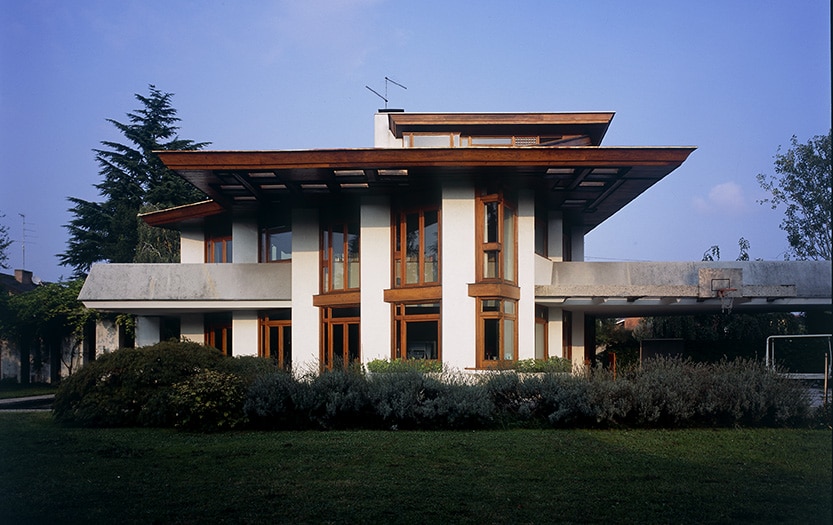
Designing this house was a complex process, as its development, started by Angelo Masieri, who died prematurely, was continued by his colleague Bruno Morassutti and their master Carlo Scarpa. The three were all (in)direct disciples of Frank Lloyd Wright, who had written the beginning of the history of Modern Architecture in the United States. Scarpa changed the design of the house as little as possible, also out of respect for the young architect’s tragic death, but he authoritatively intervened on the unfinished roof - a strong horizontal sign that juts out from the architectural body and traces a covered but open orthogonal space, which protects the sloping perimeter of the living space to further mediate in the relationship between inside and outside, signalled mainly by the characteristic vertical window frames and the windows in the central corner of the façade overlooking the garden.
Opening image: Gianantonio Battistella©CISA - A. Palladio
22
Umberto Riva
Casa Insinga, Milan (Italy), 1987-89
Domus 708 September 1989
To Umberto Riva, a home is a place that is both sacred and secular at the same time, and where the many facets of daily life are held together in a space that is tailor-made and stitched together, amidst furnishings, accessories, objects and works of art. He works patiently, investigating every step, taking into consideration the distribution and organisation of all spaces, even the smallest, and all possible services, even the most unexpected. Each fragment of his interiors is thus a story full of details made of matter and form, materials and logic, function and movement, light and shadow, surprise and good design - the very details that permeate the memory of history.
Opening image: Giovanni Chiaramonte
23
Luigi Moretti
Villa Califfa, Santa Marinella (Italy), 1964-77
Domus 482 January 1970
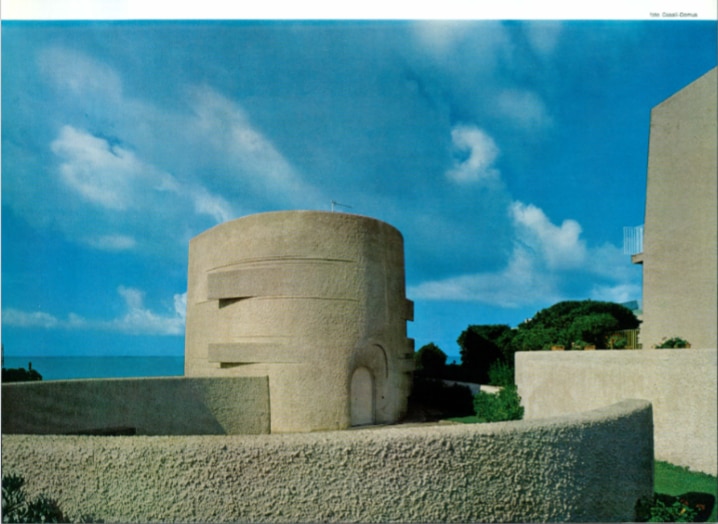
This house completes the triptych of exemplary works flanking and overlooking the Ostia coastline - plastic and vigorous exercises between architecture and sculpture, typical of the second half of the Roman architect’s professional life. These introverted houses' objective is to refresh the human soul and help it create a relationship with nature amidst the great blue, between sea and sky. Villa Califfa is the smallest of the three and stands monolithic and rough, as closed as a defensive watchtower towards the lands, and as open (we might say slashed) towards the sea at noon. From the outside, from the city left behind, only a few small slits in the semi-cylindrical volume can be spotted, like the gills of a beached sea creature, as they open up and allow light to filter inwards and direct the view outwards.
Opening image: Giorgio Casali
24
Vittoriano Viganò
Casa La Scala, San Felice del Benaco (Italy), 1956-58
Domus 351 February 1959
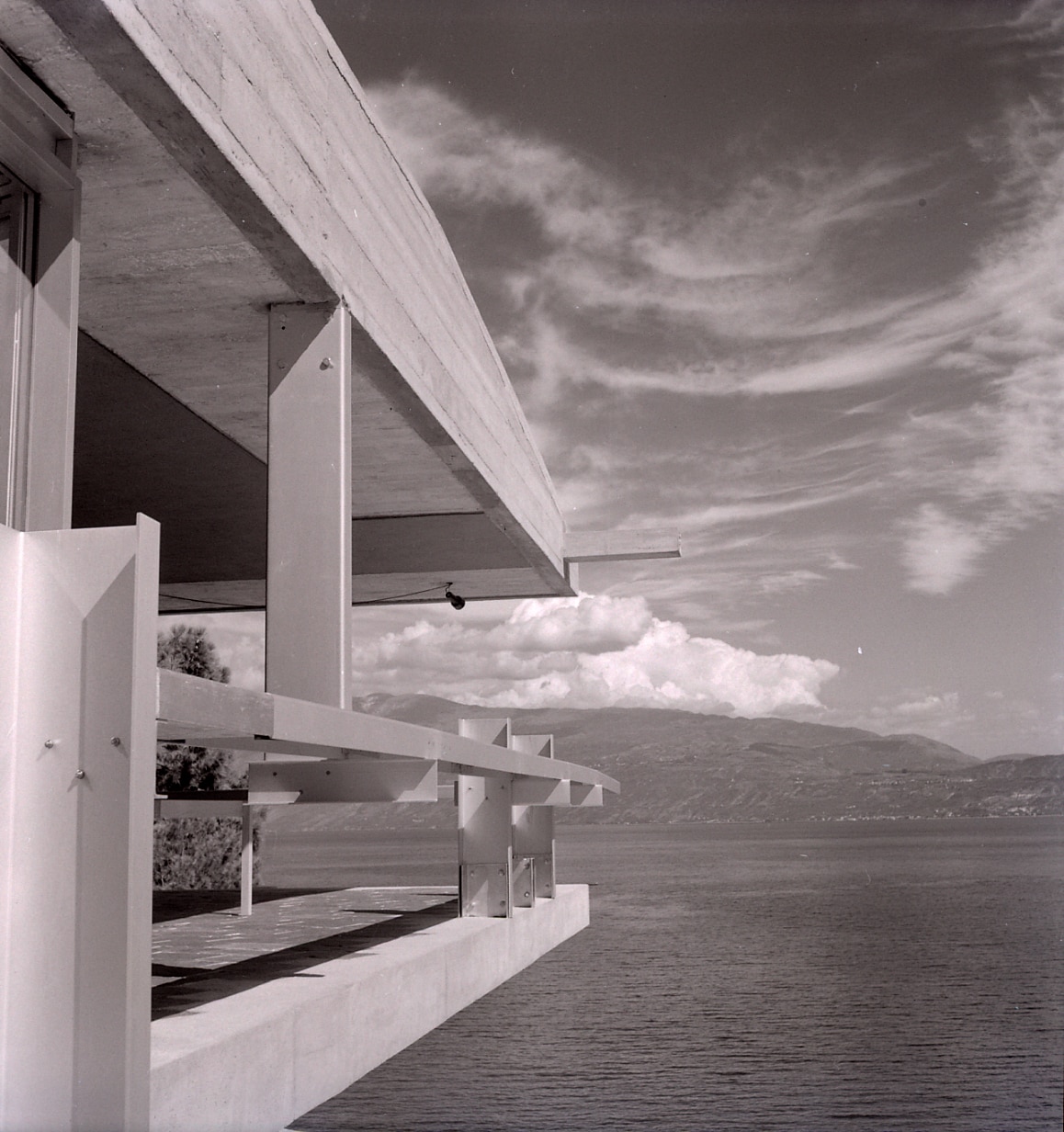
Casa La Scala was designed by a talented (and unfortunately inexplicably not very famous) young Italian architect, Vittoriano Viganò, for a famous French architect, sculptor and painter called André Bloc, who was the director of L’Architecture d’Aujourd’hui and the founder of Espace, an experimental research group between architecture, sculpture and space. In a concept of interior and exterior cancelling each other out in a single unit, the house (whose walls are all transparent and the only closed volumes are the kitchen, bathroom and guest room) is reduced to just two horizontal slabs of trapezoidal-shaped reinforced concrete, one tracing a “floating” floor at the top of the hill, and one creating a flat ceiling/roof cantilevering over the landscape below. Here, in an astonishing structural and sculptural object, is a staircase with 100 cantilevered steps connecting the linear pier to the lake.
Opening image: Paolo Monti
25
Jørn Utzon
Can Lis, Mallorca (Spain), 1970-73
Domus 1014 June 2017

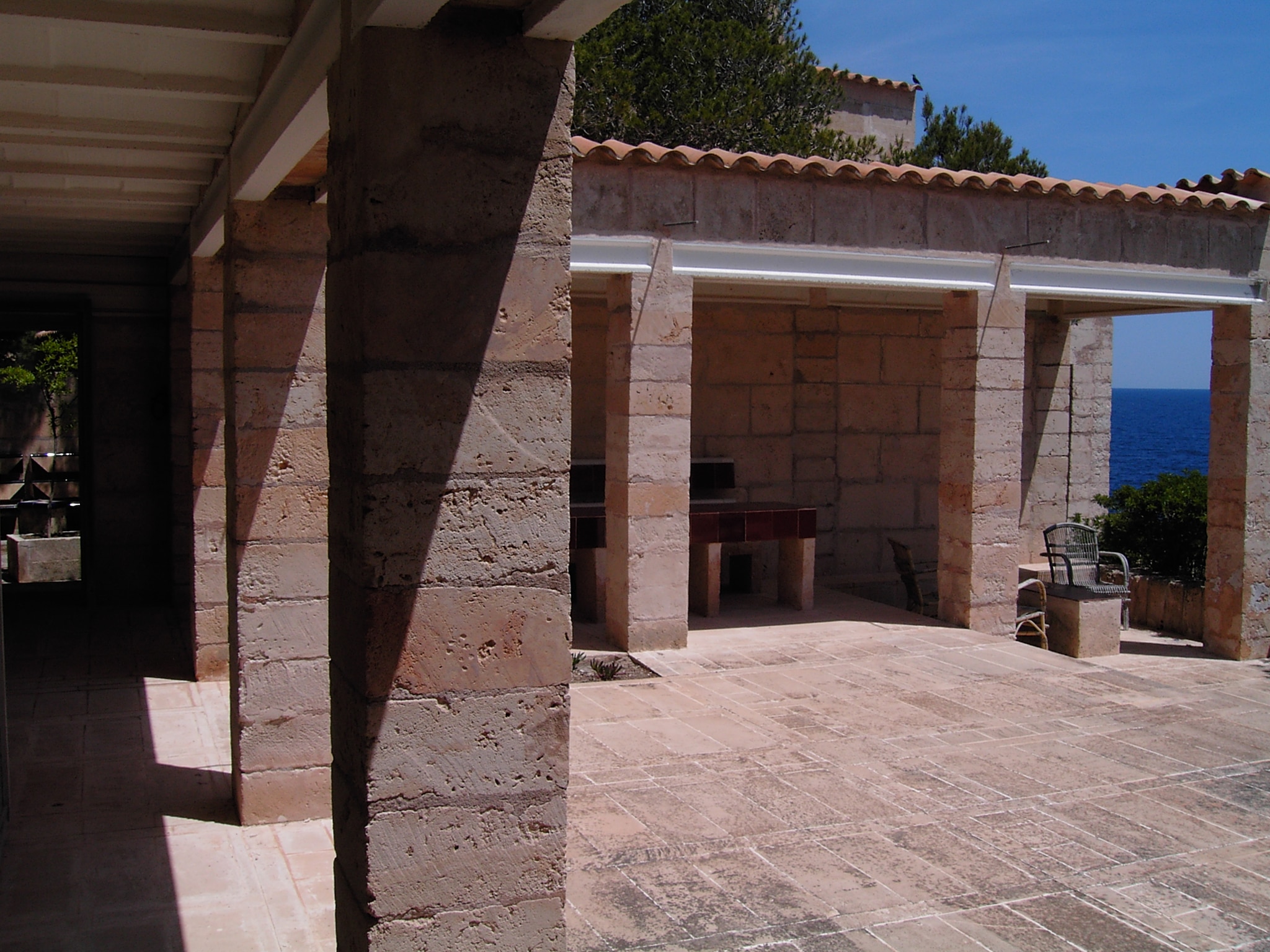
For his own tranquillity and family life, Jørn Utzon designed a radical house made of stone, air and sun overlooking the Mediterranean “ocean”. The house is composed of five independent and off-axis but interconnected units that create a linear path that follows the coastline and goes from the most public place - a porticoed courtyard facing the sea front - to the most private place - the master bedroom - connected by a closed and silent living room, which is a sort of secular chapel in which to contemplate nature, also thanks to the architectural “eyelids” which offer glimpses of the landscape like sharp pictures without frames. These mono-material, primordial spaces, where the main equipment is fixed furniture and sculptural presences, go far beyond the rigour of form, which is instead integrated with the fluidity of the luminous atmosphere and the movement of bodies in the wind.
Opening image: Frans Drewniak
26
Pezo von Ellrichshausen
Solo House, Cretas (Spain), 2009-13
Domus 971 July 2013
This house is part of a programme of ambitious projects by great architects dedicated to living in isolated natural settings. The design was created by a new generation of Latin American architects who design archetypal houses and living spaces in which the smallest details become the protagonists thanks to the greatest attention paid to individual elements and a renewed relationship between art and architecture. Here, the expressiveness of matter and form (few materials including wood and cement, and few primary forms), in their univocal encounter, determine surfaces and volumes in which there is no need to fill the spaces, leaving the void the possibility of expressing its potential together with the bodies and the landscape, which contains them and is meant to be admired.
Opening image: Cristobal Palma
27
Smiljan Radic
Casa Escondida, Playa Escondida (Peru), 2016
Domus 1020 January 2018
The Hidden House is an ongoing project that testifies to the desire of one of the most original authors of the new generation of Latin American architects to understand the architecture of the house as a primary refuge in which to withdraw and to later rediscover a more personal and intimate dimension, while always keeping in touch with the immensity and strength of unspoilt nature. It is a radical project that, not knowing or not wanting to decide what the boundaries between art and architecture are, uses the plasticity of clear-cut forms - the load-bearing and inclined partitions - and the physicality of raw material - exposed reinforced concrete - to determine rarefied spaces that focus on “feeling” things from the inside to the outside.
28
Alejandro Aravena
Elemental, Iquique (Chile), 2002-04
Domus 886 November 2005
This low-cost housing project, developed by the Elemental collective under the direction of Alejandro Aravena, was aimed at promoting the general guidelines of a construction model, even more so than an architectural one, for the redevelopment of a degraded neighbourhood on the outskirts of the Chilean town of Iquique, where dozens of families have been able to find a home and a community - much more than a precarious emergency shelter, then. Their technique was “minimum means for the maximum result”, first of all by ensuring structural solidity and the effortless maintenance of primary volumes, that ordinary people cannot usually maintain in the long term. From this common and serially repeated base, each unit gave rise to a building “to be completed”, with the gradual expansion and adaptation of the original volumes, programmatically modifiable by the inhabitants.
Opening image: Sara Maestrello
29
Alvaro Siza
Malagueira district complex, Evora (Portugal), 1977
Domus 746 February 1993
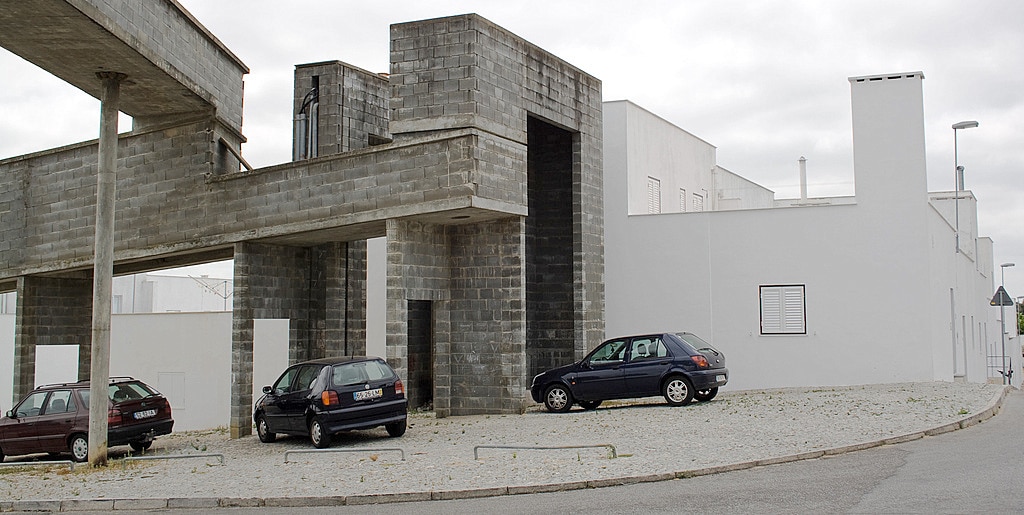
Álvaro Siza is the best representative of the generation of architects that succeeded in overcoming the Modern Movement by learning its method and continuously updating its aesthetic language, made of compositional dynamism and achieved through clear forms and orderly spaces. Without ever being rhetorical or nostalgic, and although often drawing inspiration from the vernacular, Siza’s works are always very mindful of the landscape, which the architect integrates into his interventions into society with its inhabitants. This special public housing project, whose process was not isolated and lasted many years, was dedicated to the integration of disadvantaged communities through participatory methods between architect and citizens. The result is an in-line row of small housing volumes on two levels, with communal and private patios, which tries to solve the problem (and opportunity) of social housing with maximum frugality and a great amount of utopia.
Opening image: Torchondo
30
Vico Magistretti
Houses in Milan (Italy), 1961-64
Domus 432, November 1965
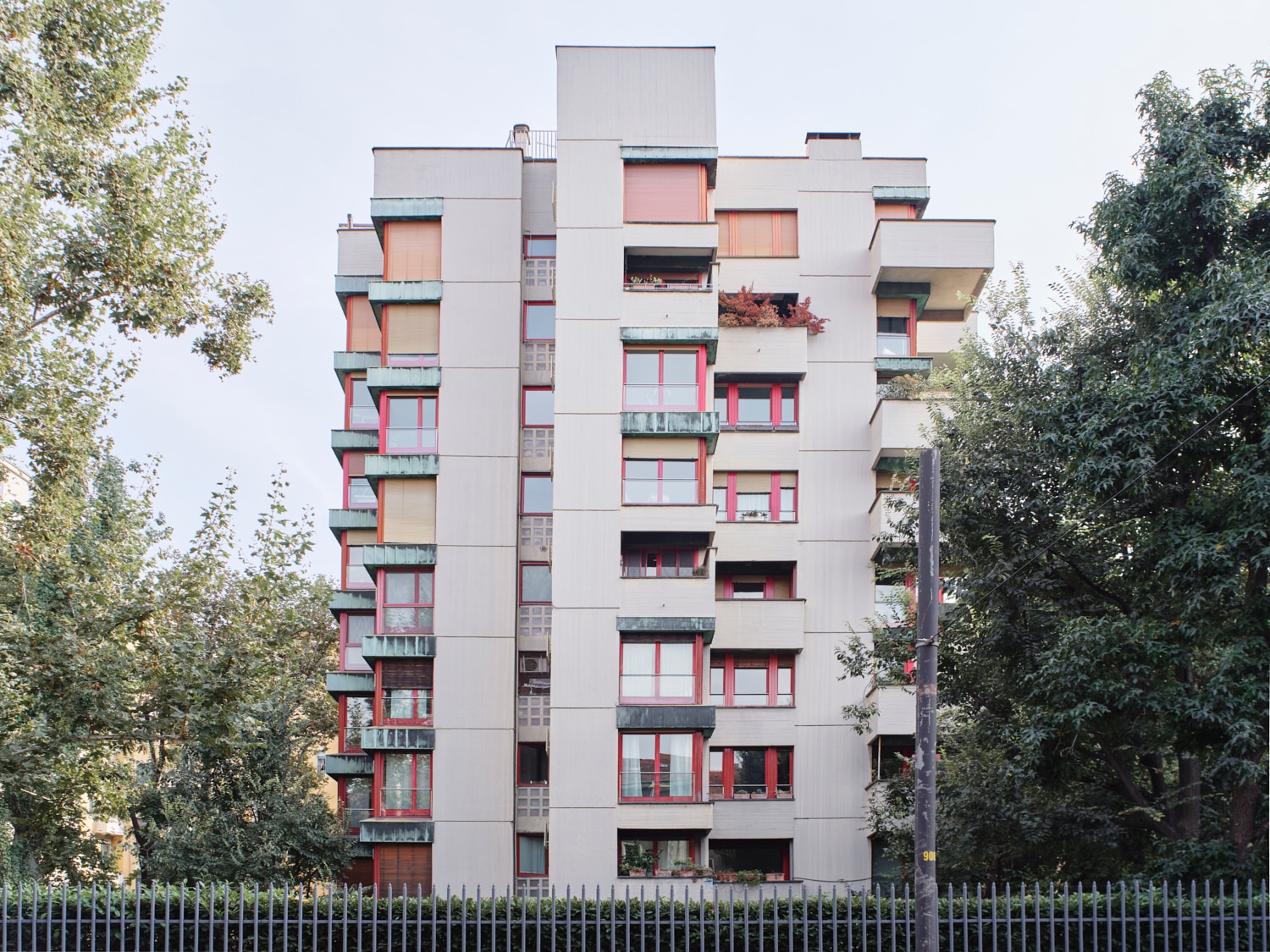
 View gallery
View gallery
Among Magistretti’s many architectures that seem “anonymous” - in the sense that good design integrates with the city and stands out without being too showy - these two houses, of two distinct but complementary types and built with the same materials, together complete the same urban block and resolve Milan’s continuous facade and its traditional history of hidden courtyards, yards and gardens. On the outer contour of the lot, a compact body houses large flats where bathroom and kitchen face the busy square, while the bedrooms and living room face the open, illuminated south-west garden. It is precisely in the garden that the second part of this project takes place, with an isolated tower visible from the street, offering living spaces by experimenting with various types of flats, from the most compact to the most articulated and free-standing, even on several floors and each with several open and habitable balconies.
Opening image: Marco Menghi
31
Luigi Caccia Dominioni
Apartment building in Piazza Carbonari, Milan (Italy), 1960-62
Domus 403, June 1963
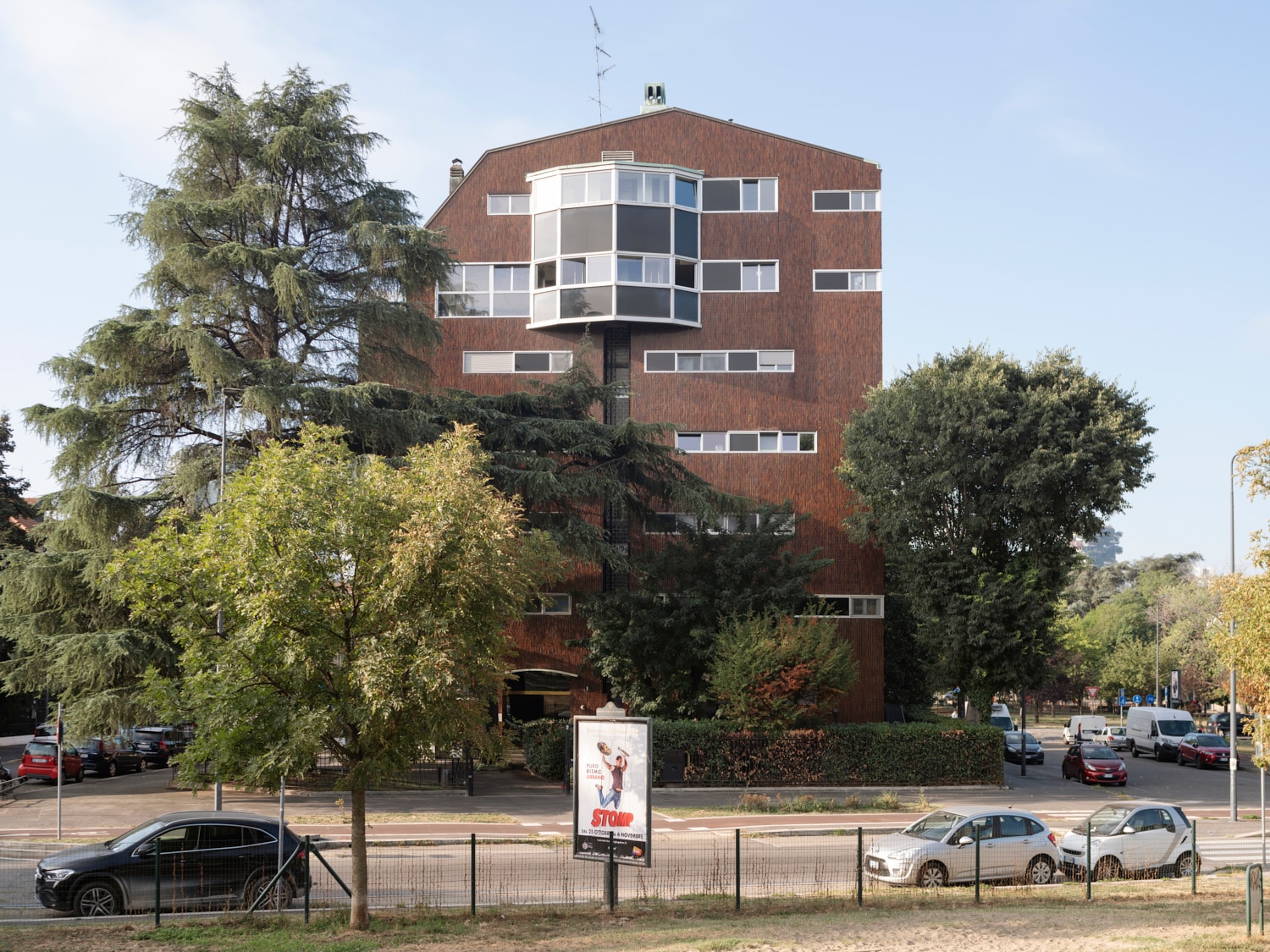
 View gallery
View gallery

Luigi Caccia Dominioni,
Apartment building in Piazza Carbonari in Milan, 1960-62
Photo Marco Menghi
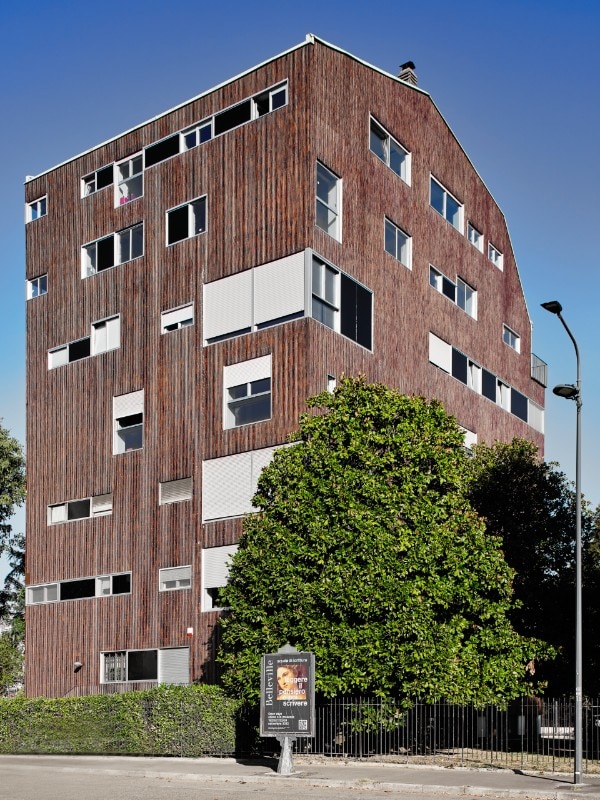
Luigi Caccia Dominioni,
Apartment building in Piazza Carbonari in Milan, 1960-62
Photo Marco Menghi
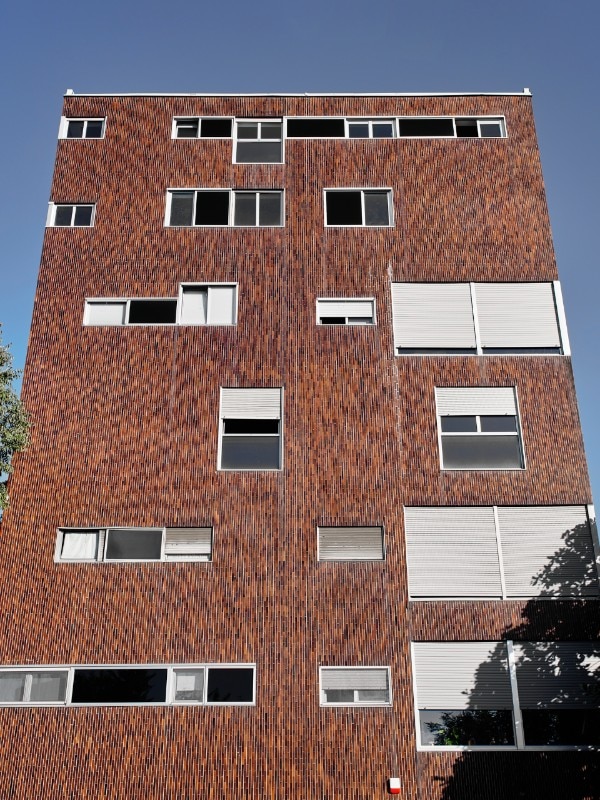
Luigi Caccia Dominioni,
Apartment building in Piazza Carbonari in Milan, 1960-62
Photo Marco Menghi
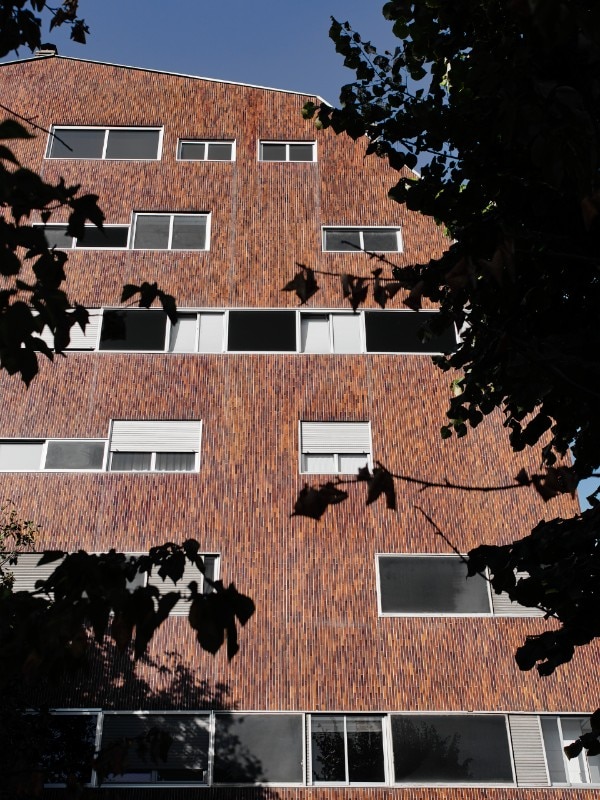
Luigi Caccia Dominioni,
Apartment building in Piazza Carbonari in Milan, 1960-62
Photo Marco Menghi
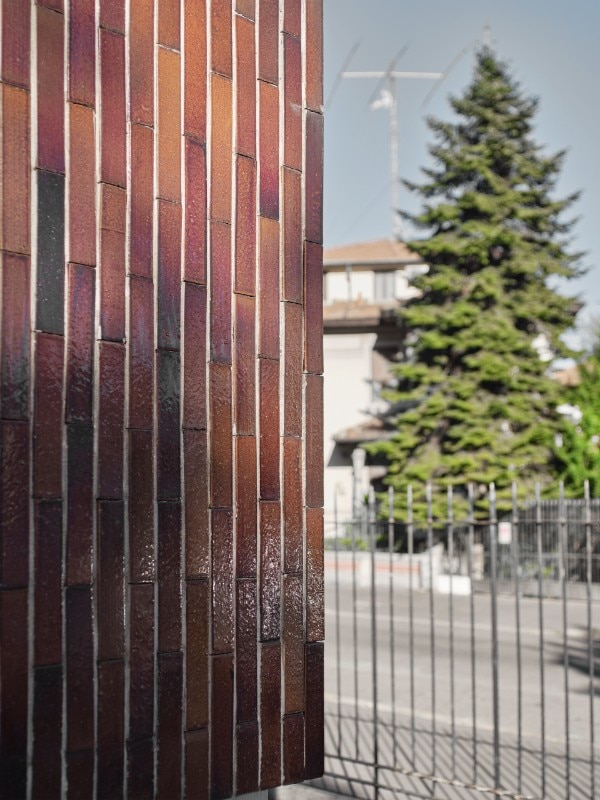
Luigi Caccia Dominioni,
Apartment building in Piazza Carbonari in Milan, 1960-62
Photo Marco Menghi
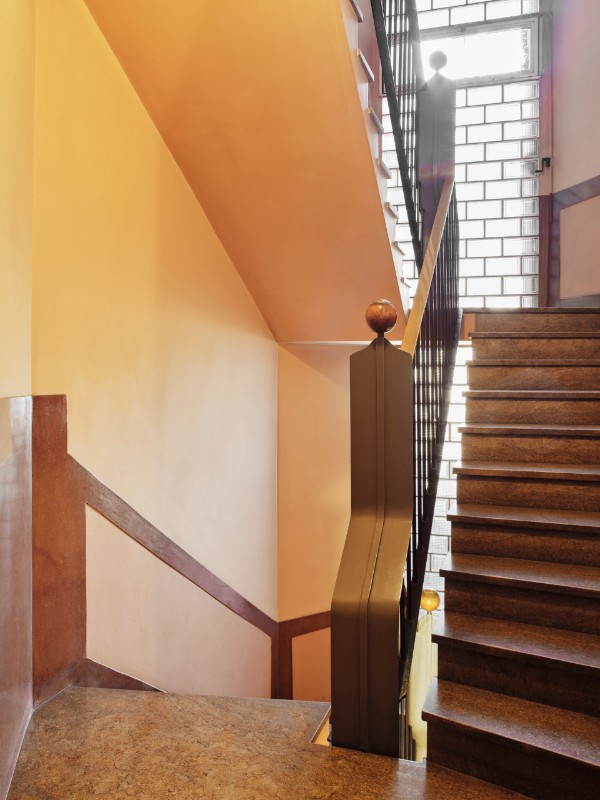
Luigi Caccia Dominioni,
Apartment building in Piazza Carbonari in Milan, 1960-62
Photo Marco Menghi
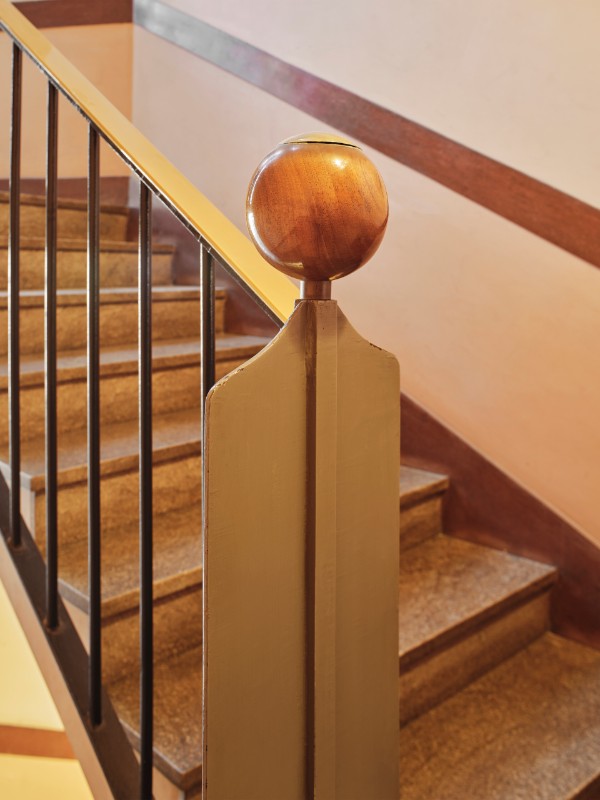
Luigi Caccia Dominioni,
Apartment building in Piazza Carbonari in Milan, 1960-62
Photo Marco Menghi

Luigi Caccia Dominioni,
Apartment building in Piazza Carbonari in Milan, 1960-62
Photo Marco Menghi

Luigi Caccia Dominioni,
Apartment building in Piazza Carbonari in Milan, 1960-62
Photo Marco Menghi

Luigi Caccia Dominioni,
Apartment building in Piazza Carbonari in Milan, 1960-62
Photo Marco Menghi

Luigi Caccia Dominioni,
Apartment building in Piazza Carbonari in Milan, 1960-62
Photo Marco Menghi

Luigi Caccia Dominioni,
Apartment building in Piazza Carbonari in Milan, 1960-62
Photo Marco Menghi

Luigi Caccia Dominioni,
Apartment building in Piazza Carbonari in Milan, 1960-62
Photo Marco Menghi

Luigi Caccia Dominioni,
Apartment building in Piazza Carbonari in Milan, 1960-62
Photo Marco Menghi
This trend-setting architecture stands out in what used to be the northern suburbs, where a compact and solid apartment building - clad with the traditional shiny Klinker tiles in caramel-coloured vitrified litho ceramic - ends with an arched, polygonal and asymmetrical upper profile that follows the maximum volume allowed by building regulations. The façades are striking for their compositional freedom given by the variety of openings with façade-flush frames (ribbon, angular, insulated, obscured with surprising black glass panels and with the exception of a double bow-window for the internal lift landing) and their irregular arrangement, which testifies to the importance of giving the right light and the right view to the interior spaces, which are thus characterised towards the outside, the “simple” mirrored result of the interior life.
Opening image: Marco Menghi
32
Angelo Mangiarotti and Bruno Morassutti
Three-cylinder house, Milan (Italy), 1956-61
Domus 360, November 1959 / Domus 387, February 1962
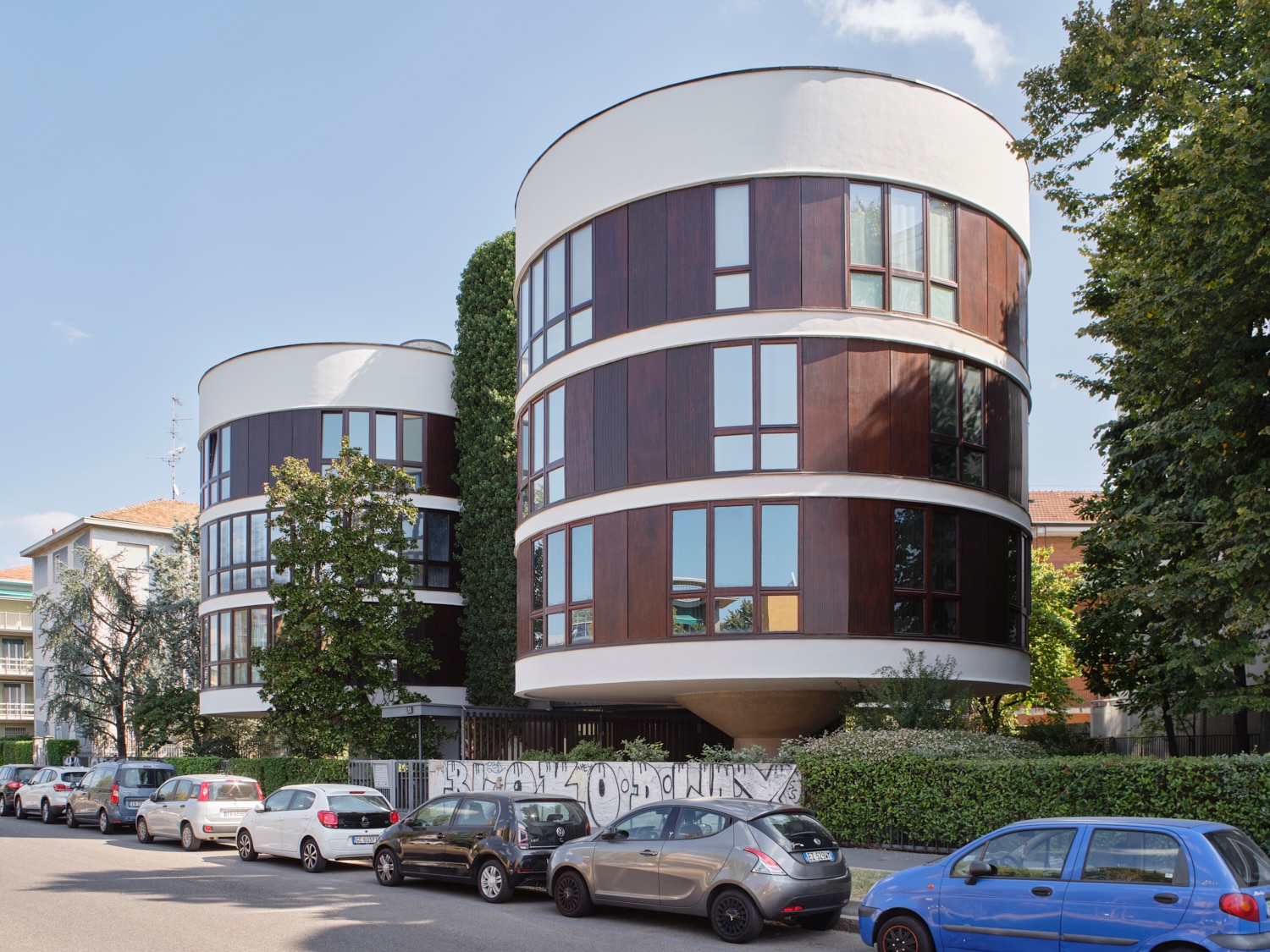
 View gallery
View gallery

Angelo Mangiarotti and Bruno Morassutti
House 3 Cilindri, Milan, 1956-61
Photo Marco Menghi
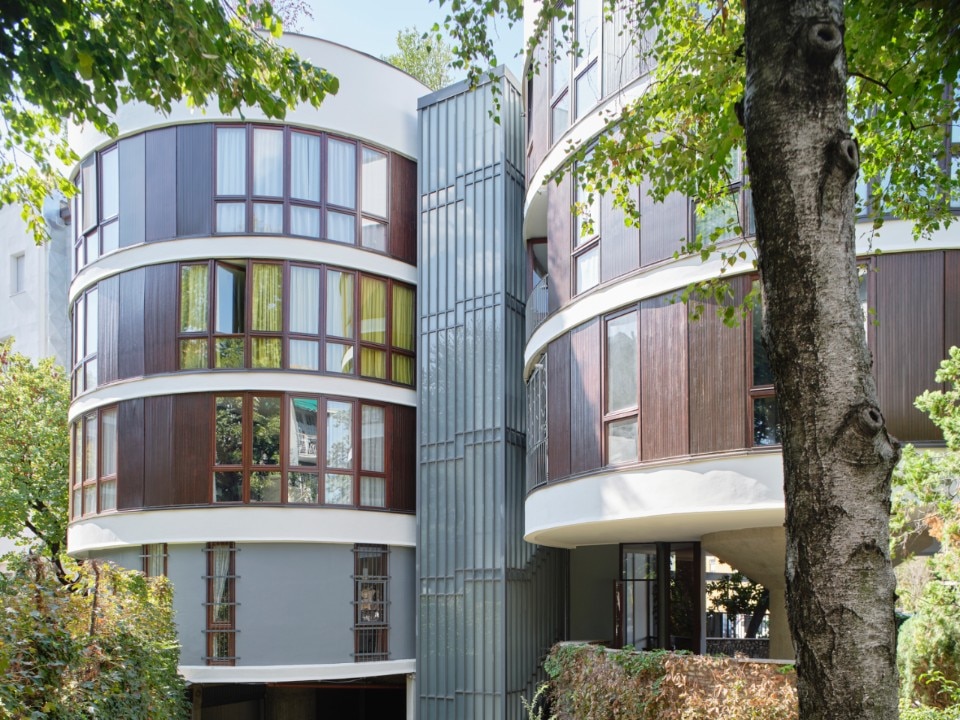
Angelo Mangiarotti and Bruno Morassutti
House 3 Cilindri, Milan, 1956-61
Photo Marco Menghi
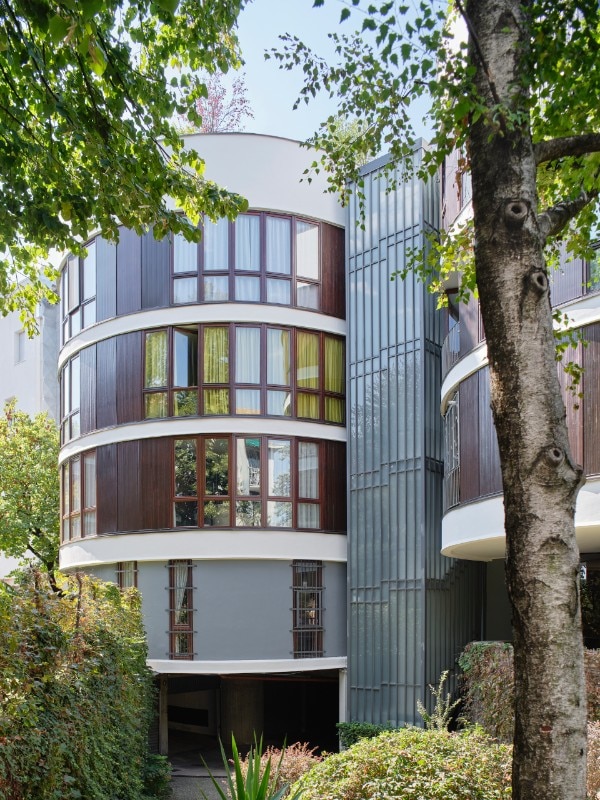
Angelo Mangiarotti and Bruno Morassutti
House 3 Cilindri, Milan, 1956-61
Photo Marco Menghi
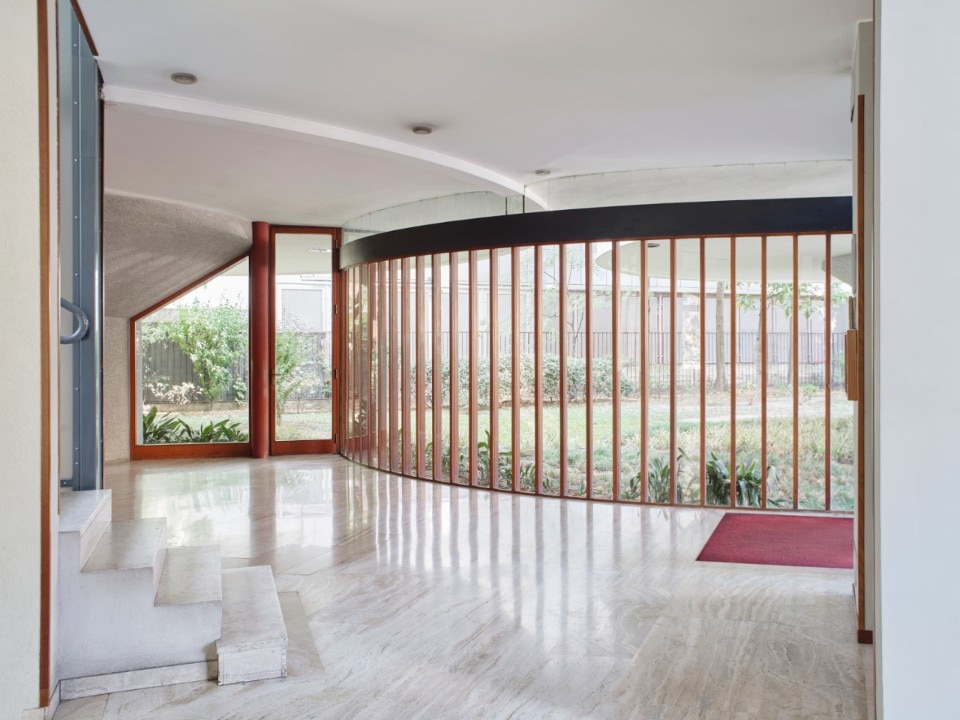
Angelo Mangiarotti and Bruno Morassutti
House 3 Cilindri, Milan, 1956-61
Photo Marco Menghi
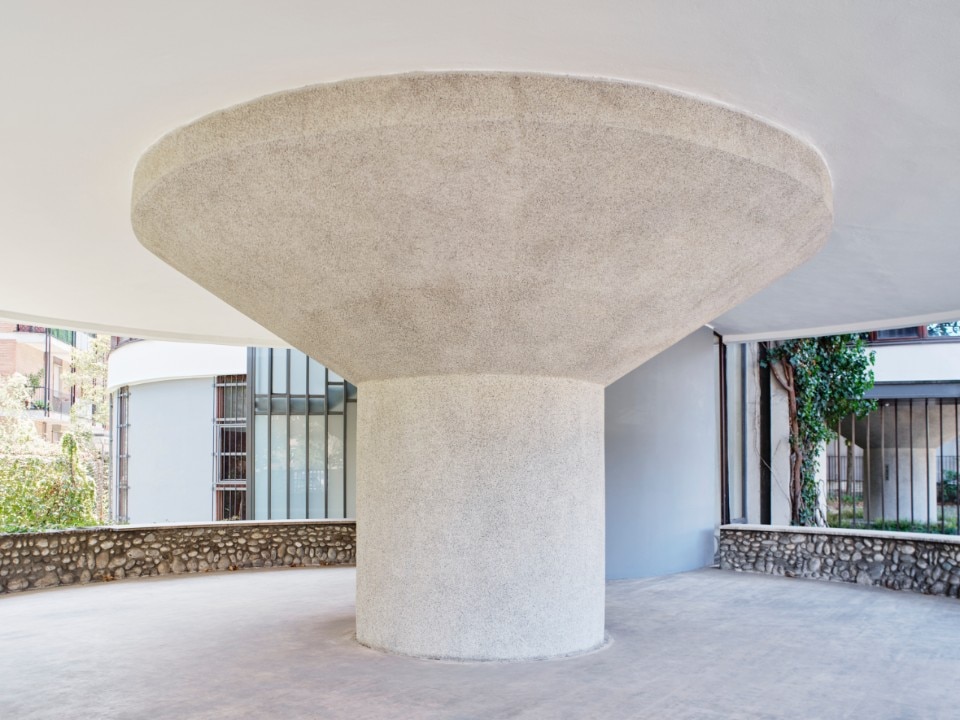
Angelo Mangiarotti and Bruno Morassutti
House 3 Cilindri, Milan, 1956-61
Photo Marco Menghi
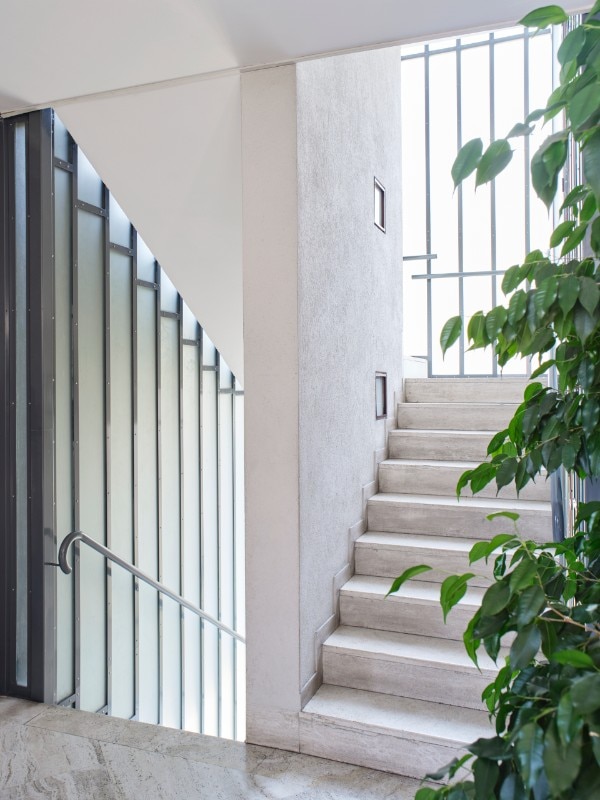
Angelo Mangiarotti and Bruno Morassutti
House 3 Cilindri, Milan, 1956-61
Photo Marco Menghi
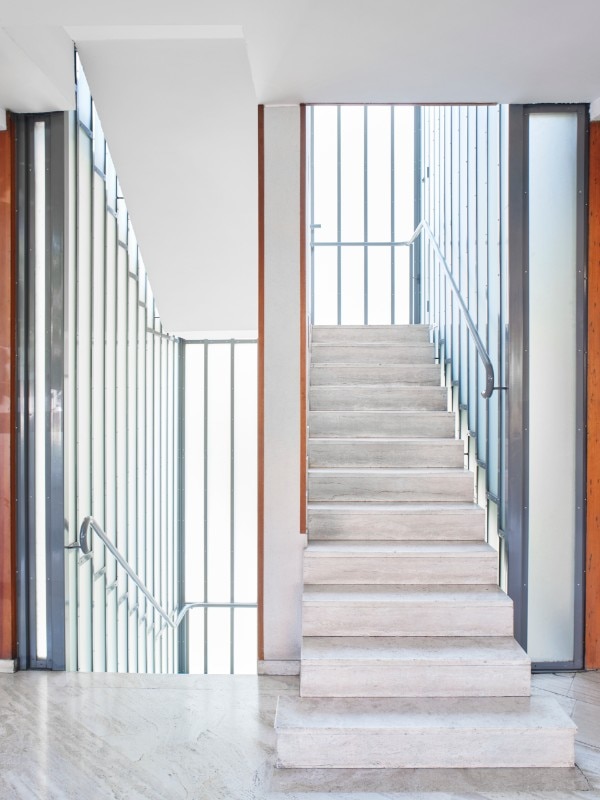
Angelo Mangiarotti and Bruno Morassutti
House 3 Cilindri, Milan, 1956-61
Photo Marco Menghi

Angelo Mangiarotti and Bruno Morassutti
House 3 Cilindri, Milan, 1956-61
Photo Marco Menghi

Angelo Mangiarotti and Bruno Morassutti
House 3 Cilindri, Milan, 1956-61
Photo Marco Menghi

Angelo Mangiarotti and Bruno Morassutti
House 3 Cilindri, Milan, 1956-61
Photo Marco Menghi

Angelo Mangiarotti and Bruno Morassutti
House 3 Cilindri, Milan, 1956-61
Photo Marco Menghi

Angelo Mangiarotti and Bruno Morassutti
House 3 Cilindri, Milan, 1956-61
Photo Marco Menghi

Angelo Mangiarotti and Bruno Morassutti
House 3 Cilindri, Milan, 1956-61
Photo Marco Menghi

Angelo Mangiarotti and Bruno Morassutti
House 3 Cilindri, Milan, 1956-61
Photo Marco Menghi
The architects designed on every dimensional scale, from the furniture to the prefabricated structure, including architecture and interiors. This house, made of three cylinders suspended on a single “mushroom” pillar, sums up their typological research and becomes a masterpiece in the “garden neighbourhood” adjacent to the San Siro sports facilities in Milan. The ground floor is a continuous, green open space for communal activities, while the roof houses a terrace connected to the penthouse on the top floor. The three independent volumes become semi-tangent in a central core and the façades are continuous free ribbons that can be closed or opened up according to the internal distribution desired by each inhabitant. At the centre of each cylinder, a box-like structural column is permeable and habitable, starting from the column capital at the base and running through all the floors, stiffening the core and freeing all the cantilevered circular space.
Opening image: Marco Menghi
33
Aldo Rossi
Residential building, Berlin (Germany), 1981-87
Domus 697 September 1988

This town block nicely explains how Aldo Rossi saw the architecture of the city and its public form, which is different from the “elevated and private form”. The street draws the linearity of the façades that nevertheless remain permeable to the ground floor thanks to porticoes and passages that connect the external façade with that of the internal garden. The red bricks of the facades with rows of yellow elements highlighting the landings, glass for the large greenhouse surfaces and green and white square and cruciform windows, steep green copper roofs and spire-like towers containing stairs and lifts are the clear and recognisable elements of Rossi’s language that characterise this new piece of rebuilt city. Where this new continuous facade - facing the wall that still divided the city - bends at an angle, there is a giant, abstract, almost metaphysical white column - a postmodern reinterpretation of history, an urban reference for a characteristic landmark of the city.
Opening image: Gunnar Klack
34
Ettore Sottsass
Mourmans House, Lanaken (Belgium), 1995-2002
Domus 839 July 2001
Sottsass defined himself as an architect even when he designed furniture and everyday items. He was neither a designer nor an artist, then, but a planner who takes care of the space and the useful forms that people experience with participation. The houses designed by Sottsass are still little studied, but it is here that we understand the reach of his thinking that goes far beyond the object and the design. Bringing together primary metaphysical forms full of energy, changes in scale and an idea of composition by parts, his language rich in chromatic, material and plastic stimuli refers to a contemporary landscape of interiors (and exteriors) made of sharp and stimulating images that offer a positive deep distraction.
Opening image: Richard Bryant
35
Gio Ponti
Villa Planchart, Caracas (Venezuela), 1953-57
Domus 303 February 1955 / Domus 375 February 1961
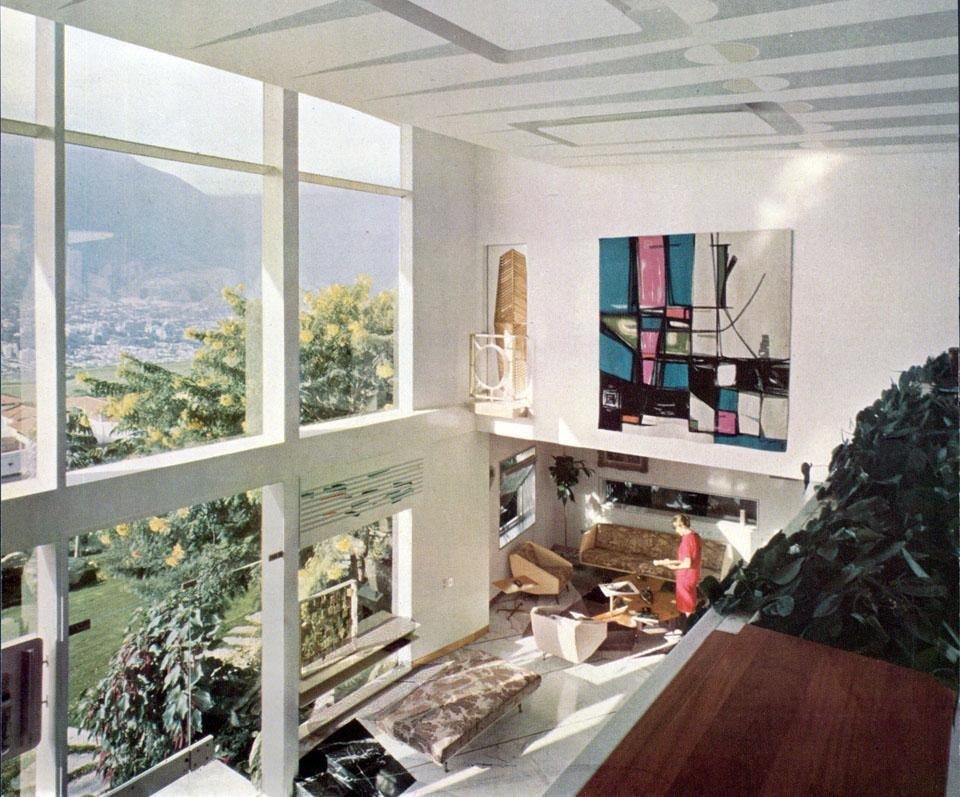
In this villa, which was built after a trip to discover Central America, its territories and its artists, Ponti applied his entire way of thinking about indoor and outdoor architecture - two spheres that are often thought of as separate but which are nothing more than the two sides of the same “medal” that is architecture itself, a permeable margin between intimacy, inside, outside and society. Always seeking the maximum expression of lightness of modern architecture, against the impression of the weight of past architectures, the result reflects the idea of a building that rests on the ground and does not take root, like a graceful butterfly on a flower petal. Thus, on the top of a hill overlooking the metropolis below and from which the mountain range behind can be admired, stands this dwelling for a family of cultured patrons, lovers of contemporary art and nature. The building presents itself as a single polygonal volume with a "flying" roof perforated by differentiated openings in load-bearing walls that do not close the spatial box but bend and taper, leaving glimpses (shadowy by day, luminous by night) in the usually solid corners. Inside is an environmental spectacle where “each space opens on several sides onto the other, resulting in a series of changing architectural spectacles, composed and integrated, with cross views, crossings, from top to bottom, and vice versa”.
Opening image: Paolo Gasparini
36
Charles & Ray Eames
Eames House, Pacific Palisades, Los Angeles (USA), 1949-50
Domus 256 March 1951
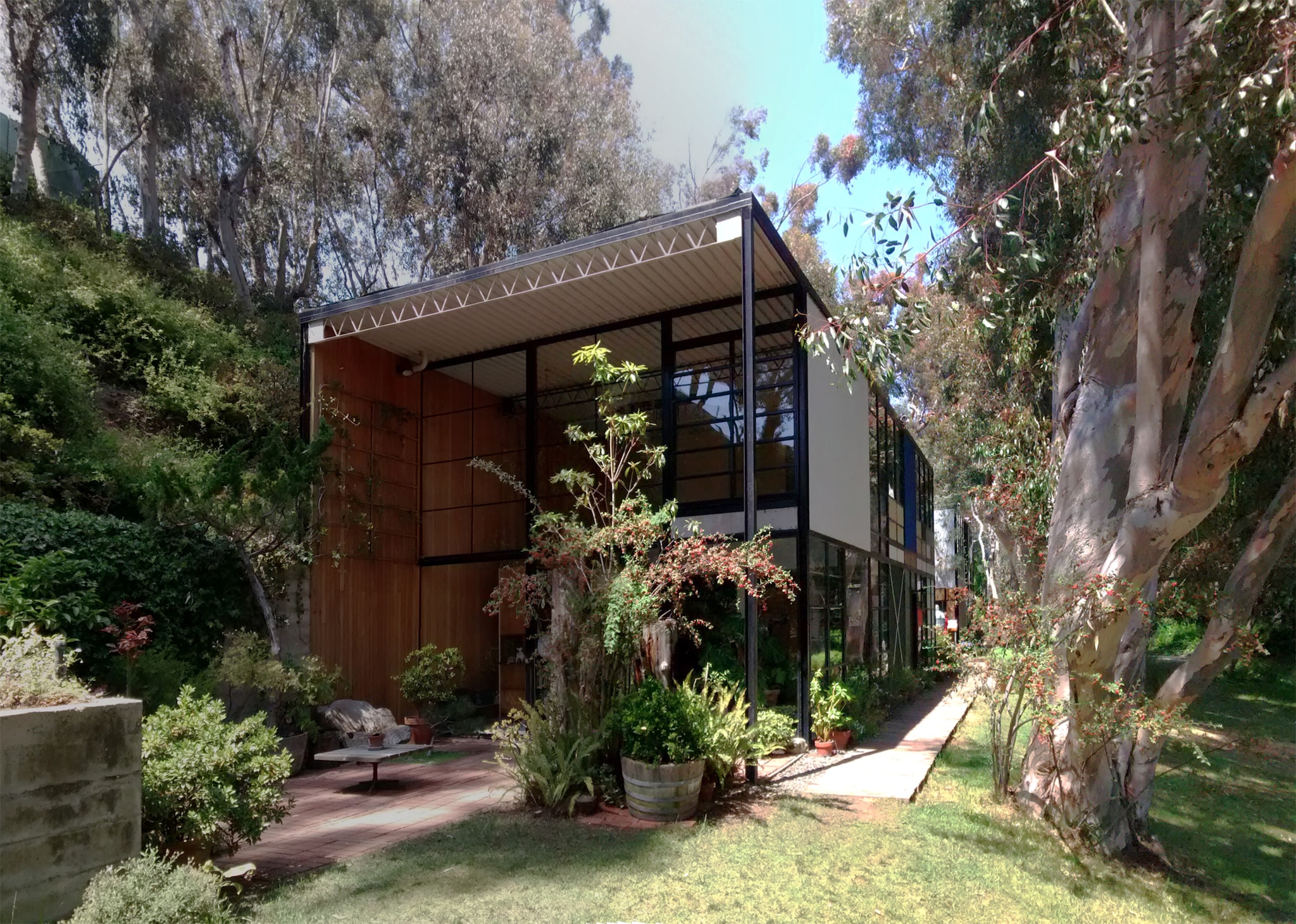
This project is the result of a series of experimental dwellings - this is Case Study House No. 8 - promoted by the American magazine Arts & Architecture, to create modern, efficient and inexpensive model homes for a projected population boom after WWII. The Eames proposed a model that they made their own, since they ended up living and working in this house for all their lives. It is therefore a house-studio, composed of two orthogonal double-height volumes, aligned and separated by a small open courtyard, leaning against the crest of a hill on one side and overlooking a eucalyptus forest on the ocean on the other. The irregular composition of nature contains the “exact” one of architecture, made up of slender structures of prefabricated elements in visible metal, closed by “paged” surfaces with coloured opaque panelling and transparent glass, filtered by curtains, which can be opened and modulated to obtain a continuity between outside and inside. If on the one hand we are struck by the functional and technical experience that determines the volumetric, rigorous and graceful structure, on the other hand, we also experience a fantastic vision of free colours and shapes given, as well as by the furnishings and accessories, by the objects and works collected that complete and make the interior vital and ever-changing.
Opening image: Gunnar Klack
37
Frank O. Gehry
L. A. House, Santa Monica (USA), 1979
Domus 599 October 1979

This house is the manifesto and self-portrait of a radical thinker who opposed the sterile revival of historical styles and especially the emerging postmodernism. In the vast bourgeois but anonymous suburbs of Santa Monica, where neo-colonial style dwellings follow one another in an orderly and eclectic manner, and starting from a pre-existing house, Gehry realised an extension that aroused the discontent of the neighbourhood. It embraced a new linguistic register, with a new aesthetic of the unfinished, according to the non-styling of the building site. A collage of half-finished elements determined a new envelope for the entrance, as well as the living and leisure spaces. Wrapping the old living volume on three sides, old and new, solid and precarious, anonymous tradition and designer innovation meet and clash. Sheet metal, netting, plywood, exposed fixtures, salvaged pieces, non-orthogonal structures, joints that simulate improvisation, thus compose, in a way that was later also called “deconstructivism”, a new architecture as the “sum of the parts”, where the eye that glimpses distorted perspectives fails to grasp an ordered overall design and where the apparent disorder becomes a new expressive language that speaks of chaos and vitality all to be tamed.
Opening image: IK's World Trip
38
Lacaton and Vassal
Latapie House, Floirac (France), 1992-93
Domus 791 March 1997
When “minimalism” was becoming the new common language, after the hedonistic excesses of the 1980s, between hyper-decoration and high-tech, and the experimental and radical research of the 1970s, Lacaton & Vassal interpreted the search for the essence as a serene and conscious degrowth, both technical and aesthetic. They immediately achieved a result that in the following years became the standard and led them to be awarded a Pritzker prize. For a family with two children and a very limited budget, they designed a contemporary primitive hut, made with a metal structure that is the main volume and that can be filled with different modular and openable transparencies, and an internal wooden structure that traces the more private rooms. This simple and perfected sequence and layering of structures and elements offers the maximum with the minimum, making frugality, together with ethics and society, one of the most significant but often overlooked chapters of architecture.
Opening image: Philippe Ruault
39
Rem Koolhaas
Villa Dall’Ava, Paris (France), 1986-91
Domus 736 March 1992

The house (by Rem Koolhaas) is located in a low-density residential neighbourhood rich in vegetation, on the slope of a gentle hill from which one can admire Paris’ city centre. To provide a tree-lined view, the elongated, sloping trapezoidal building has an articulated and asymmetrical layout, where two transversal volumes suspended on revised and stacked pilasters house the parents’ and daughter’s bedrooms, staggered to allow the view, through the typical “ribbon windows”, on the city centre. A central longitudinal body, like a structural blade perpendicular to the street, connects and contains the communal, glass wall living room, while the roof houses a special swimming pool that cannot be seen from the ground floor. The garden was designed by Yves Brunier while the interiors were curated by Petra Blaisse, in a continuous unicum of structure, volumes, paths, surfaces, nature. These are the years when post-postmodernity was first being revisited according to new canons that contemplated the complexity of things.
Opening image: Dimitra Sapanidou
40
Herzog & De Meuron
Apartment Building, Basel (Switzerland), 1991-93
Domus 756, January 1994
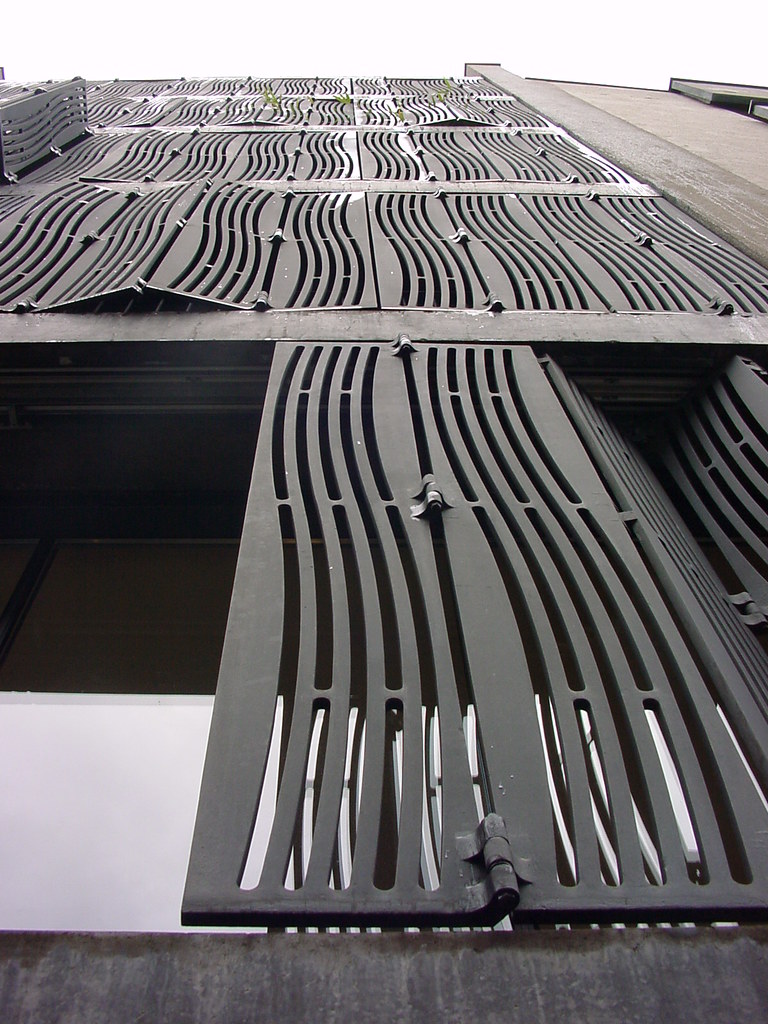
In a long and narrow Gothic parcel within the city’s medieval perimeters, this apartment building apparently develops on the recomposition of a void in which the façade communicates its internal development. Starting from this degree of constraint, which is transformed into a degree of freedom, the architects provocatively adopt a typical element of the street - the module with the sinuous design characteristic of manholes - to layout a heavy cast-iron curtain that closes and opens like a book, to filter light or protect from the outside view. Inside, the bare, longitudinal spaces are divided into two areas around a small courtyard overlooking a side garden, thus becoming a sloping cavedium that offers the best interior lighting.
Opening image: Detlef Schobert
41
John Pawson
Pawson House, London (UK), 1997-99
Domus 821, December 1999

From the outside, this house looks like a typical long and narrow “English lot”, in which usually the rooms develop around air shafts and steep stairs. Pawson, on the other hand, took the whole space, emptied it and redesigned it, linearly unfolding a minimal staircase on one side, which is lit by a zenithal skylight and adds light to the entrances of the rooms on each floor. After an entrance on the living room and terrace, going up we reach two upper floors of bedrooms and offices, while going down a few steps we discover a lower floor in which the living area extends, seemingly without solution of continuity, towards a small garden which, given the seamlessness of the furnishings, integrates and multiplies the living space between inside and outside.
42
Toyo Ito
White U House, Tokyo (Japan), 1975-76
Domus 1008, December 2016

White U House is a home for the architect’s sister, who had recently lost a loved one and wanted to live isolated for a while, in an ideal embrace offered by an intimate, introverted and introspective U-shaped dwelling that sought a relationship with the sky, the earth and nature to be cared for in order to flourish. The architecture here is a portrait of the inner landscape of the person inhabiting the house, with the primary functions placed in the linear spaces and the curvilinear - and tense - space left free to be inhabited by daily thoughts and activities. After a long period of grieving, the house was voluntarily and consensually demolished.
Opening image: OfHouses
43
Kazuyo Sejima
Forest House, Tateshina (Japan), 1992-94
Domus 771 May 1995
The round is the shape which, although perfect in its continuity, most makes one lose orientation in a context such as a forest, in which one feels immersed the moment one loses contact with its edges. This is the primary form chosen to design a house that, like an enlarged section of a tree - also circular - with branches radiating out from the centre, would also house an exhibition space for contemporary art. Around this eccentric “void” that enhances the interior space, communal activities take place while the entrance, a terrace, a balcony, a light well and a bathroom radiate and weave into the nature that embraces the architecture from the outside.
Opening image: Shinkenchiku-sha
44
Ryue Nishizawa
Moriyama House, Tokyo (Japan), 2002-05
Domus 888 January 2006
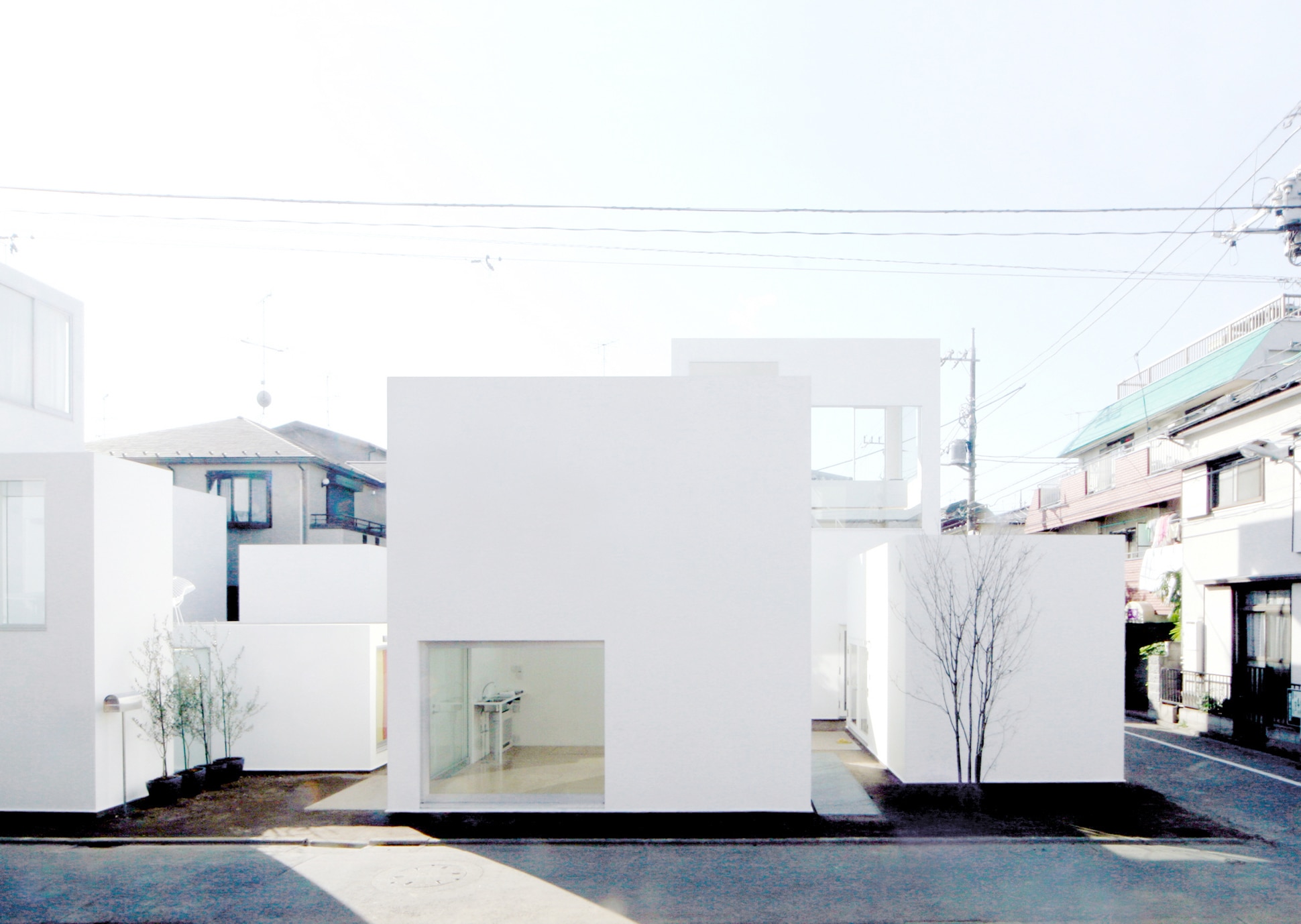
Here, the traditional idea of the compact dwelling explodes and expands into an urban chessboard in which to play with the rhythms of daily life. With some exceptions to the rule, each small volume is a minimal space for each individual activity - the kitchen, the living room, the study, the bathrooms, the laundry and the bedrooms all are isolated function-spaces connected by viewpoints or direct passages, in an integrated interweaving of solids (living spaces from the underground to the upper floors) and voids (gardens, courtyards, paths) organic to one another. Moriyama San lives in some of these spaces, while the others are temporarily rented in order to make the life of these “mono-environmental” dwellings always responsive and vibrant.
Opening image: Norimichi Kasamatsu
45
Sou Fujimoto
House N, Oita (Japan), 2007-08
Domus 917 September 2008
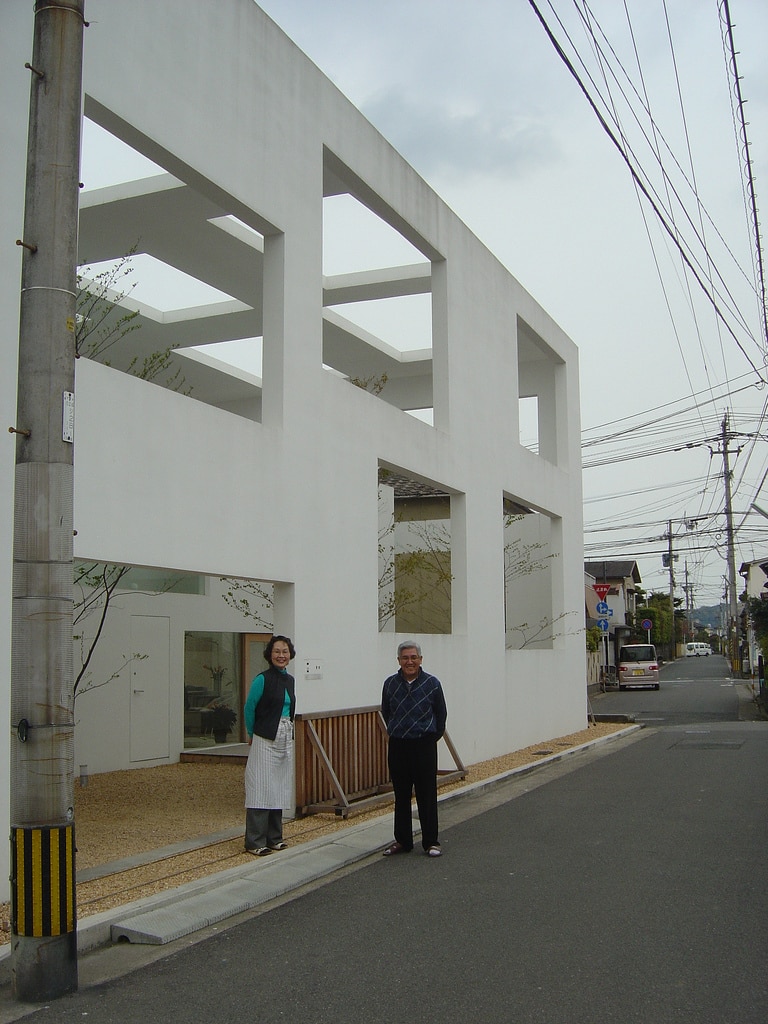
One way to reinterpret the architectural box is to play with the idea of content and container. In a spatial succession in which the core is dedicated to the living room, a frame is destined to the bedroom and a crown is dedicated to the garden, this dwelling separates and sequences functions with an abstract permeability made up of squares and cutouts of three solid parallelepipeds of white reinforced concrete. These shells determine a continuous alternation of intervals in an uninterrupted “spatial relationality” between the idea of the inside and the outside, while a three-dimensional depth closes or opens filtered by the rectangular openings made in the containers and never aligned, but in whose glimpses one can spot the inside, or from which the outside intrudes.
Opening image: Eduardo Pintos
46
Christian Kerez
House With One Wall, Zürich (Switzerland), 2005-07
Domus 912 March 2008
Normally, we link the idea of walls to the idea of division, separation and isolation. Instead, for this architecture, the wall means also sharing. The load-bearing structure of this two-family residential architecture is a “simple” central, mighty, serpentine wall. This results in an alternation of concave spaces to which correspond an equal number of convex spaces. At the same time, this allows the ceilings to hover over the landscape. The layout is vertical and occurs through three flights of stairs that follow the broken course of the polygonal line and lead to the three floors. The entrance and the office are on the ground floor, the living room and kitchen are on the second floor, and the bedrooms are on the third. The thick, exposed concrete wall has no transparency and also contains all the necessary installations, while the outer envelope of this facetted volume with an irregular hexagonal plan is totally transparent, and can only be concealed by white curtains.
Opening image: Walter Mair
47
Aires Mateus
House in Monsaraz, Alentejo (Portugal), 2007-18
Domus 1043 February 2020
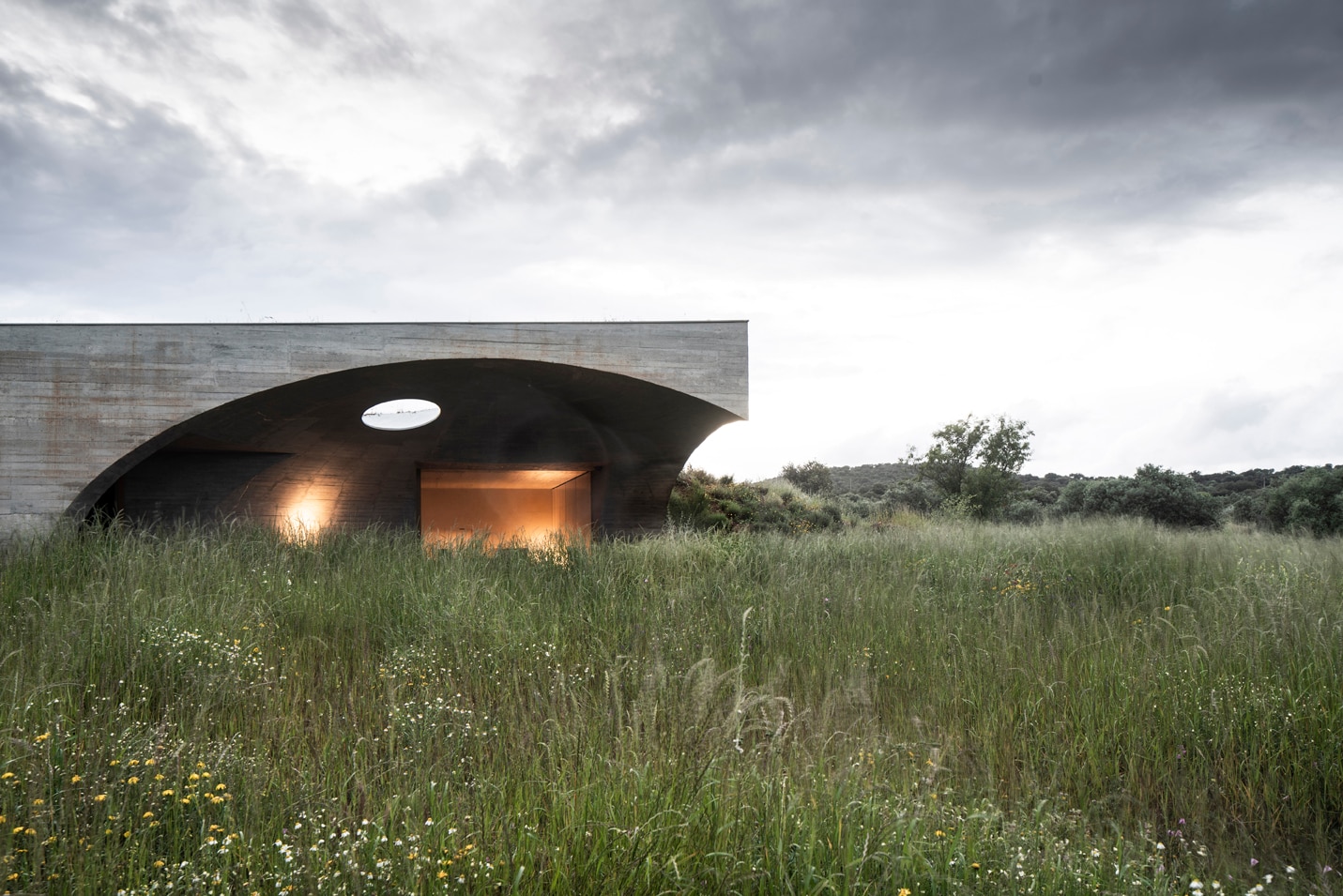
Living in a contemporary cave brings the human being back in touch with the primary activities of life, its flowing in relative time and in its simplest and most direct forms. This semi-hypogean house (by Aires Mateus) is located next to an artificial lake that submerged several depressions and is slowly changing the environmental conditions of a region where heat and aridity result in unique vegetation. From the outside, the house is almost invisible, while inside, purely shaped spaces gather around a clear dome, half-open towards the landscape and under which the lake, which is naturally a place of new life, can be observed.
Opening image: Aires Mateus
48
Valerio Olgiati
Villa Além, Alentejo (Portugal), 2009-14
Domus 988 February 2015
A primordial enclosure isolates an inner oasis from the rural and hilly landscape. High border walls of rocky-red exposed concrete have minimal openings and soar free like an open box, bending to shade living quarters. Inside, an enclosed garden with plants and a linear pool overlook a dwelling that gravitates around a living room and a studio. These spaces are circumnavigated by a shady, continuous semicircular corridor, leading to the three sleeping rooms, each with an independent patio. Each room receives light from zenithal openings, inscribed in ellipses of different sizes, but aligned on a single orientation along which the solar projections of these protected open spaces orbit.
Opening image: Valerio Olgiati / Olgiati archive
49
Architecten De Vylder Vinck Taillieu
House BM, Ghent (Belgium), 2007-11
Domus 954, January 2012

Each residential project for this studio is an opportunity to carry out research on an architectural theme, tackled by inventing the tools for investigating the stratification of domestic spaces and consequently with a new language for each new technical and aesthetic message. The aim is to break free from pre-established methods in order to build a new context everytime, and not just start from it. This is a house in a forest, and it is simultaneously a forest in a house. Thanks to a circular floor plan made up of broken lines, a sequence of rooms with double transparent overlooks chases and meets each other again after a turn, creating an “open interior” and, reversing the meaning of its opposite, a “closed exterior” given by the forest - the existing element in nature most similar to architecture - surrounding the building.
Opening image: Filip Dujardin
50
OFFICE Kersten Geers David Van Severen
Weekend House, Merchtem (Belgium), 2009-12
Domus 964, December 2012
In the long, narrow garden of a small existing vertical (guest)house on the street, a new idea of a horizontal house unfolds with four identical spaces characterised by different uses (and customs): a courtyard, a swimming pool with a pool house, a living room with bed, kitchen and table, and a garden. Above the central spaces, a sliding roof with transparent pitches opens and closes the rooms for summer and winter living, and the sequence of individual functions, made up of movable walls, equipment and accessories, is not limited to existenzminimum but invites the direct and conscious use of everything, however little, that is really needed.
Opening image: Bas Princen


